






GROUP DOUBLES DOWN IN AUSTRALIA AS PIPELINE PROJECTS BOOM – 10

Work with a team that understands e ective risk management is the

› Pigging
› Inline Inspection
› Live line dig ups
› NDT, including verification by phased array
› Leak detection
› Welding and field joint coating repair
› NATA pressure testing up to 70,000 kPa

› Flexible set-ups for remote and limited footprint locations
› Fast emergency response
Taddam: 0432 666 917 taddam@pipetek.com.au
Myles: 0417 707 729 myles@pipetek.com.au
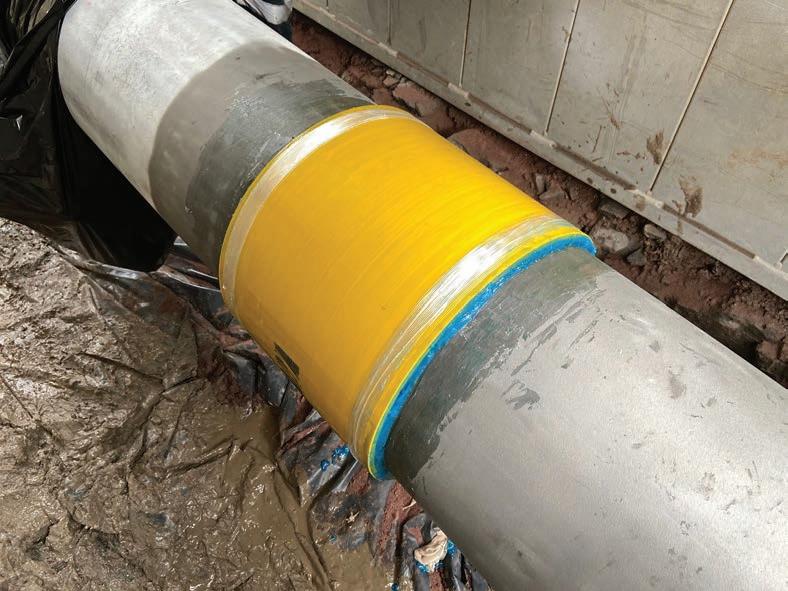
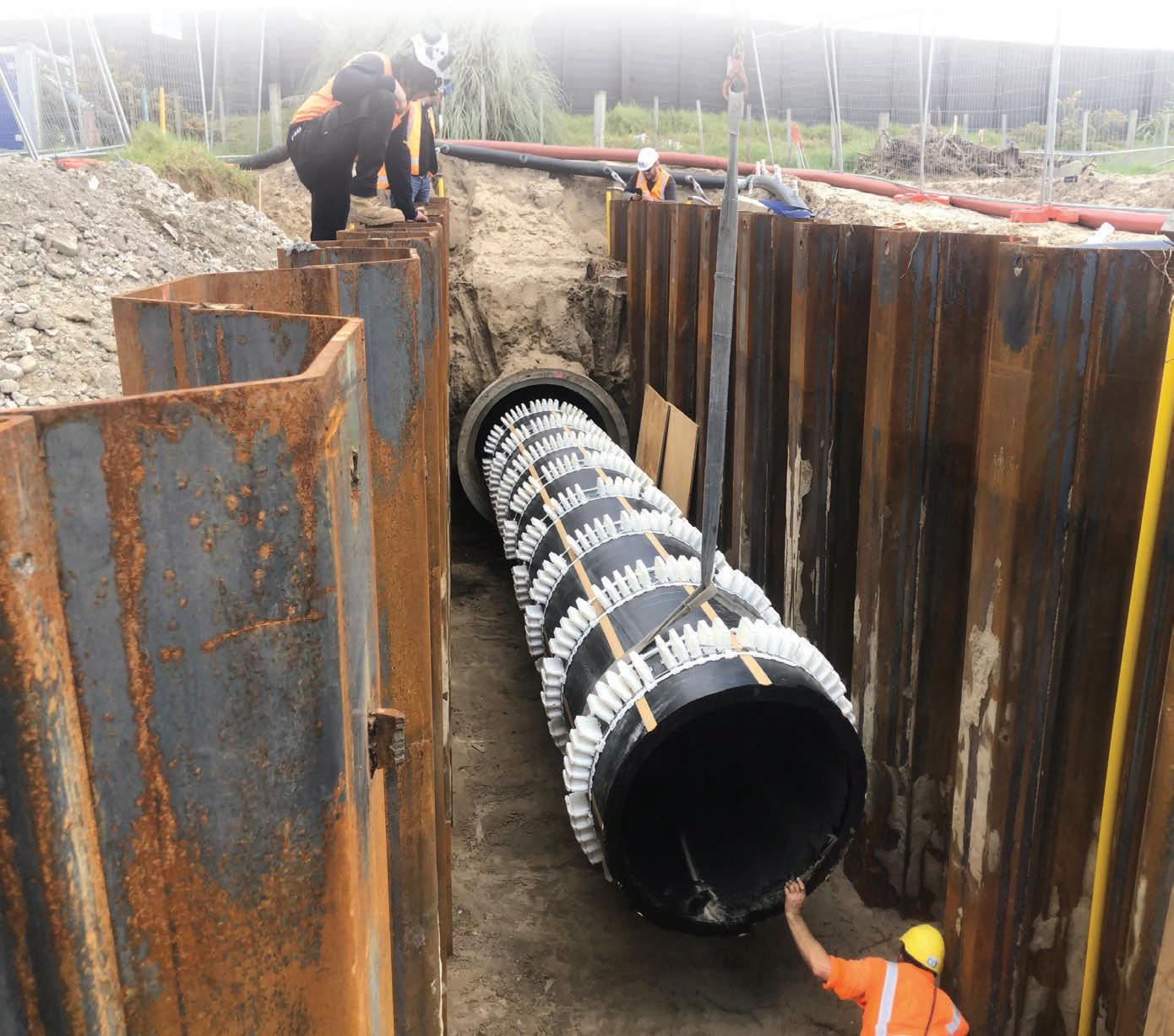
|
EXCAVATORS |
|
‘Everything we do begins and ends with our customers’
‘Everything we do begins and ends with our customers’
‘Everything we do begins and ends with our customers’
‘Everything we do begins and ends with our customers’
‘Everything we do begins and ends with our customers’
|
‘Everything we do begins and ends with our customers’
- Michael Benson, Austrack MD
- Michael Benson, Austrack MD
- Michael Benson, Austrack MD
- Michael Benson, Austrack MD
- Michael Benson, Austrack MD
‘Everything we do begins and ends with our customers’
‘Everything we do begins and ends with our customers’
‘Everything we do begins and ends with our customers’
‘Everything we do begins and ends with our customers’
‘Everything we do begins and ends with our customers’
- Michael Benson, Austrack MD
‘Everything we do begins and ends with our customers’
‘Everything we do begins and ends with our customers’
‘Everything we do begins and ends with our customers’
‘Everything we do begins and ends with our customers’
‘Everything we do begins and ends with our customers’
- Michael Benson, Austrack MD
- Michael Benson, Austrack MD
‘Everything we do begins and ends with our customers’
- Michael Benson, Austrack MD
- Michael Benson, Austrack MD
- Michael Benson, Austrack MD
- Michael Benson, Austrack MD
- Michael Benson, Austrack MD
- Michael Benson, Austrack MD
Managing the building of major pipelines is challenging, complicated and expensive.
- Michael Benson, Austrack MD
Managing the building of major pipelines is challenging, complicated and expensive.
- Michael Benson, Austrack MD
Managing the building of major pipelines is challenging, complicated and expensive.
- Michael Benson, Austrack MD
Managing the building of major pipelines is challenging, complicated and expensive.
- Michael Benson, Austrack MD
Managing the building of major pipelines is challenging, complicated and expensive.
Managing the building of major pipelines is challenging, complicated and expensive.
Managing
Managing the building of major pipelines is challenging, complicated and expensive.
Managing the building of major pipelines is challenging, complicated and expensive.
One call to Austrack and instantly WE become part of YOUR team. We save you all the stress involved with hiring equipment.
Managing the building of major pipelines is challenging, complicated and expensive.
Managing the building of major pipelines is challenging, complicated and expensive.
Managing the building of major pipelines is challenging, complicated and expensive.
One call to Austrack and instantly WE become part of YOUR team. We save you all the stress involved with hiring equipment.
Managing the building of major pipelines is challenging, complicated and expensive.
Managing the building of major pipelines is challenging, complicated and expensive.
One call to Austrack and instantly WE become part of YOUR team. We save you all the stress involved with hiring equipment.
One
Managing the building of major pipelines is challenging, complicated and expensive.
Managing the building of major pipelines is challenging, complicated and expensive.
One call to Austrack and instantly WE become part of YOUR team. We save you all the stress involved with hiring equipment.
Managing the building of major pipelines is challenging, complicated and expensive.
One call to Austrack and instantly WE become part of YOUR team. We save you all the stress involved with hiring equipment.
One call to Austrack and instantly WE become part of YOUR team. We save you all the stress involved with hiring equipment.
Managing the building of major pipelines is challenging, complicated and expensive.
One call to Austrack and instantly WE become part of YOUR team. We save you all the stress involved with hiring equipment.
One call to Austrack and instantly WE become part of YOUR team. We save you all the stress involved with hiring equipment.
Our people bring ‘at the coalface’ hands on experience to get your project moving.
Our fleet of 300+ machines and 700+ attachments can deploy to anywhere in
Our fleet of 300+ machines and 700+ attachments can deploy to anywhere in
Our fleet of 300+ machines and 700+ attachments can deploy to anywhere in
Our fleet of 300+ machines and 700+ attachments can deploy to anywhere in
Our fleet of 300+ machines and 700+ attachments can deploy to anywhere in Australia
One call to Austrack and instantly WE become part of YOUR team. We save you all the stress involved with hiring equipment.
Our people bring ‘at the coalface’ hands on experience to get your project moving.
One call to Austrack and instantly WE become part of YOUR team. We save you all the stress involved with hiring equipment.
Our people bring ‘at the coalface’ hands on experience to get your project moving.
One call to Austrack and instantly WE become part of YOUR team. We save you all the stress involved with hiring equipment.
Our
One call to Austrack and instantly WE become part of YOUR team. We save you all the stress involved with hiring equipment.
Our people bring ‘at the coalface’ hands on experience to get your project moving.
One call to Austrack and instantly WE become part of YOUR team. We save you all the stress involved with hiring equipment.
One call to Austrack and instantly WE become part of YOUR team. We save you all the stress involved with hiring equipment.
One call to Austrack and instantly WE become part of YOUR team. We save you all the stress involved with hiring equipment.
Our fleet of 300+ machines and 700+ attachments can deploy to anywhere in Australia
Our people bring ‘at the coalface’ hands on experience to get your project moving.
One call to Austrack and instantly WE become part of YOUR team. We save you all the stress involved with hiring equipment.
One call to Austrack and instantly WE become part of YOUR team. We save you all the stress involved with hiring equipment.
Our people bring ‘at the coalface’ hands on experience to get your project moving.
Our people bring ‘at the coalface’ hands on experience to get your project moving.
Our people bring ‘at the coalface’ hands on experience to get your project moving.
We have you covered on all fronts with:
Our people bring ‘at the coalface’ hands on experience to get your project moving.
Our people bring ‘at the coalface’ hands on experience to get your project moving.
We have you covered on all fronts with:
We have you covered on all fronts with:
Our people bring ‘at the coalface’ hands on experience to get your
Our people bring ‘at the coalface’ hands on experience to get your project moving.
We have you covered on all fronts with:
• Reliable equipment
• Reliable equipment
• Reliable equipment
Our people bring ‘at the coalface’ hands on experience to get your project moving.
We have you covered on all fronts with:
• Reliable equipment
Our people bring ‘at the coalface’ hands on experience to get your
• Best Brands
• Best Brands
Our people bring ‘at the coalface’ hands on experience to get your project moving.
Our people bring ‘at the coalface’
• Best Brands
• Best Brands
Our people bring ‘at the coalface’ hands on experience to get your project moving.
We have you covered on all fronts with:
We have
We have you covered on all fronts with:
We have you covered on all fronts with:
• Superior service
We
• Superior service
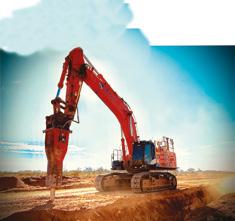


We have you covered on all fronts with:
•
• Superior service
• Reliable equipment
We have you covered on all fronts with:
We have you covered on all fronts with:
• Superior service
• Reliable equipment
• Reliable equipment
• Putting safety first
•
• Putting safety first
• Putting safety first
• Best Brands
•
•
• Reliable equipment
•
• Best Brands
• Reliable equipment
• Putting safety first
• Best Brands
• Reliable equipment





•
• Best Brands
• New technology
•
• New technology
• New technology

• Best Brands
• New technology
•
• Superior service
• Superior service
• Great Rates
• Great Rates
• Great Rates
• Superior service
• Superior service
• Putting safety first
• Superior service
• Putting safety first
• Putting safety first











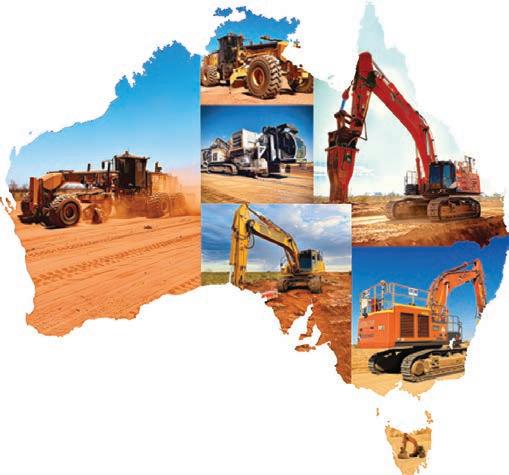





• Putting safety first
•
•
•
•
• Putting safety first
• Putting safety first
• Putting safety first








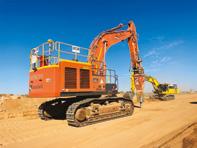




• New technology
•
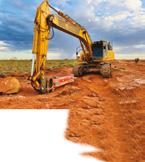






• New technology
• New technology
•
•
• Great Rates


















• Great Rates
• Great Rates
•








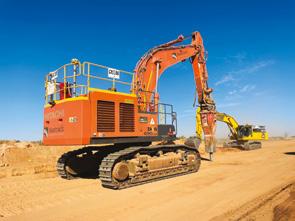
















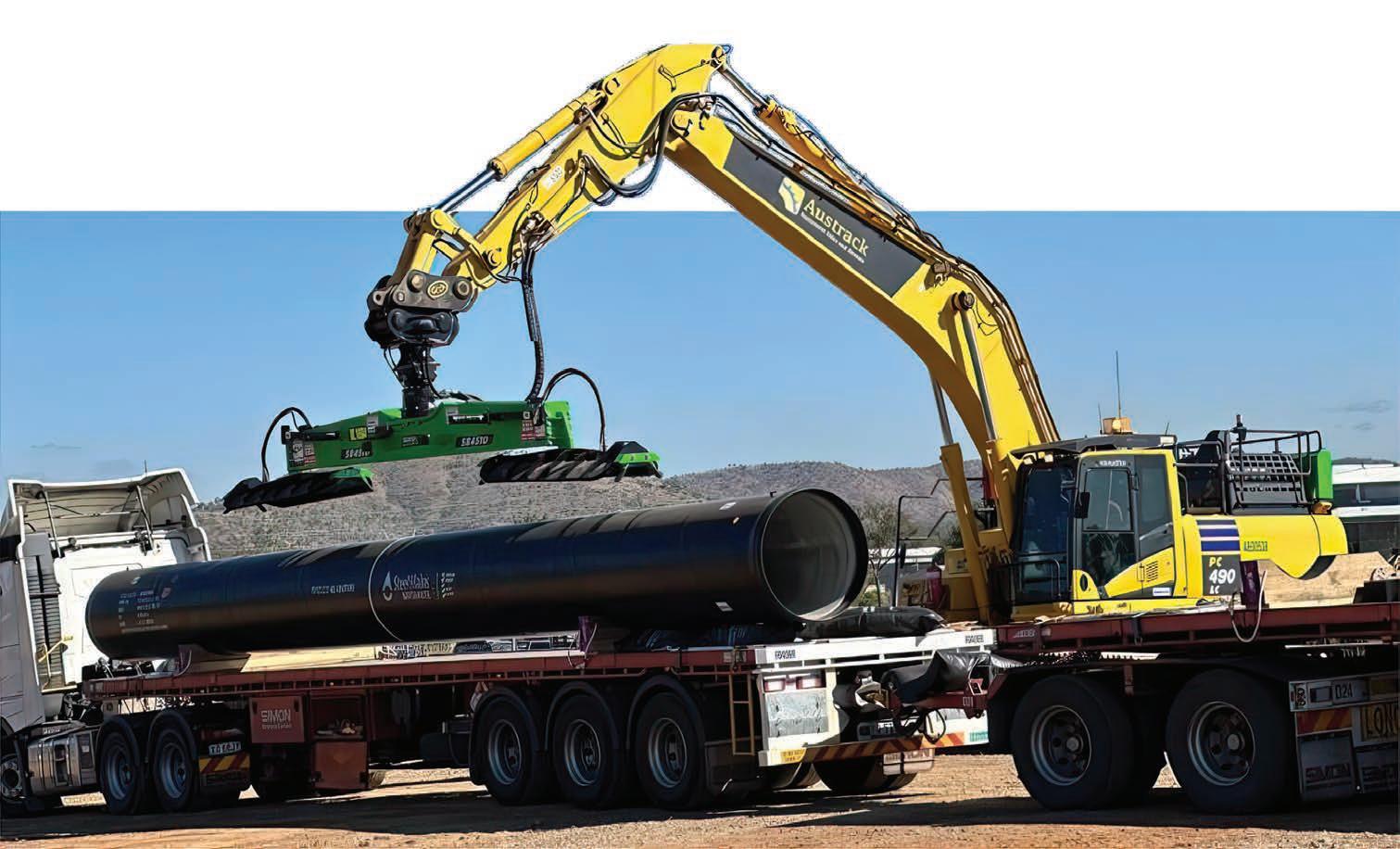













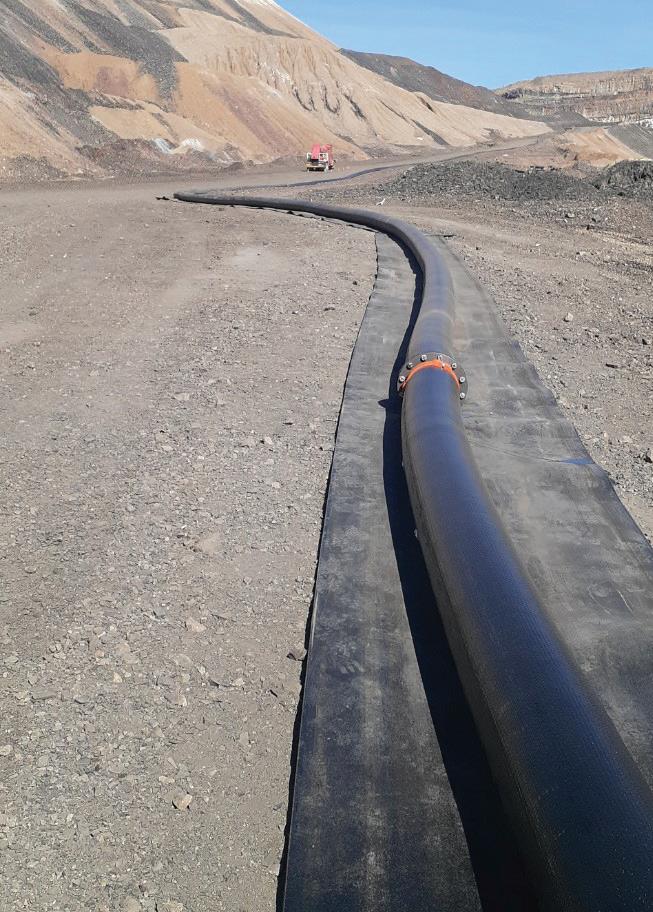

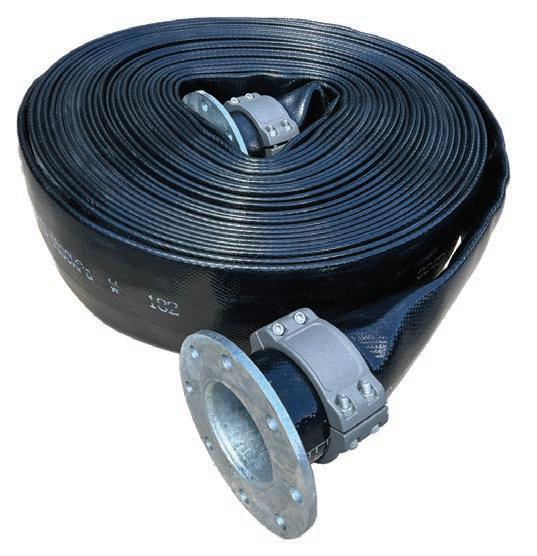

CEO
John Murphy COO
Christine Clancy christine.clancy@primecreative.com.au
MANAGING EDITOR
Molly Hancock molly.hancock@primecreative.com.au EDITOR
Timothy Bond tim.bond@primecreative.com.au
JOURNALIST
Vivien Topalovic vivien.topalovic@primecreative.com.au
BUSINESS DEVELOPMENT MANAGER
Jake Niehus
jacob.niehus@primecreative.com.au
ART DIRECTOR
Michelle Weston michelle.weston@primecreative.com.au
HEAD OF DESIGN
Blake Storey blake.storey@primecreative.com.au
DESIGNER
Daniel Truong
COPYRIGHT
The Australian Pipeliner is owned by Prime Creative Media and published by John Murphy. All material in The Australian Pipeliner is copyright and no part may be reproduced or copied in any form or by any means (graphic, electronic or mechanical including information and retrieval systems) without written permission of the publisher. The Editor welcomes contributions but reserves the right to accept or reject any material. While every effort has been made to ensure the accuracy of information, Prime Creative Media will not accept responsibility for errors or omissions or for any consequences arising from reliance on information published. The opinions expressed in The Australian Pipeliner are not necessarily the opinions of, or endorsed by the publisher unless otherwise stated. © Copyright Prime Creative Media, 2021
All articles submitted for publication become the property of the publisher. The Editor reserves the right to adjust any article to conform with the magazine format.

Printed by: The Precision Group
83-89 Freight Drive, Somerton VIC 3062
Ph: (03) 9490 1500
The Australian Pipeliner brand comprises: six editions a year, a news website, a weekly e-newsletter, multiple social media platforms, an annual industry directory and an annual pipelines wallchart. Book an advertising and editorial package to gain access to our exclusive audience.
20,000+ website views each month 16,500+ e-newsletter subscribers
13,700+ social media followers magazine subscribers 3,300+
Want to find out more?
Contact our business development team to discuss how you can grow your business with The Australian Pipeliner. Call 0466 929 675 or email jacob.niehus@primecreative.com.au
Head Office
379 Docklands Drive, Docklands VIC 3008 Ph: (03) 9690 8766
Sydney Office Suite 303, 1-9 Chandos Street, Saint Leonards NSW 2065 Ph: (02) 9439 7227
enquiries@primecreative.com.au www.primecreative.com.au
The Australian Pipelines and Gas Association’s (APGA) vision is to lead the sustainable growth in pipeline infrastructure for Australasia’s energy. APGA is a non-profit organisation formed to represent the interests of its members involved in: the ownership, operation, maintenance, design, engineering, supply and construction of pipelines, platforms and all other structures used in or in connection with the drilling for, extraction and transmission of hydrocarbons, solids, slurries and similar substances both onshore and offshore. As a single voice representing the collective interests of its members, APGA is dedicated to encouraging the extension and development of the industry.
The Australian Pipeliner is the official journal of the Australian Pipelines and Gas Association (APGA) and is distributed to members without charge and circulated to interested organisations throughout Australia and overseas. It is also available on subscription. The publishers welcome editorial contributions from interested parties. However, neither the publishers nor APGA accept responsibility for the content of these contributions and the views contained therein are not necessarily the views of the publishers or APGA. Neither the publishers nor APGA accept responsibility for any claims made by advertisers. All communications should be directed to the publishers.
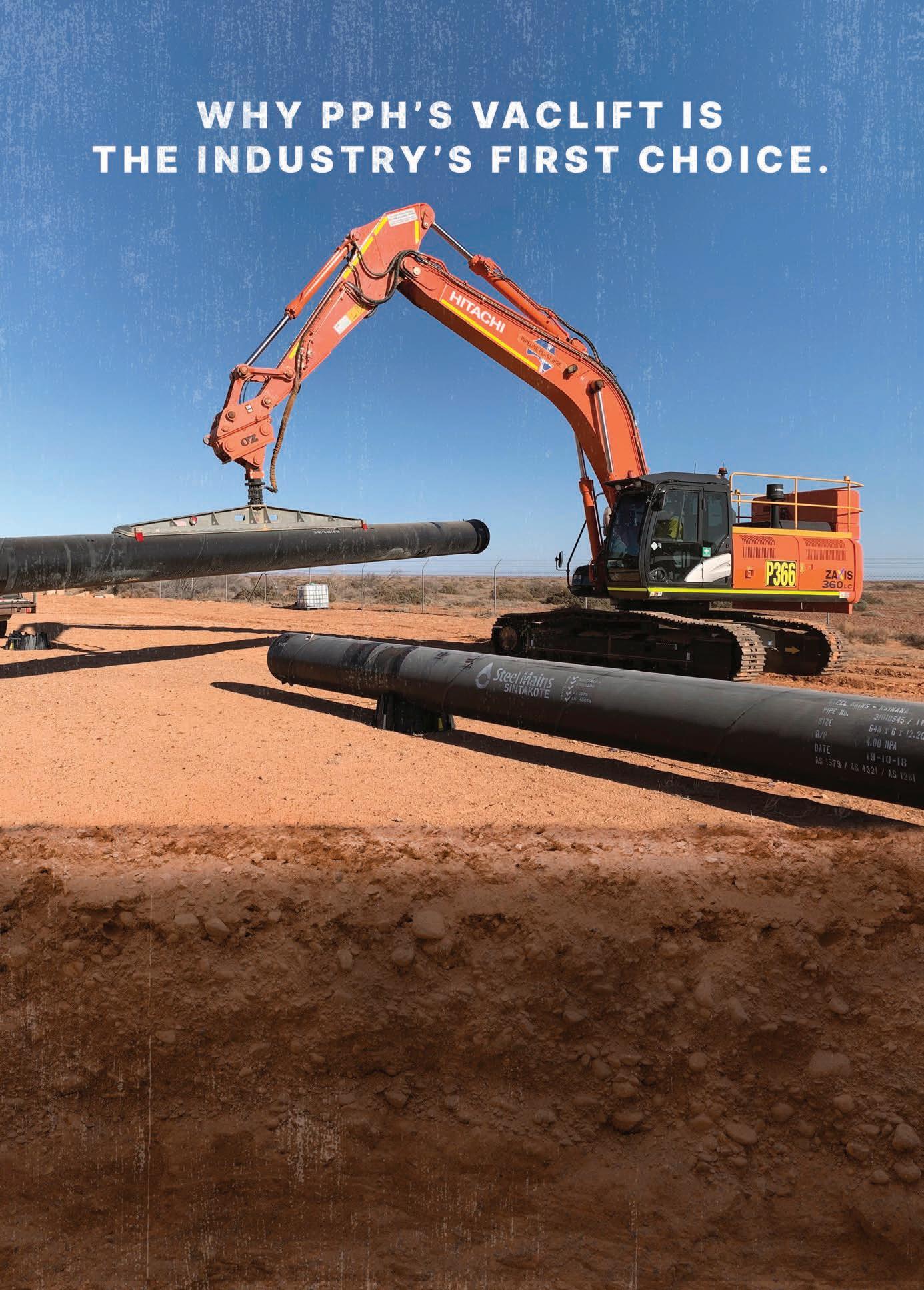
• First to move the vacuum reservoir from the excavator stick to the counterweight
• First to use the excavator hydraulics to power the vacuum pump
• First to remove radio remote control
• First to introduce dedicated excavator operator controls
• First to introduce 360˚ rotation
• First to develop an in-trench pipe assembly apparatus
• First to develop an hydraulically assisted multiple o ring jointed pipe assembly tool


• First to develop a remote controlled in pipe inspection tool
• First to develop a VacLift that will only release a pipe when the pipe is on a solid surface
• First to increase the range of diameters able to be handled by each pipe shoe
• First to develop a fully adjustable attachment pickup.
We know the industry better than anyone, talk to us about all your pipeline plant hire needs first.
Iam pleased to welcome you to the 2024 Convention and Exhibition edition of The Australian Pipeliner. I am also welcoming many of you to the beautiful city of Adelaide, where you can immerse yourself in insightful business sessions, network with industry peers, and explore this vibrant city.
We have prepared an enriching and informative program for the Convention, where members of our industry will provide invaluable insights into emerging trends, best practices, and future projections. As an industry, we thrive on collaboration, creative thinking, and the pursuit of excellence. Our keynote speakers, including Dean Boxall, following his team’s multiple gold medal triumphs in Paris, are a testament to our industry’s excellence. The soldout exhibition hall is a result of our collective efforts, a platform we have built to foster collaborations, share knowledge, and drive advancements within the pipelines and gas sector. Let’s take pride in what we have achieved together.
This edition features many of our exhibitors, focusing on providing NDT, pipeline equipment, integrity and maintenance services, HDD, and rehabilitation and repair.
Since my last President’s message, we have started to see a shift in the public debate as gas’ role in the energy transition is becoming more widely understood and accepted. We have continued to work diligently through our enhanced advocacy program, and the recent release of the Federal Government’s Future Gas Strategy is a strong demonstration of the changing narrative – an acknowledgement of the central role natural gas plays in firming renewables and powering our essential industries where alternative energy solutions are not yet available.
The Strategy also underscores the need for new gas supply sources to meet demand during Australia’s transition, requiring investment in new energy sources and its associated infrastructure. The recent announcement of Senex’s Atlas East Gas Project should encourage us that further investment is coming when delivered in the right policy environment where
we will all benefit from the unlocking and transporting of our abundant gas resources, especially in Queensland and regions such as the Beetaloo Basin.
Beyond gas infrastructure, I am sure most members are involved in ongoing and upcoming water pipelines and infrastructure. Several large water pipelines are being delivered in Queensland and New South Wales, and future ‘mega’ projects are planned in other states, including South Australia, where the Northen Water project will require a 600km pipeline to connect the Spencer Gulf to northern SA. As an industry, we transfer our skills and knowledge between sectors while always focusing on the safety of our people.
I want to thank the Secretariat for their efforts in preparing for the Convention and Exhibition, thank our exhibitors for committing their time and resources to share their latest innovations, technologies, and services, thank our speakers and presenters for taking the time to prepare and having the courage to stand up and share their knowledge and experience, congratulate the individuals and companies that have won Awards in recognition of their services to our industry and finally thank the membership as a whole for your commitment to the industry and Association. As APGA’s mission says, we look to foster innovation and collaboration, provide valued services, and represent the collective interests of our members. I hope your experiences here in Adelaide have delivered on this mission.
Stay safe, and I look forward to seeing you in Adelaide.

JOHN STUART-ROBERTSON APGA PRESIDENT

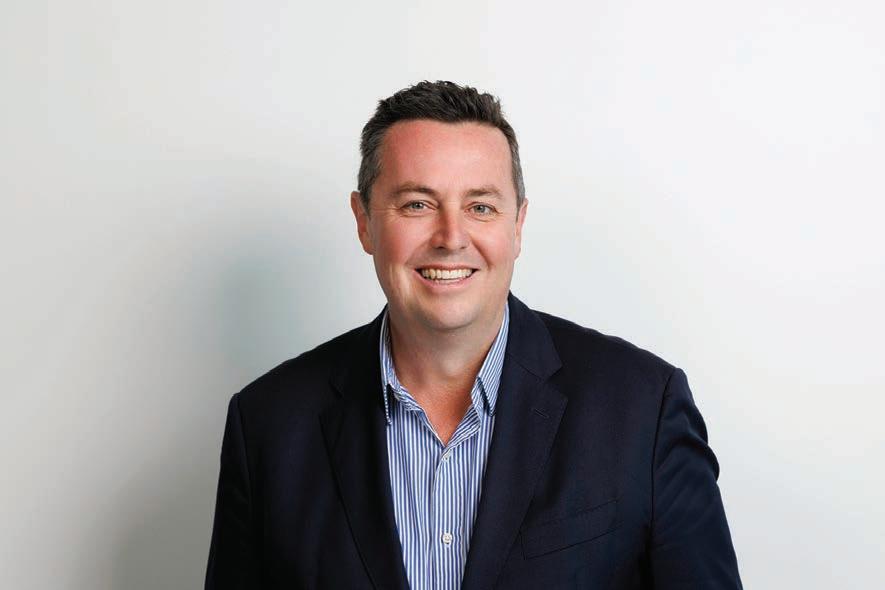
T: +61 2 6273 0577
E: apga@apga.org.au
W: www.apga.org.au
Chief Executive Officer
Steve Davies
Corporate Services Manager
Michelle Wickson
National Policy Manager
Jordan McCollum
Communications Manager
Lawrence Shelton
Engagement Manager
Gayle Burns
Membership Officer
Katy Spence
Policy Manager
Catriona Rafael
Government Relations Manager
Paul Purcell
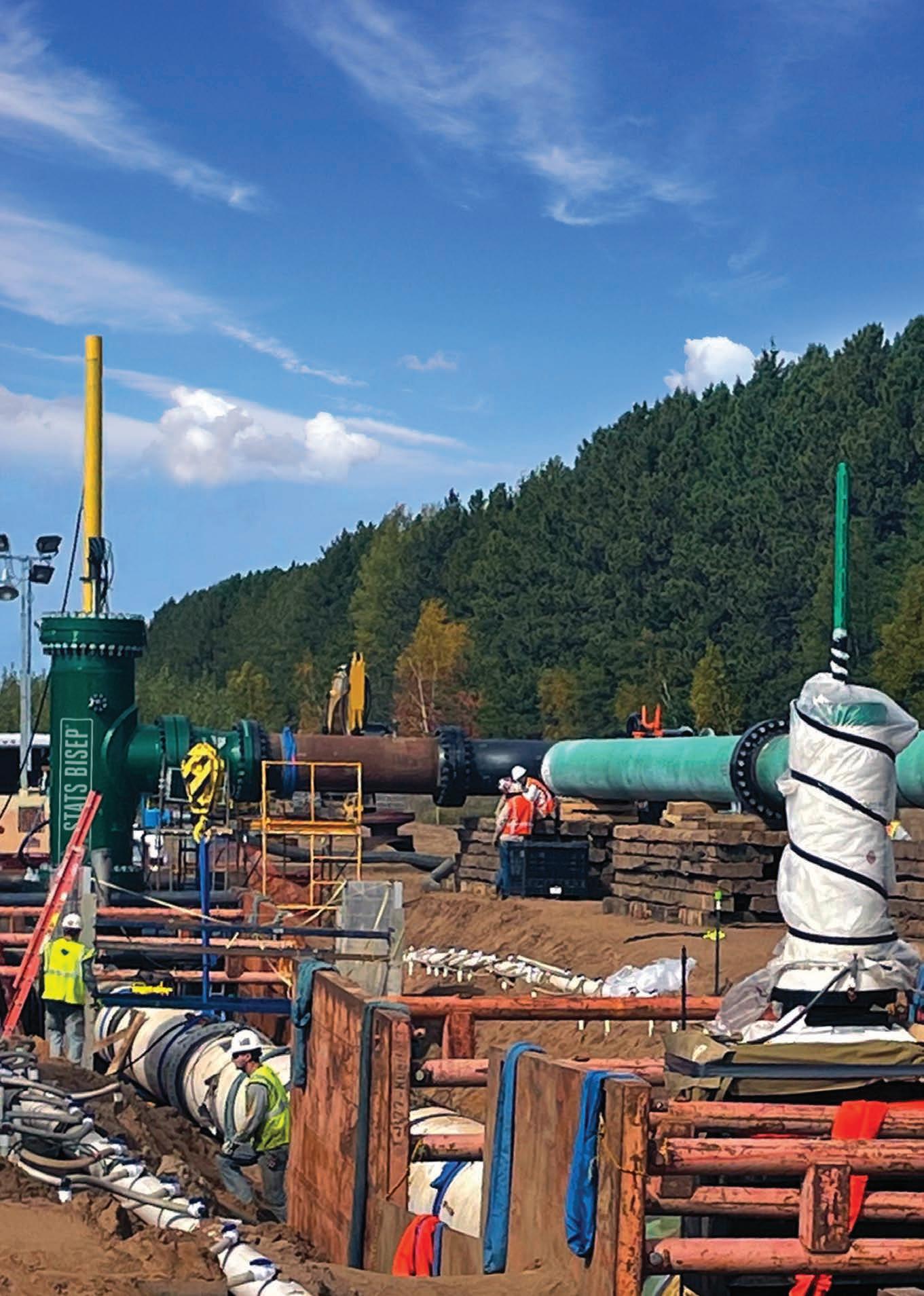


integrated bypass maintains production during isolation











Double Block & Bleed Isolation











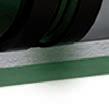






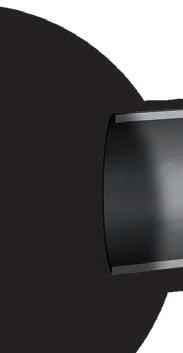
Isolated Pipeline














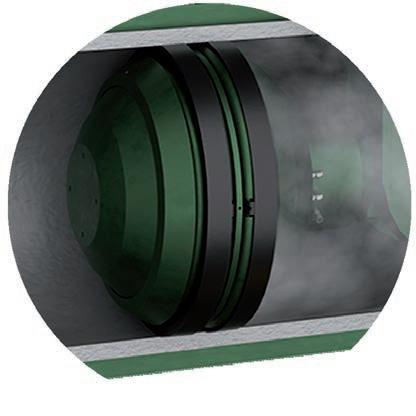

Monitored Zero-Energy Zone
The BISEP® has an extensive track record and provides pioneering double block and bleed isolation while
dual seals provide tested, proven and fully monitored leak-tight isolation, every time, any pressure.






revenue increasing to £75 million ($145 million) while earnings rose to £12.1 million ($23.4 million), its latest annual accounts show.
“The group has delivered an excellent trading result for the year, reflecting our ongoing commitment to develop and invest in localised operations in key international markets,” STATS Chief Executive Officer Stephen Rawlinson said.
year in all our markets.
“Revenue is anticipated to be higher than that achieved in 2023 and staff levels are again expected to increase to meet the anticipated growth in demand.”
As part of its localisation strategy and to help support growth in Australia and the wider Asia-Pacific (APAC) region, Hafiz Kareem recently joined STATS as Sales Manager APAC, based in Brisbane, Australia.
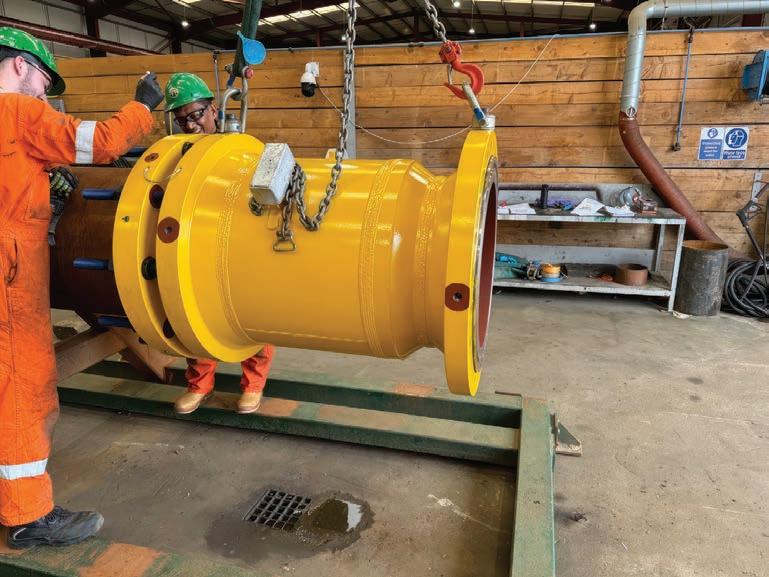
clients in the transition to a low carbon future,” Kareem said.
Paulo Basto has also joined the growing team as Operations Manager for the region based in Perth, Australia.
“STATS is a leading player in the pipeline intervention and isolation industry with a wide range of cutting-edge proprietary technologies, it’s an exciting time to join the company as they increase market share and grow its footprint in Australia,” Basto said.
STATS Regional Manager for APAC Gareth Campbell said the company recorded a number of important operational milestones.
“We have made significant progress establishing strong relationships in key markets, differentiated with our market leading technologies that will continue to drive future growth in market share,” he said.
The successful delivery of significant projects included a 24-inch launcher Door Plug and bespoke grabber tool for a client in the Bass Strait. The novel technology allowed the successful retrieval of an inline inspection (ILI) module from the pipeline.
The challenging project required equipment to be engineered that ensured the pipeline remained pressurised while the ILI module was recovered first time in a single deployment. The project returned the pipeline to a piggable condition, allowing essential cleaning and inspection activities to continue.
STATS recently manufactured a SureConnect subsea mechanical pipe connector for installation on a 24-inch pipeline offshore Brunei. Additionally, multiple isolation and intervention projects for onshore and offshore deployment have been conducted in Australia, Malaysia and Papua New Guinea, with the sale of BISEPs to an operator in New Zealand as part of a multi-year master service agreement.
As STATS continues to expand its presence in the region, its track record is quickly growing with work scopes also completed in Indonesia, Vietnam and China.
With global oil and gas operators looking to support the energy transition and net zero carbon emission targets, STATS is in a strong position to help clients repurpose existing assets and piping infrastructure for future use in hydrogen, carbon capture and storage (CCS) and other decarbonisation projects.
For more than 25 years, STATS has played a central role in numerous pipeline
that, in the future, may be repurposed.
APAC’s operators and contractors are looking to the future and exploring ways
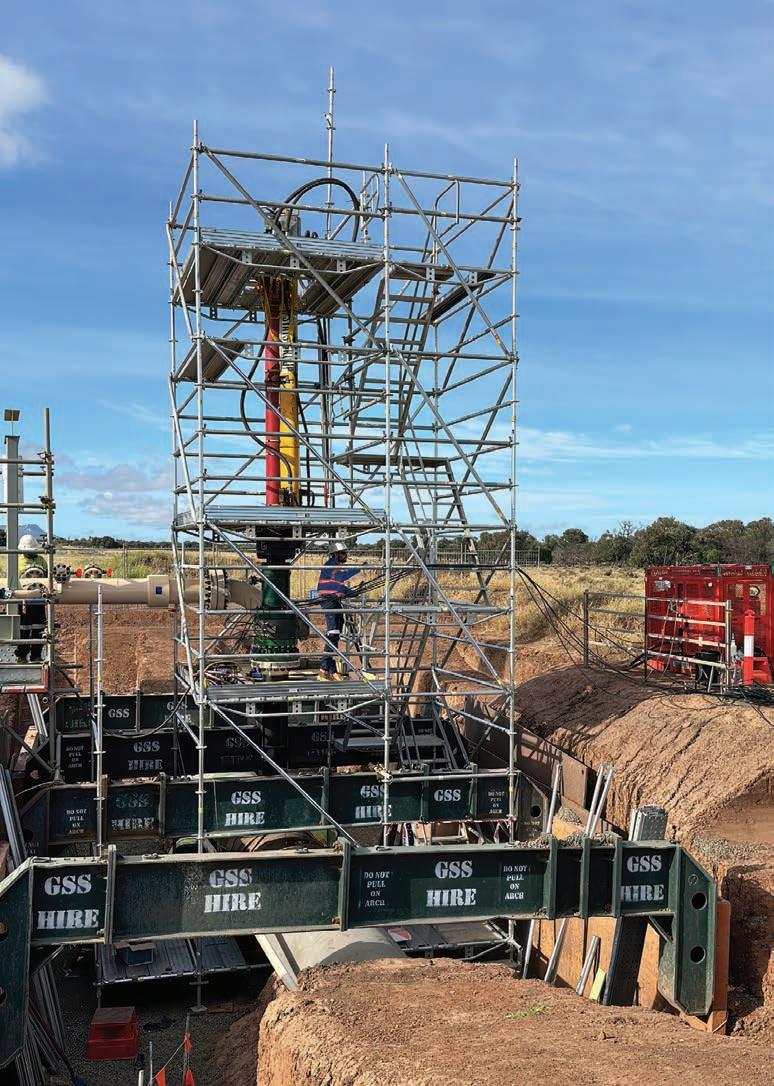
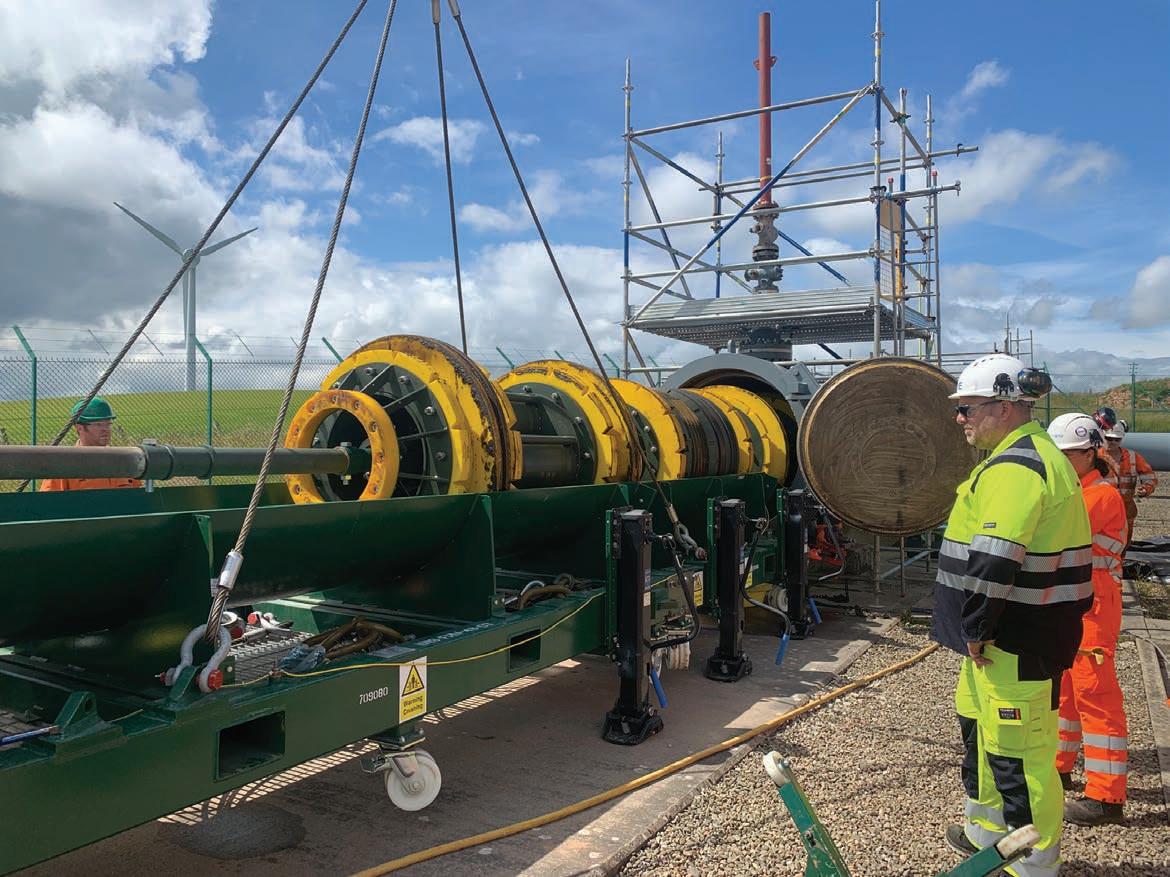
For more information, visit statsgroup.com
AEMO finally gets it – gas-powered generation is key to net zero
APGA National Policy Manager Jordan McCollum dissects AEMO’s latest report, which cements the critical role of gas in the energy transition.
Written by APGA National Policy Manager Jordan McCollum
After years of underestimating the need for gas-powered generation across the coming decades, the penny has finally dropped for the Australian Energy Market Operator (AEMO).
In its media release published alongside its Q2 2024 Quarterly Energy Dynamics report, the market operator stated:
“[Q2 2024] highlights the important role of flexible gas-powered generation as the ultimate backstop for the National Electricity Market (NEM) during periods of reduced renewable generation.”
To be fair, key people within AEMO have always known this, and modelling produced by AEMO has been demonstrating this fact more and more clearly over the last 24 months. But the market operator has appeared to be hesitant to publicly emphasize gas-powered generation’s crucial role.
This statement comes off the back of record renewable droughts which have led to a 20 per cent reduction in wind generation and an 18 per cent reduction in hydroelectric generation. At the same time, an increase in baseload coal generation saw NEM emissions increase year-on-year for the first time since FY2015.
Critical to energy security during this period was gas-powered generation which kicked in predominantly during the peak morning and evening demand periods. Had this gas-powered generation capacity not been available, the NEM could have been at serious reliability risk during this still, dry period.
Looking deeper into the data there were weeklong renewable generation droughts three to five times in the May to July window across each of the three south-eastern NEM regions. Three of these renewable droughts affected two or more states at the same time. This is aside from numerous two- to three-day windows of similar low renewable supply.
During each of these windows, it was predominantly gas power generation which stepped in to fill the supply gap and keep the lights on.
Of course, as Australia’s pipeline industry knows, gas-power generation doesn’t do this alone.

Amidst renewable droughts, gas power generation can fill the supply gap.
It’s the gas storage and throughput capacity of Australia’s pipeline networks that allows gaspowered generation to run hard when it’s needed and sit idle when it’s not, supplying relatively flat gas production profiles into highly variable generation demand.
With this context in mind, let’s turn the clock forward by a decade. The majority of the NEM’s coal generation fleet has retired, and we are left with a majority renewable generation NEM. Now the availability of gas-powered generation is critical.
Batteries and pumped hydro will support intraday and day-to-day time shifting of renewable supply respectively. But neither have the capacity to supply the NEM across five consecutive week-long renewable droughts, as seen in Q2 2024.
This is no longer a theoretical risk but a lived reality.
In a coal-less future, NEM reliability beyond a 48-hour window is solely the domain of gas-power generation. The capacity and flexibility of gas infrastructure enables generation to ramp in line with demand, while long-term underground gas storage and a robust gas market provides a source of enduring supply for weeks on end as required.
But this only happens if the necessary investment is committed this decade.
Gas-powered generation, while being critical to future NEM reliability, is excluded from every from of electricity subsidy today.
While the renewables and batteries required to replace coal on a good day received subsidies, the gas-powered generation to maintain supply on a bad day does not.
While every other form of electricity generation and infrastructure is subsidised, it will be virtually impossible for investments in new gas power generation to reach FID. This means one of two things to ensure necessary gas-powered generation investment occurs: governments need to either start subsidising gas-powered generation or stop subsidising everything else.
The AEMO Integrated System Plan identifies over 16GW of gas-powered generation will be required to firm the NEM into the future and notes:
“As coal-fired power stations retire, renewable energy connected with transmission and distribution, firmed with storage, and backed up by gas-powered generation is the lowest-cost way to supply electricity to homes and businesses through Australia’s transition to a net zero economy.”
Now is the time for state and federal governments to step up and ensure the necessary gas-powered generation investment occurs this decade. Else we may yet find out what happens if gas-powered generation isn’t there when the wind doesn’t blow, the sun doesn’t shine, and the rain doesn’t fall.

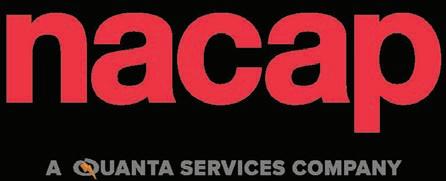







+61 2 6884 7878 (Dubbo) +675 321 1001 (Port Moresby)
Host Sponsors:








Sponsors:


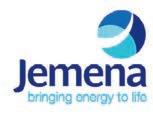







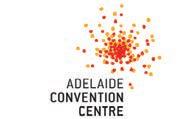


Major Sponsors:






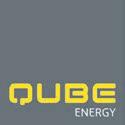





















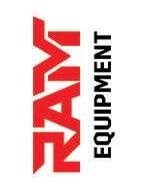







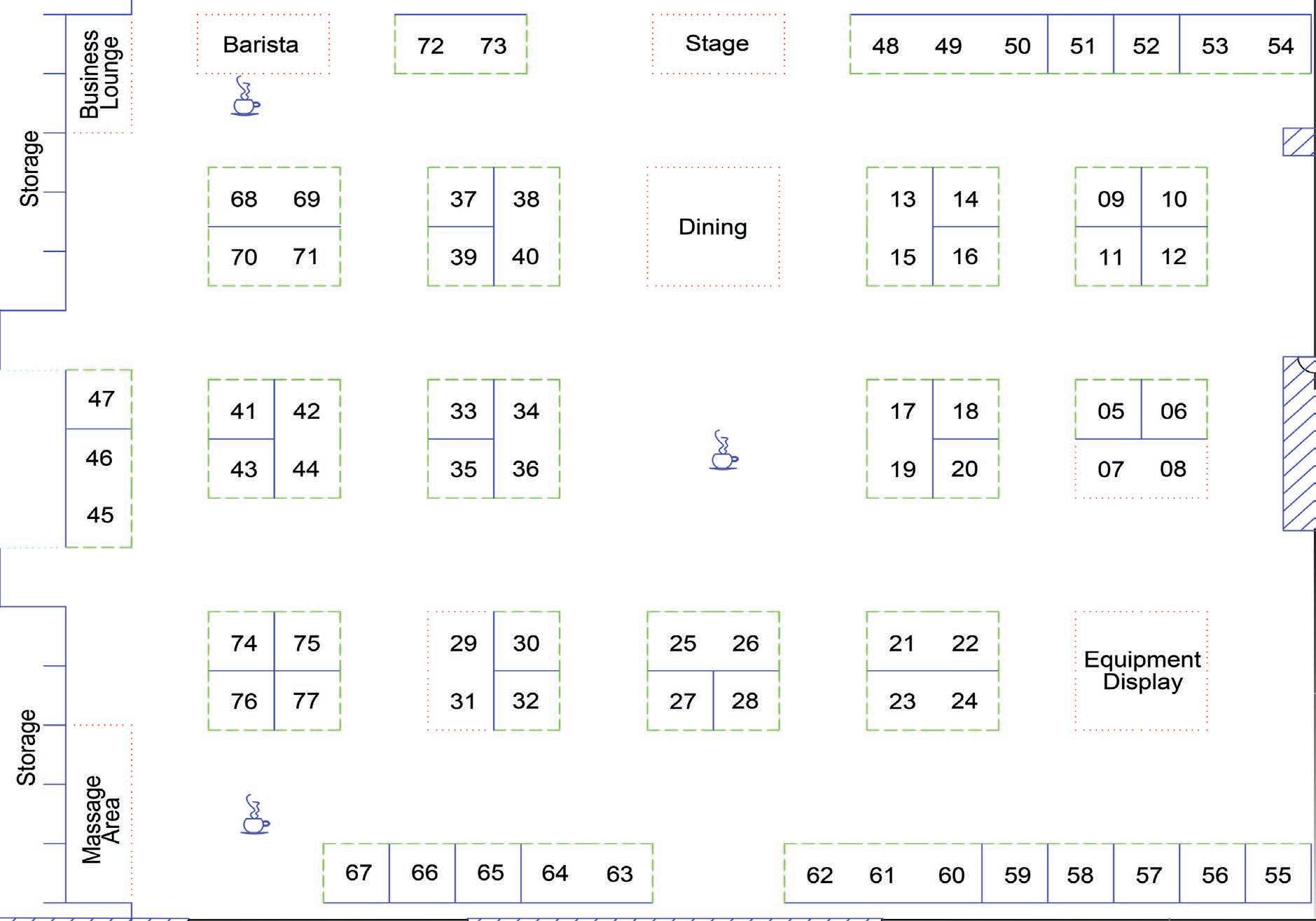
















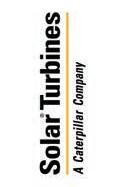

















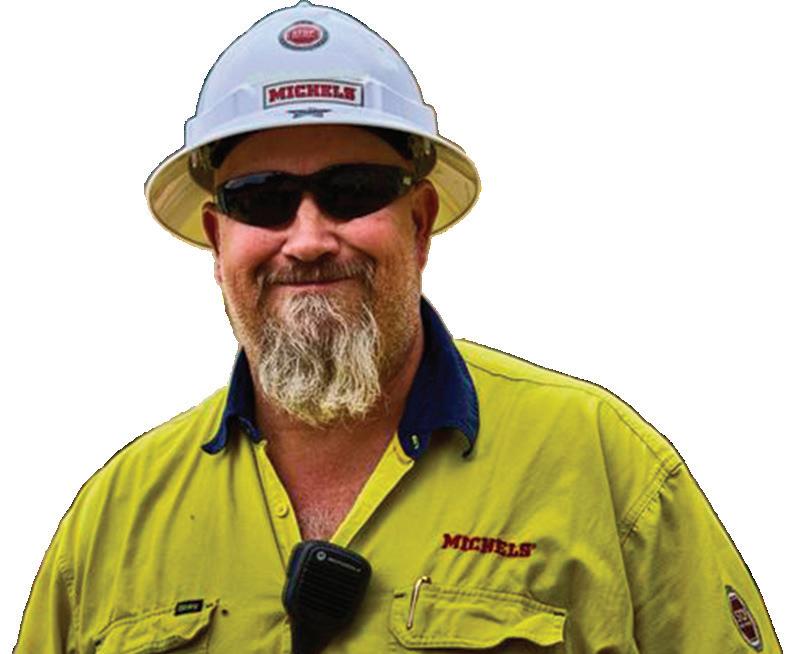
Horizontal Directional Drilling
• Multiple NASTT Project of the Year awards
• Australia-based operations with local resources
• Extensive experience with intersects and long crossings
• Successful 4.7km HDD under waterway
Direct Pipe
• Foremost Direct Pipe Contractor
• Outfalls and shore approaches
• Pipe Installations up to 1.5m
• Completed first of multiple 2,250m HDD’s with 590m elevation change
• Longest HDD intersect completed in Australia
• Record breaking HDD for combined elevation change and length


APGA Convention Program
Monday 14 October 2024
8:00 AM ARRIVAL & REGISTRATION
9:00 AM Convention Opening John Stuart-Robertson APGA
9:10 AM Welcome to Country TBC
9:20 AM State of the Industry Steve Davies APGA
9:40 AM Keynote – Industry Hon Tom Koutsantonis MP
10:00 AM APGA Awards Steve Davies | John Stuart-Robertson APGA
10:30 AM MORNING TEA
11:00 AM PANEL: Leaders Steve Davies & Guests APGA
11:40 AM Keynote – Motivation Topic: Future Fuels
12:00 PM Building the next phase of renewable gas research David Norman FFCRC
12:30 PM LUNCH BREAK
1:45 PM Towards Best Practices: Assessing and Managing Process Safety Risks for Future Fuels
Thomas Jackson | Sam Hatwell GPA Engineering
2:05 PM Bridging Industries for Sustainable Energy
Jarad McInnes | Brent Davis Jemena
2:25 PM Hydrogen Park South Australia’s performance (May 2021 – May 2024) Owen Sharpe AGIG
2:45 PM An Invitation to the Renewable Generation James Roberts GPA Engineering
3:15 PM AFTERNOON TEA Topic: Projects
3:45 PM Pipeline Engineers versus AI: Who would win a match in ‘Competence’? Michelle Unger ROSEN
4:05 PM
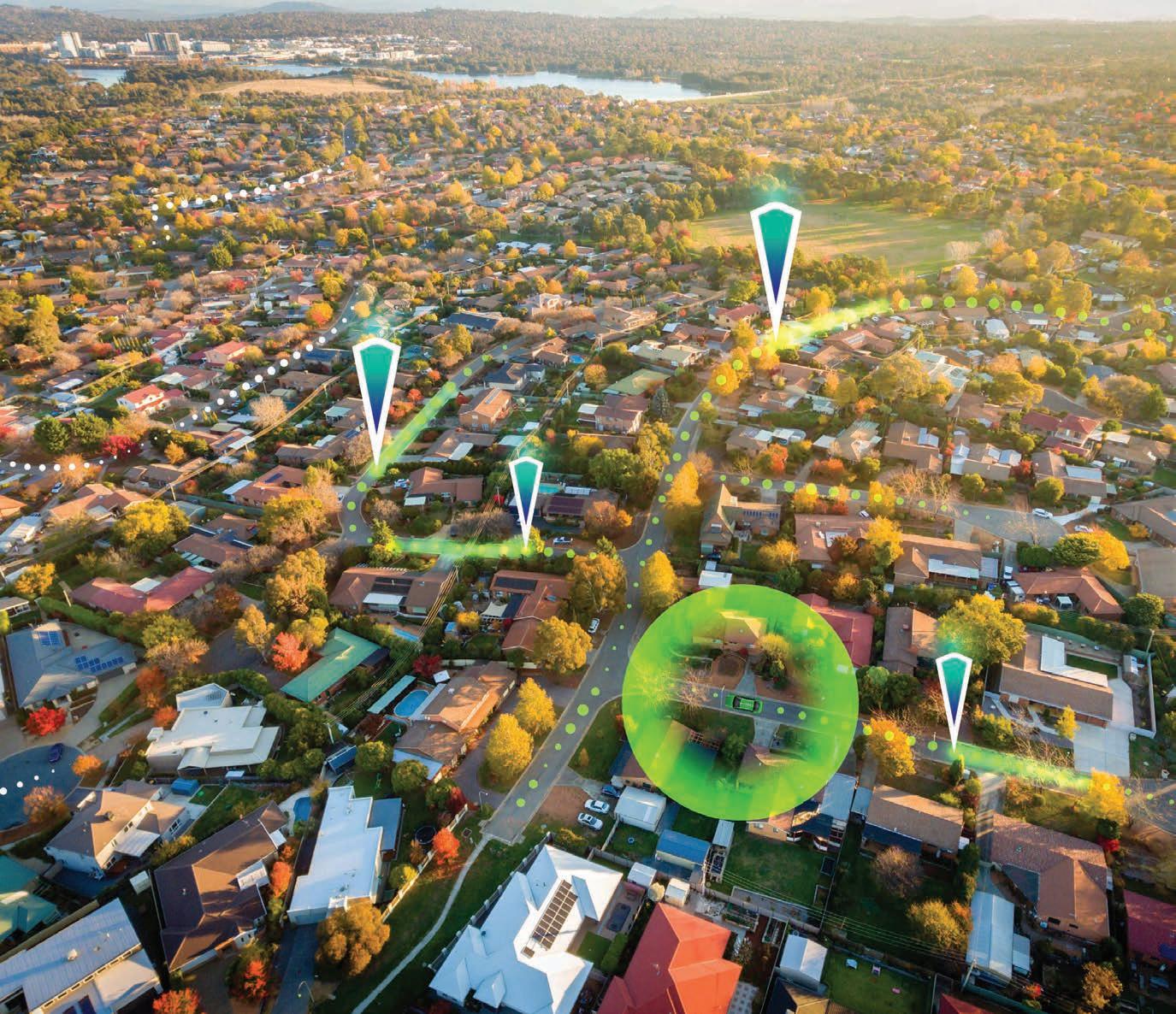
A Contractor’s perspective on the many challenges and lessons learned from the construction of the Western Outer Ring Main (WORM) pipeline on the outskirts of Melbourne.
Leigh Smith Spiecapag
4:25 PM New Energy Solutions: The challenges of connecting and future-proofing an LNG Import Terminal
Justin Anderson Jemena
4:45 PM Moomba CCS, from inception to operations – CO2 Pipeline – Ready for Operation Owen Lucas | Alex Donald SANTOS
5:05 PM CONVENTION CLOSE – Day 1
7:00 PM Fancy Dress Dinner ACEC
11:00 PM Happy Hour

APGA Convention Program
Tuesday 15 October 2024
8:00 AM ARRIVAL & REGISTRATION
9:00 AM Convention Opening Topic: Future Pipelines
9:10 AM
9:30 AM
9:50 AM
Bridges and pipeline integrity engineering – what do they have in common? An EPRG perspective
Marion Erdelen EPRG / ROSEN Group
Compatibility of Type B Appliances for Use on Hydrogen Blends (HyP MV Case Study)
Carina Nixon | Robert Davis GPA Engineering
Repurposing Existing Natural Gas Pipeline Infrastructure – A Case Study in a Phased Approach to Assessment and Planning for Hydrogen Conversion
Klaas van Alphen APA
10:10 AM The Ammonia Challenge
James Czornohalan Worley Consulting
10:30 AM MORNING TEA
11:00 AM PANEL: Leadership: Leadership in the industry Topic: ESG, Steve Davies | Gretchen Gagel
11:40 AM Are hard spots a stable threat in Hydrogen-blended pipelines
Isya Muhajirin Quest Integrity
12:00 PM
Discussing sustainability in the pipeline industry through the establishment of a Code of Practice
Mitch Pearce CNC Project Management
12:30 PM LUNCH BREAK
1:45 PM YPF Panel APGA
2:25 PM
Gender Diversity in the Pipelines Sector: Part 2 of Opportunity and Career Development for all.
Carol Bond RMIT University
2:45 PM Operationalising a low emission future
Allyson Woodford APA
3:15 PM AFTERNOON TEA Topic: POG
3:45 PM Navigating Stress Corrosion Challenges in Aging Infrastructure.
Matthew Clark | Ben Parkin APA
4:05 PM 10 Years On – Operation Post Rupture
Lauren Beynon | Josh Row EPIC ENERGY
4:25 PM SANTOS pipeline incident – lessons learned “Big Lake”
Rhys Ward SANTOS

4:45 PM
First Measurements of the Influence of Hydrogen on the Fracture Toughness of a X65 Gas Transmission Pipeline Steel
Andrejs Atrens The University of Queensland
5:05 PM CONVENTION CLOSE – Day 2
7:00 PM Gala Dinner ACEC
11:00 PM Happy Hour

We make life flow.
As the leading pipe systems and solutions manufacturer, Vinidex is at the forefront of innovations reshaping the Natural Gas industry. From water and gas transfer solutions to custom-made fabricated fittings, we’re pushing the boundaries of performance with products that are lighter to use, faster to install and easier to recycle.
Learn more about our offering in the Natural Gas market at vinidex.com.au
STAND 72 & 73
No two jobs are the same, and to tackle a wider variety of trenching projects, contractors need unique machinery that can adapt to any specific job, task or challenge.
Job sites and projects aren’t always flexible, so it’s important for contractors to have configurable, adaptable equipment that can tackle whatever requirements a jobsite throws their way.
In the world of customisable pipeline and utility trenchers, the Vermeer T755III stands out as a powerhouse and is designed to tackle a broader range of jobs with precision and ease.
Whether you’re working in rugged landscapes or challenging soil conditions, Vermeer’s T755III provides an impressive blend of configurable options and durability, combined with cutting-edge technology to maximise productivity and performance.
A key feature of Vermeer’s T755III is its versatility and the ability to adapt to project requirements. The range of options and additional features of the T755III trencher mean the equipment can be tailored to meet the specific demands of different job sites.
Central to the trencher’s adaptability is a range of optional length sectionalised boom sections. This allows operators to set the machine’s boom length to suit the depth requirements, trench spec and conditions of the job at hand, overall maximising the machine’s performance.
“It’s worth noting that the machine has a maximum digging depth range anywhere from 1.5m to 3m deep, depending on what sectional boom option the machine has installed,” Vermeer Product Specialist Steve Batchelor said.
“Adding to this is the ability to set the machine's cutting width from 40.6cm to 91.4cm wide, along with varying cutting teeth styles to tackle ground conditions ranging from sticky clays right up to seriously hard rock formations.”
Depending on the machine’s digging boom specification, the machine’s weight will range between 22,000kg to 34,000kg, which contributes to the tractive effort needed to tackle the hard rock conditions.
The onboard conveyer offers further versatility through its ability to distribute material to either side of the machine at varying distances, and the optional LRC 25 loading conveyor
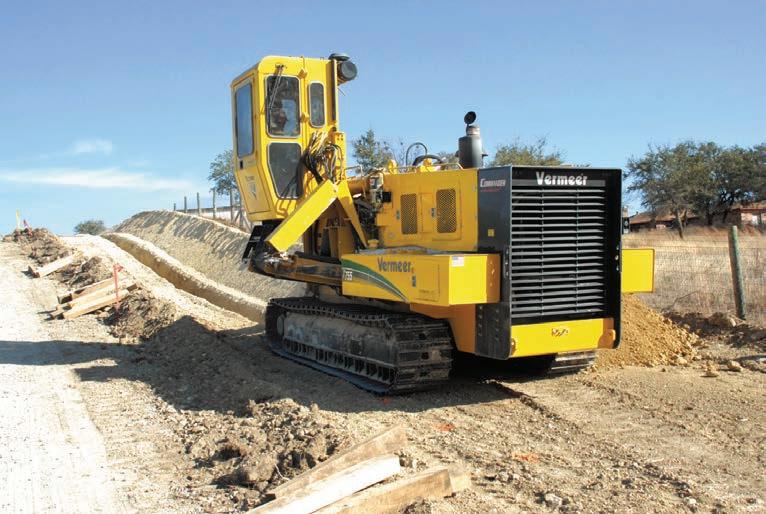
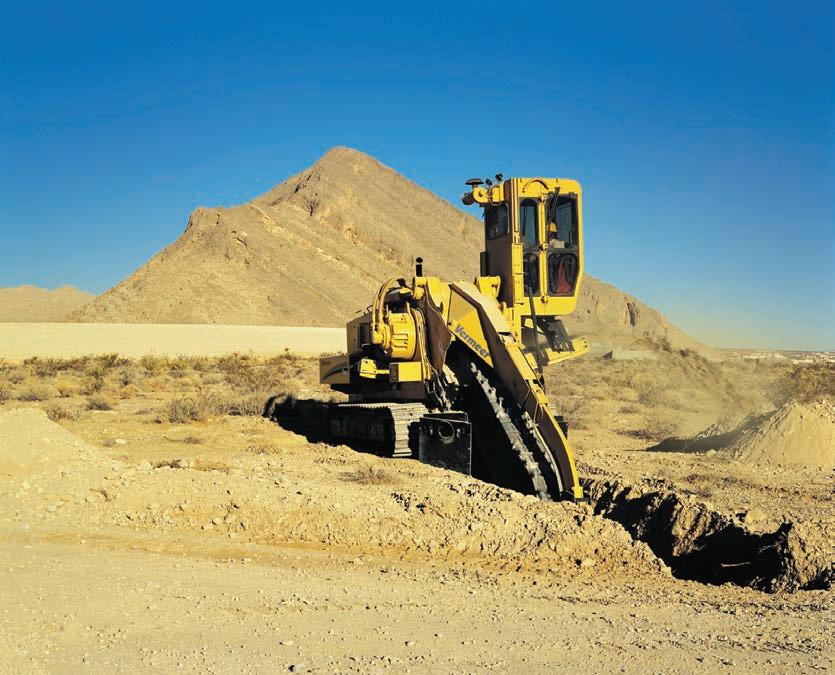
The T755III features a tilt track and Auto Level undercarriage, allowing the machine to maintain a trench even on slopes up to 12°, ensuring smooth operation on a wider variety of terrains including uneven ground, without compromising the trench quality.
The SmartTEC electronic control system helps increase productivity with real-time machine
elevating operators cab,” Batchelor said. “This is to assist in keeping the operator’s environment dust free, preventing dust ingress which could be harmful to their health and safety.
Vermeer offers an optional extended warranty coverage of up to five-years/5000-hours, giving contractors the peace of mind that their machines are backed by an experienced and knowledgeable team of experts at Vermeer Australia.


Part of the comprehensive gas distribution systems offering from TDW, the revolutionary POLYSTOPP® Quick Connect system makes it easy to safely perform tapping, plugging and branching on polyethylene (PE) pipelines — faster than other methods of isolating and using significantly less excavation space.
One person lift. | For 4-inch through 8-inch pipelines. Pressure rated to 10 bar (150 psi). | Covers multiple standard dimension ratios. 2-inch bypass capable. | Plugging or branching fittings available.
How much faster is it? Watch the speed comparison video:
7, 8 & Equipment Stand
Austrack Equipment’s SafeVac Lifting Systems, known for efficiency and safety, has just added another string to its bow: adaptability.
As Austrack Equipment launches into its second full year of production of its SafeVac Lifting Systems SV400 pipe vacuum lifter, the company isn’t resting on its laurels.
Austrack’s latest adaption of its vacuum lift is hard at work at Brisbane Airport’s Legacy runway. The terrain at the airport is certainly a change of scenery for the SV400, swapping the remoteness of typical pipeline projects for the close confines of an international airport runway.
Against the backdrop of Brisbane’s central business district, the SV400 is hard at work lifting four-tonne sections of old runway scheduled for replacement.
The individual sections of this 40-year-old runway are 4m long, 1m wide and 0.5m thick. Compounding the challenge is the grooved surface of the runway, calling for a very spongy seal to ensure compression and integrity of lift. But paradoxically, unique challenges are nothing out of the ordinary for Austrack, and the project is going off without a hitch.
Austrack General Manager Donna Owens said that it was precisely this reputation that helped
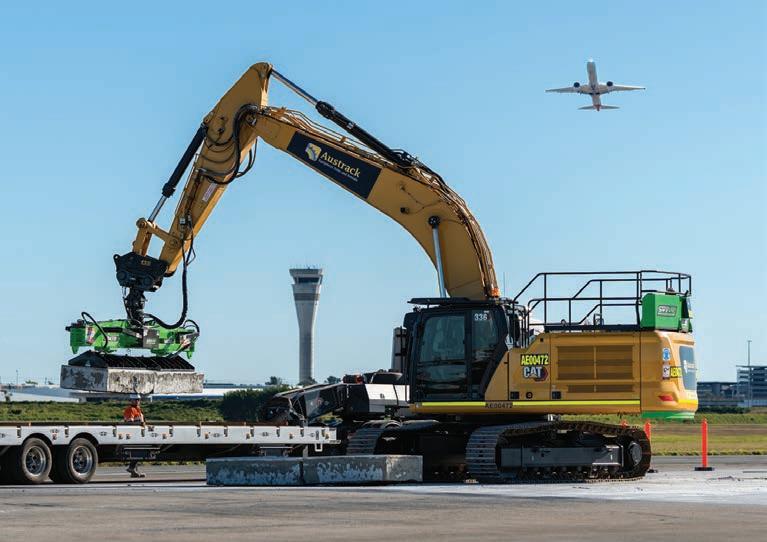
sourced from Holland in Europe. The actual vacuum generation and supply remains an unmodified standard SV400 system.
“The reconfigured system worked perfectly and
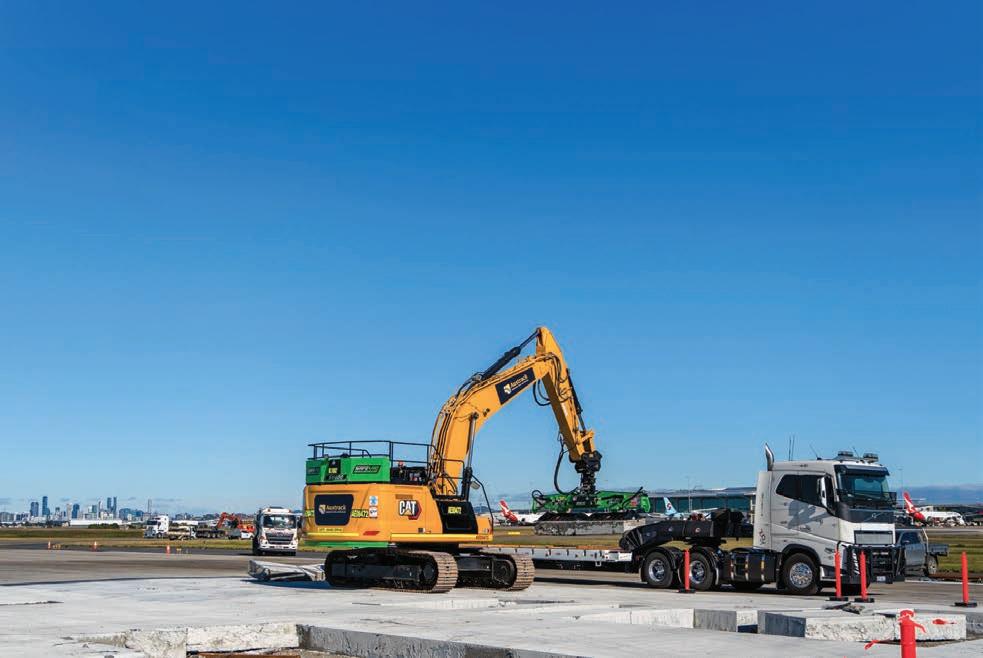
“Last year was our first year exhibiting at the annual APGA event and we were both surprised and delighted to be awarded ‘Best Exhibit’,” Owens said.
“This year we have taken one of the equipment areas as well as a double booth, so we have raised the bar and given ourselves a challenge.
“We are feeling a certain pressure to perform, but performing under pressure is par for the course at Austrack.
“We are very busy putting the finishing touches to the machine that will feature in our equipment display area at Adelaide.”
Owens was cautious about spoiling the surprise but hinted that the company has continued on its vacuum lifter journey.
“What we are planning to bring to Adelaide is going to mean a visit to our display at the show will be well worth the trouble,” she said.
“I can also advise that Austrack have just been appointed as exclusive agents for Australia and New Zealand for a European excavator bucket manufacturer.
“World shipping routes obliging, we plan to have the best of our new business partners quality products on display in Adelaide – yet another compelling reason to visit our display.”


APGA Corporate Affairs Manager Paul Purcell discusses the role of biomethane in the energy transition.
Written by APGA Corporate Affairs Manager Paul Purcell
South Australia has long been a national leader in action to combat climate change, and today generates more than 70 per cent of its electricity from renewable sources – a major accomplishment as the state works toward its goal of 100 per cent net renewable electricity by 2027.
But it’s a common misnomer that solving electricity generation means solving the energy transition. Currently, electricity makes up just 25 per cent of total final energy consumption in Australia.
Plainly, we’ve got a long way to go to decarbonise the rest of our economy.
But it is imperative to do so without policies that result in economic demand destruction, the offshoring of domestic enterprise and associated carbon leakage, or an erosion of living standards.
Which brings us to the lowest-hanging fruit still waiting to be plucked: Biomethane.
The domestic gas infrastructure industry is committed to net zero by 2050 through the decarbonisation of its assets, helping deliver a sustainable future for households, businesses, and industry. In 2024, APGA and its members commissioned comprehensive studies to assess the biomethane potential from anaerobic digestion of organic waste and residues in the catchment areas (within 50km) of gas networks across NSW, South Australia, Victoria, and Queensland.
Given it will be home to APGA’s convention this year, let’s focus on South Australia.
The state consumes 301 petajoules (PJ) of energy each year, which is approximately 16 per cent renewables, 27 per cent natural gas, nine per cent coal via the Victorian interconnector and about 47 per cent oil – predominantly used in light passenger vehicles as well as heavy transport.
In terms of a hierarchy for economically efficient emission reductions, the overwhelming priority should be to expedite the displacement of coal-generation, particularly Victorian brown coal.
To illustrate, the Yallourn brown coal power plant has an emissions intensity of 1316 kgCO₂/ MWh, compared with Pelican Point gas-fired power station which is 474kgCO₂/MWh – 64 per cent lower.
But if we were to move down the priority list to decarbonising gas, how would we do it?
In the first instance, it should be through expediting biomethane production. In the most

recent 2024 biomethane potential report by Blumony, it found there is up to 33PJs of carbonneutral biomethane supply in South Australia alone. To properly contextualise the emission reductions opportunity, the avoided CO2 emissions of approximately 1,651,800 tons is equivalent to taking 360,000 passenger cars off the roads, or about 31 per cent of the cars registered in South Australia.
This is significant.
Additional benefits for South Australia include the diversion of nearly 500,000 tonnes per annum of organic waste from landfills, production of 1.2 million tonnes of nutrient-rich digestate which can be used as natural fertiliser in agriculture, as well as thousands of local jobs.
This is just the start and there is significant potential to grow even more. But how do we get there?
Today, the National Greenhouse and Energy Reporting rules do not currently recognise biomethane as distinct from fossil-derived natural gas when it is injected into the existing gas grid. This lack of differentiation means that the environmental benefits of biomethane, such as its lower carbon footprint, are not acknowledged or incentivised within the reporting and accounting framework.
The existing NGERS framework lacks mechanisms for tracking and verifying the volume and origin of renewable gas once it enters the common-use infrastructure. Without such mechanisms, it becomes challenging to ensure that the reported emissions reductions or renewable energy credits are accurately attributed to
between renewable and fossil gases within common-use infrastructure, there are no specific incentives for gas producers or consumers to switch to biomethane. This misalignment of incentives limits the economic attractiveness of biomethane projects, reducing the motivation for companies to invest in its production.
APGA has been engaging with the Federal Government, and state governments, to help address this oversight, and expedite the amendment of NGERS to recognise biomethane while also advocating for a fast-tracking of a market-based method to provide a framework for tracking and reporting.
That’s the first step.
From there, it will be imperative to set a national target of renewable gas for 2030, and 2035 – which will be predominantly supplied via biomethane to help signal national ambition for renewable energy development, boosting investor confidence and the development of a nascent market.
And finally, we must establish a target price for biomethane to make it cost-competitive with other energy sources.
These steps are crucial for bridging the gap between our current reliance on fossil fuels, particularly coal, and a sustainable future. By addressing these challenges, South Australia can continue in its role as a national leader in reducing emissions and setting a precedent for the rest of Australia.
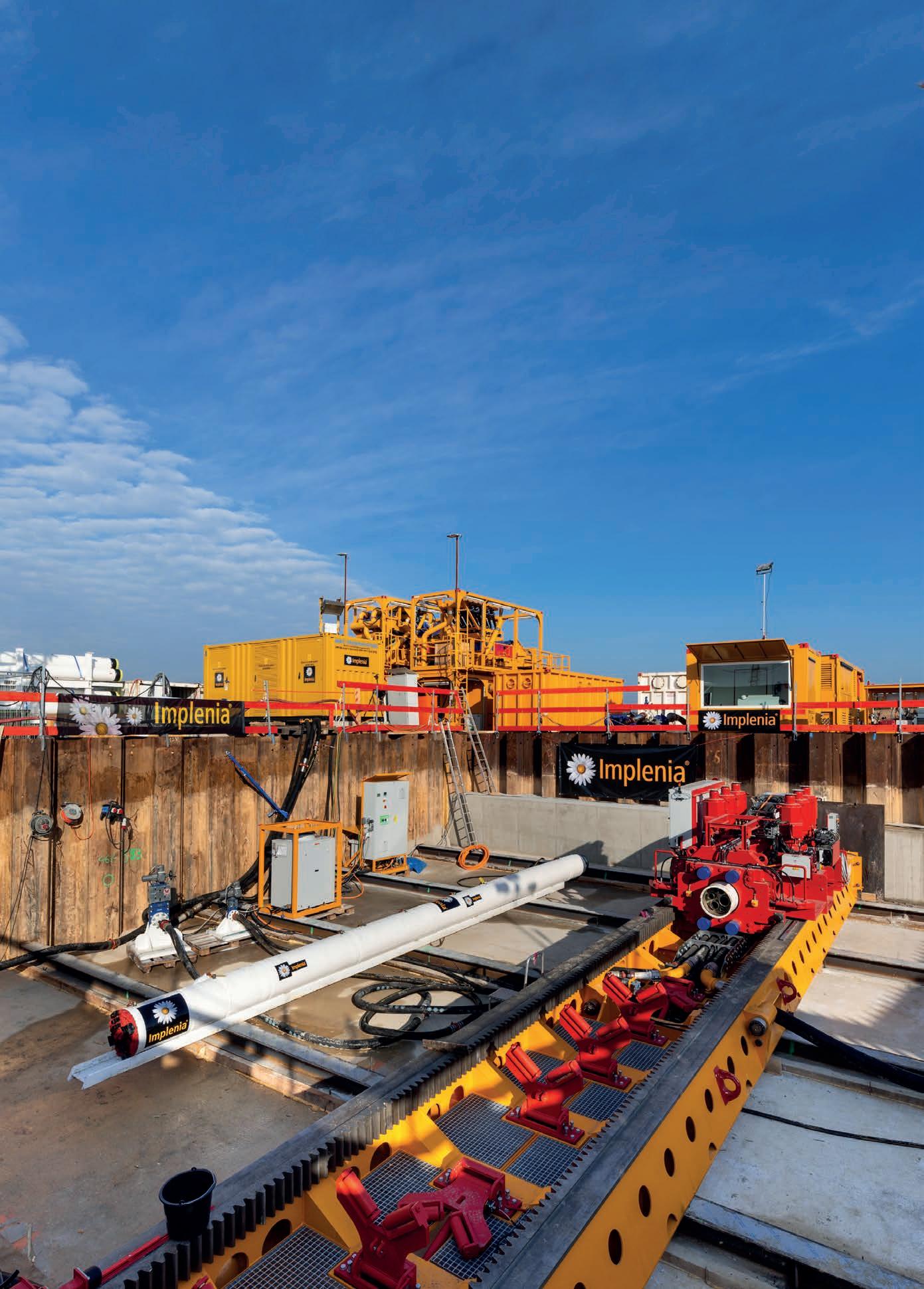

As methane emissions take spotlight across the globe, oil and gas operators are seeking ways to detect, locate, and reduce methane emissions.
In Australia, new advanced technologies are emerging to help operators take on the unique challenges that come with operating in Australia.
One such technology is Bridger Photonics’ Gas Mapping Light Detection and Ranging (LiDAR). To learn more, The Australian Pipeliner sat down with Bridger Photonics Vice President of Sales Ryan Stewart.
What is Bridger Photonics’ mission in the oil and gas sector?
Our goal is to empower the industry to achieve greater environmental stewardship by providing actionable insights that help reduce methane emissions, improve safety, and enhance operational efficiency.
Bridger Photonics’ Gas Mapping LiDAR, or GML, uses laser technology to detect, locate, and quantify methane emissions across the full value stream, from production to distribution of natural gas. We attach a GML sensor to a small aircraft, which collects methane data over oil and gas facilities to detect and image methane emissions.
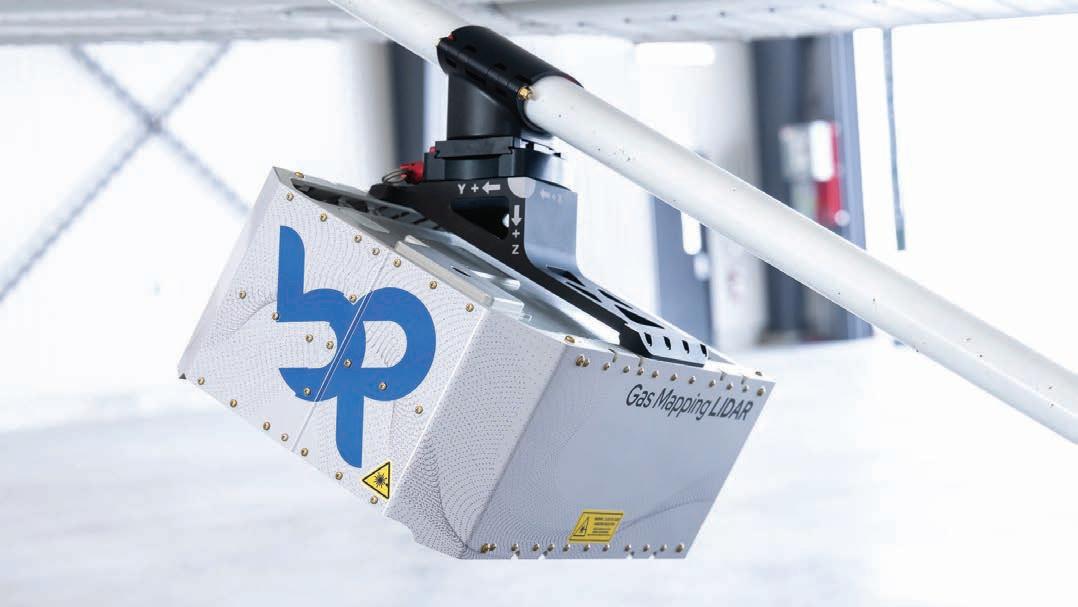
We then analyse that data and provide the client with maps and information about detected emissions, including pinpoint source location, emission rate, plume imagery, emission persistence, max path-integrated concentration, and more. This data can allow oil and gas companies to characterise their emissions at a system level and develop plans that manage fugitive and operating emissions more efficiently and effectively.
The GML uses laser technology to detect, locate, and quantify methane emissions.
What attracted Bridger Photonics to the Australian market?
We’ve worked for a lot of the global majors and our track record has generated interest in Australia, with many operators seeing the gaps we could bridge versus existing technologies. Our interest in the Australian market was fortified through early conversations with operators who expressed a clear demand for advanced emissions detection solutions that would help them overcome the many challenges they are facing. Australia’s strong commitment to safety and sustainability aligns perfectly with our core values and expertise.
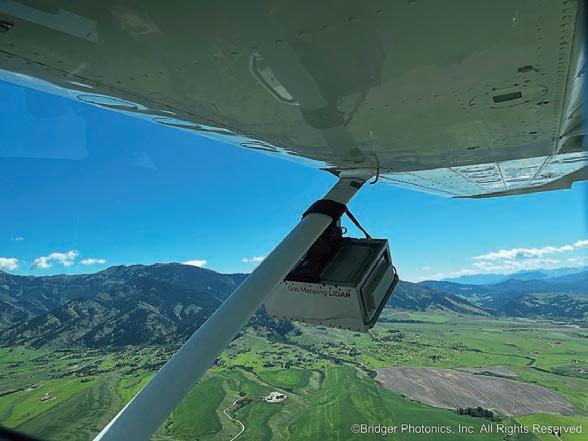
What are some of the challenges Australia faces with methane emissions?
What we’ve heard from our partners is that there are three main challenges operators face in this industry.
First, the sheer scale and remote nature of operations in Australia pose significant difficulties. The expansive and rugged terrain makes it both time-consuming and heavily resource-intensive to detect and manage methane emissions.
Secondly there are risks to the safety of employees while carrying out these critical activities. Due to the remoteness of many sites, ground crews often spend considerable time traveling and operating on hazardous sites, sometimes only to find that there are no emissions to address. This not only comes at a considerable operational cost but also raises safety concerns due to the extensive travel and site exposure required.
Finally, operators need technologies that can accurately characterise emissions at scale across Australia’s vast and complex infrastructure to ensure emissions reduction programs are efficient and effective.
How can Bridger Photonics help operators overcome these challenges?
Bridger Photonics addresses these challenges with our aerial methane detection technology. By deploying our sensors via aircraft, we are capable of scanning hundreds of sites or kilometres of pipeline in a single day, safely and efficiently. Our data can provide operators with precise locations of methane emissions and, crucially, confirms where there are no emissions.
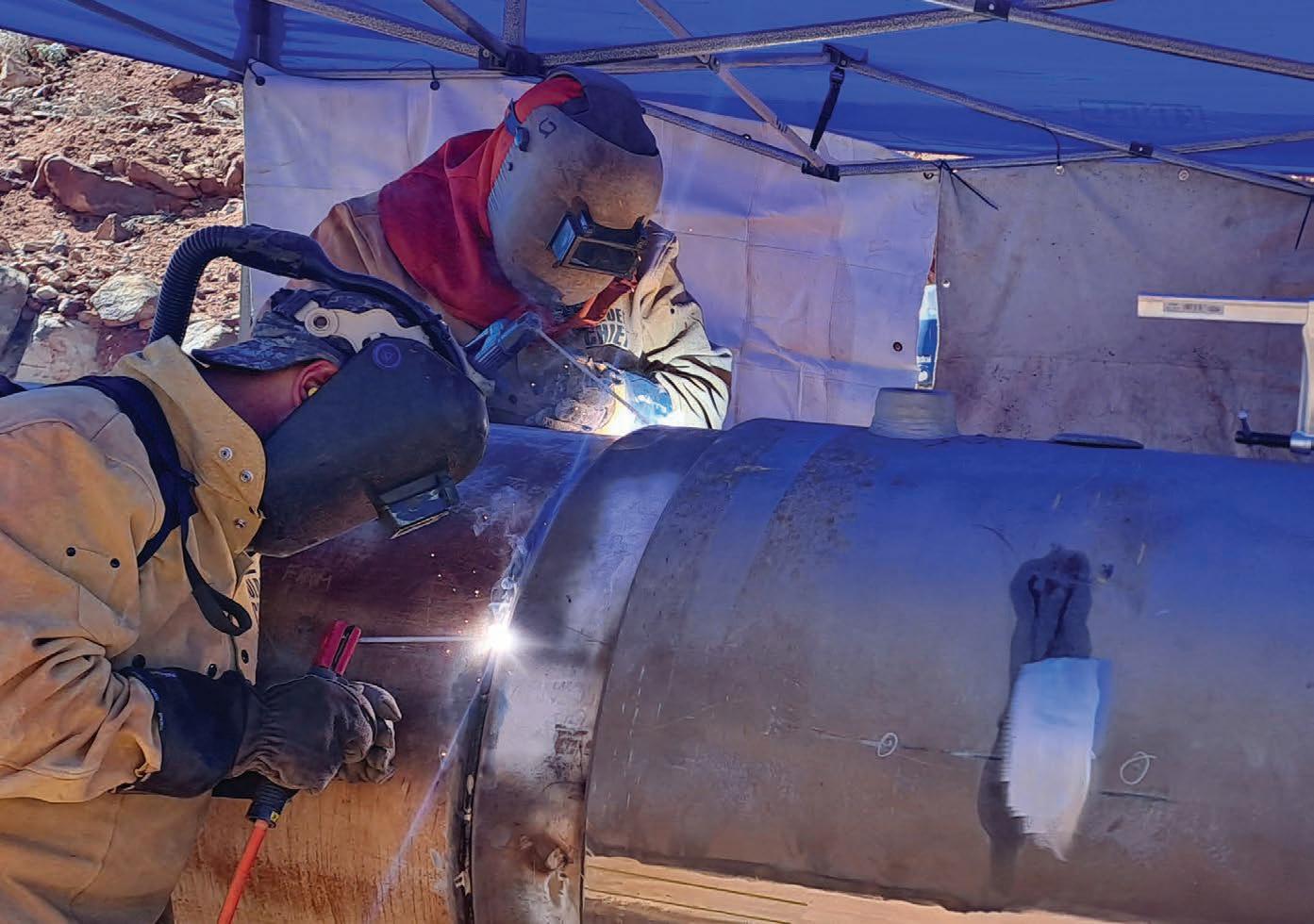
This can enable operators to prioritise their resources effectively, reducing unnecessary site visits and travel time for ground crews.
We also provide operators with aerial imagery of each site and have the spatial resolution to pinpoint emissions sources down to equipment level so they can have a better understanding of each emission source before visiting a site. This means that ground crews can arrive better prepared for repairs with the necessary tools, reducing exposure and driving efficient programs.
With advanced technology like ours, operators aren’t blind to their emissions profiles – we allow them to measure and take control. We help operators baseline and track emissions through measurement, which is increasingly important in a continuously evolving regulatory environment.
As we dove into the unique data GML provides, feedback has been overwhelmingly positive, with a special appreciation of the detailed insights we provide because it can enable more
complete emissions inventories and informed decision-making. Compared to previous technologies tested, operators have shared that we provide more detailed emissions data with better localisation which is due to Bridger’s proprietary LiDAR technology.
Since this is a relatively new area of deployment for us, we are continuously engaging with operators to ensure we deliver maximum value tailored to their specific needs.
Our primary goal is to strengthen and expand our relationships with local operators to ensure sustainable, long-term operations in Australia. We have successfully navigated many of the logistical challenges necessary to establish a strong presence here, including partnering with local flight providers. Now, our focus is on optimising these partnerships, leveraging our technology to provide the most value to operators, and contributing to the industry’s overall sustainability and efficiency.
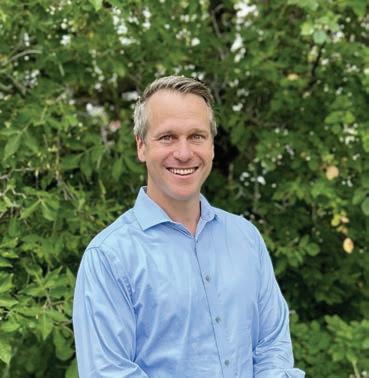
We are impressed by the innovative thinking and proactive stance of the Australian market towards methane emissions reduction. Bridger Photonics is here to support your efforts, whether you are pursuing OGMP 2.0 standards, corporate emissions reduction targets, measurement informed inventories, or enhanced operational efficiencies. We’re excited to partner with operators and tailor a plan that’ll help achieve those goals.

Pipe Tek has been nominated for Downer’s Crew of the Quarter Award due to the safety measures the team took while investigating a 70-year-old asset in a high-density residential area.
Downer contracted Pipe Tek to complete investigative works for a pipe isolation design on a 6.5km DN910 water trunkline, operated by Urban Utilities.
The section of mild steel cement lined (MSCL) trunk water main was constructed in 1959 and forms part of the Wellers Hill reservoir water supply zone.
The pipeline is one of the two largest trunks transferring water from the reservoir to the northern part of the zone.
The proposed project to install two isolation valves will provide improved network contingency.
The contract involved investigative work at two different site locations, located in highdensity residential areas requiring significant road closures.
The pipe was exposed so assessments could be carried out on the coating and identify the best way to dispose of waste when installing the mainline valves.
Steel samples were also taken to determine the best welding procedure.
After the samples were obtained, Pipe Tek applied a Stopaq coating over the areas where coating samples had been taken before backfilling and reinstating the sites. The second stage of the project will involve isolating the pipe to allow for the construction of the new valve pit.
For the next scope of works, Pipe Tek is proposing a Peterson system for the isolation, which is currently being sourced with the help of fellow pipeline contractor Pro Pipe, which specialises in hot tapping and isolation.
As a result of Pipe Tek’s work on the project, Downer nominated Pipe Tek for its ‘Crew of the Quarter Award’ due to the precautions the team took to mitigate the risk of working in and around the live edge dig sites.
“Fostering a positive culture of open communication and feedback is crucial for promoting collaboration in safety initiatives,”
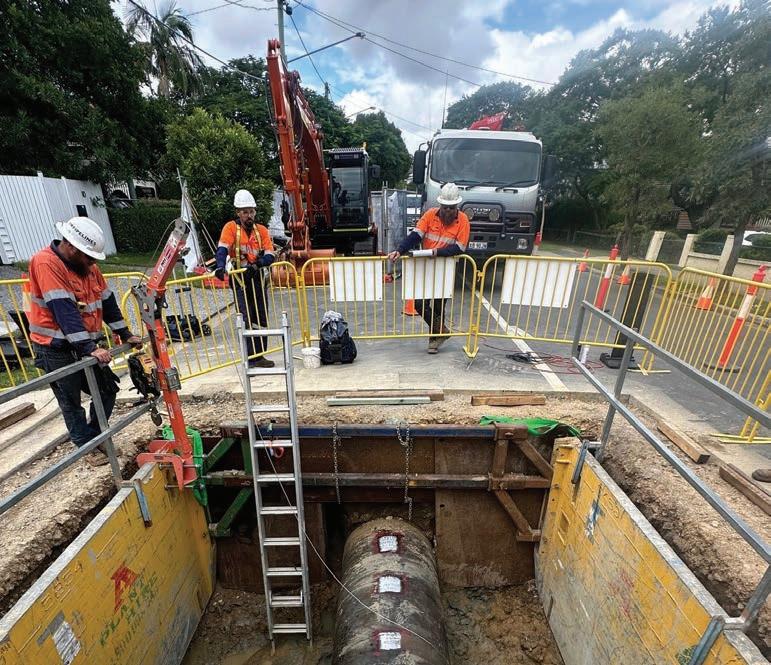
“Pipe Tek have demonstrated active listening to address improved safety by implementing changes as a need to improve safety outcomes in collaboration with the Downer supervisory site team.
“By prioritising transparency and accountability, Pipe Tek was able to adhere to the Downer standards and deliver the investigation works safely and effectively in a time frame of five days prior to the planned schedule.”
Pipe Tek mitigated the risk onsite by implementing barricades, using fall arrests and safety harnesses, and stringent safety procedures for the work area ingress and egress.
The team also placed mats under the buckets of excavators on bitumen roads and ensured that all Pipe Tek personnel upheld good onsite housekeeping.
Pipe Tek Construction Manager Jess Boulter said the team understand risk management is critical onsite.
“We’re really excited to be nominated for Downer’s Crew of the Quarter,” he said.
“We take the safety of the team onsite very seriously. We work hard to make sure that our sites are secure and we’re complying with the relevant safety regulations because we understand that effective risk management is the critical foundation of a job’s success.”
Collaborating with delivery partners Downer has a strong focus on safety, holding regular Delivery Partner Proactive Safety Forums for its contracting teams. These forums support open discussion, engagement and proactive improvements to how Downer and its delivery partners work together.
“They’re really good to attend,” Boulter said.
“By sharing the most recent key lessons learned or proactive activities and plans from each team means all Downer’s delivery partners are on the same page. Each delivery partner is encouraged to share their prestart approach and process, including expectations, what and who is involved, the questions being asked, and the information that is being captured.
“As one of Downer’s delivery partners, we’ve found the opportunity to provide input and feedback in this way is really valuable in reducing risk onsite. And as a bonus, Downer makes the workshop insights available in a slide pack so that we can easily communicate them to all our team members.”
Pipe Tek Managing Director Myles Brannelly said Pipe Tek’s approach to safety reflects Downer’s.
“We strongly believe that, by working together, we can identify and manage risks to reduce potential injury and illness,” he said.
“No job is so important that it cannot be done safely.”


DETECT, MEASURE, AND BETTER UNDERSTAND YOUR METHANE EMISSIONS WITH ADVANCED TECHNOLOGY

Industry leaders across the globe choose Bridger’s aerial Gas Mapping LiDAR™ to provide operators a more clear picture of their emissions, so they can take control.
LEARN MORE TODAY. Scan here to start the conversation.
For over six decades, the company has proudly manufactured its products right here in Australia – partnering with builders, authority bodies, and its customers to deliver innovative pipe systems and solutions, including PVC, polyethylene (PE), polypropylene (PP), ductile (DICL), and industrial pipe systems.
Providing industry-leading solutions is only the beginning. There’s so much more to Vinidex.
Its products and services have been instrumental in delivering innovative solutions for the natural gas industry that have enabled large-scale gas projects to evolve and thrive as they grow.
“We’re incredibly excited about what the future holds for us at Vinidex,” Chief Executive Officer David Bird said.
“We’re continuing to innovate our products and have an exciting pipeline of new solutions. It really is an exceptionally exciting time to be a part of this transformative organisation.”
The Vinidex difference
Vinidex understands the challenges faced across industries, such as natural gas. The need to build faster, reduce costs and deliver exceptional quality while meeting stringent compliance requirements can feel challenging at the best of times.
That’s why the company ensures its greatest asset is the knowledge and expertise its people bring to every project.
Vinidex is passionate about the role its pipeline solutions play in supporting the flow of everyday life– connecting infrastructure, industry and agriculture. 2023
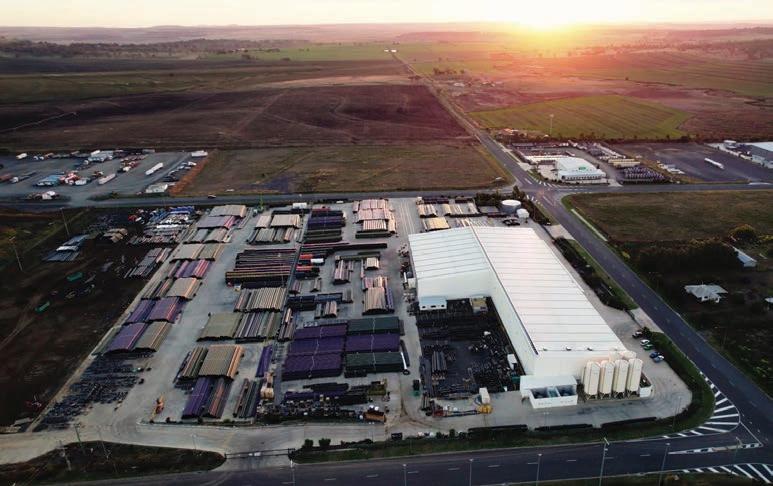
Across every project, Vinidex always starts by developing a broader understanding of the overall objectives, allowing its team to find innovative solutions that are unique to that specific project.
Since starting its Toowoomba gas facility in 2013, Vinidex has rolled out in excess of 3.8 million metres of PE pipes, constructed 26,000 custom-fabricated assemblies and delivered 30,000 units across product categories.
And there’s still more to come.
Vinidex is integrating a strategically designed and located manufacturing facility close to the gas fields to support projects in the region.
Designed with sustainability in mind, the Toowoomba complex will
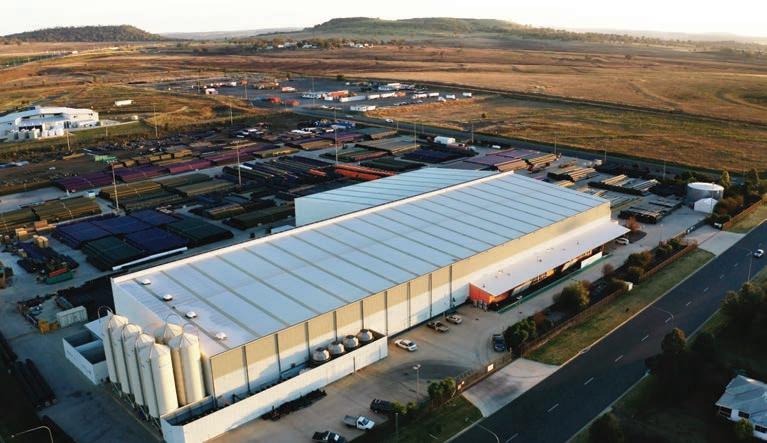
The company provides innovative pipe systems and solutions, including PVC, PE, PP, DICL, and industrial pipe systems.
transform its capabilities in warehousing, fabrication and recycling.
As a leader in the industry, Vinidex understands the role it plays in leading that transition to a cleaner future.
To ensure the company focuses on this important objective, the company is developing a sustainability blueprint that encompasses all parts of the business and transparently reflects its ambitions and the pathway to achieving them.
The company is moving to 100 per cent renewable electricity as of 1 January 2025 and in conjunction with PIPA and MPAQ, is proudly a part of the Queensland construction plastics recycling scheme.
Additionally, Vinidex has Environmental Product Declarations (EPDs) for a wide range of its locally manufactured products, which helps customers make informed decisions based on the environmental impact of the product.
As a local manufacturer, Vinidex is also aware of the impact on the local communities in which it operates. The company’s procurement policy ensures its partners adhere to strict Modern Slavery guidelines and supplier code of conduct programs.
Vinidex will have its products and services on display at this year’s Australian Pipelines and Gas Association Convention at the Adelaide Convention Centre.

Contractors Committee
Consultants Committee
Coals Seam Gas Committee
Health, Safety & Environment
Pipeline corridor
Pipeline Engineering Competency
Pipeline Operations Group
Suppliers Forum


Research & Standards committee
WA Chapter
Women’s Pipeline Forum
Young Pipliners Forum
As pipeline projects become more complex, there is a global need to push the boundaries of trenchless infrastructure installations. With an expanding presence in Australia, Michels is rising to the challenge.

Founded in the Midwestern United States in 1959 as a regional natural gas distribution company, Michels quickly expanded its services to meet the evolving needs of established and new customers. Twenty-six years ago in 1988, Michels entered the horizontal directional drilling (HDD) market, offering a safe, environmentally sound way to install utility lines in areas where traditional open-trench construction would not be practical or feasible.
“Keeping with Michels’ spirit of innovation, the
industry, building a reputation for completing the world’s most challenging and significant installations and for continuing to expand the capabilities of its team and its custom-designed and fabricated equipment,” Michels Trenchless General Manager Bryce Morrow said.
“Michels has completed more than 225 pilothole intersect HDD projects and drilled single crossings more than 4700m to become the world’s most experienced direct pipe contractor.”
In 2021, Michels established Michels Trenchless,
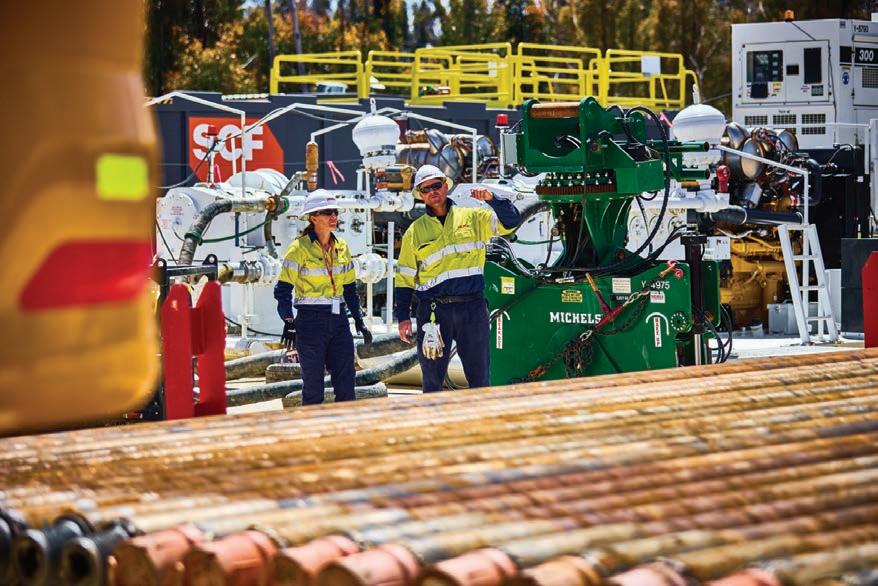
Victoria, Australia, bolstering the Michels Family of Companies. Michels Trenchless selectively specialises in delivering technically challenging trenchless installations throughout the region.
In Australia, Michels Trenchless is continuing to demonstrate its ability to succeed with technical challenges that expand the potential for trenchless construction. The team has used its skills to maintain directional control and avoid negative environmental impact while completing a 2243m-long borehole with an elevation change of a staggering 650m. By comparison, the classic HDD profile is commonly composed of five sections: a downward tangent, a parabolic arc, a flat tangent, another parabolic arc and an upward tangent ending at the exit point. In most standard HDD profiles, elevations changes of about 50m between entry and exit locations are considered significant.
The Michels Trenchless team continues to complete additional challenging drills on the same remote project in Australia.
During its foundational years in Australia, Michels Trenchless established the leadership, safety and field operation teams needed to deliver trenchless construction throughout Australia and the Asia Pacific region.
In-country teams have direct access to a large, local fleet of specialised equipment integrated with

Michels now globally experienced technical experts.
“Michels has responded to the need of expanding the region’s trenchless construction capabilities,” Morrow said.
“Michels has the skills, experience, creativity and confidence needed to plan, review and safely construct technically challenging crossings beyond what has been previously achievable by existing domestic capabilities.”
This is far from the first time Michels has completed HDD projects requiring immense levels of skill and power.
“In 2021, Michels completed a 4702m installation of an NPS-24 steel utility line in North Dakota, the likes of which had not previously been attempted at the 24-inch diameter anywhere,” Morrow said.

That same year, Michels completed a 3540m installation of an NPS-12 steel pipe under a golf course and wetland in Burlington, Ontario, the longest HDD in Canada to date. The alignment
horizontal curves along the alignment.
In 2020, Michels completed a 1041m installation of NPS-42 steel pipe under the bow River in Cochrane, Alberta, Canada. A 64.4m
For more information, visit michels.us
Michels has a long history of delivering complex trenchless projects. With a growing footprint in the country, Australian pipeline projects look set to benefit from the company’s expertise.
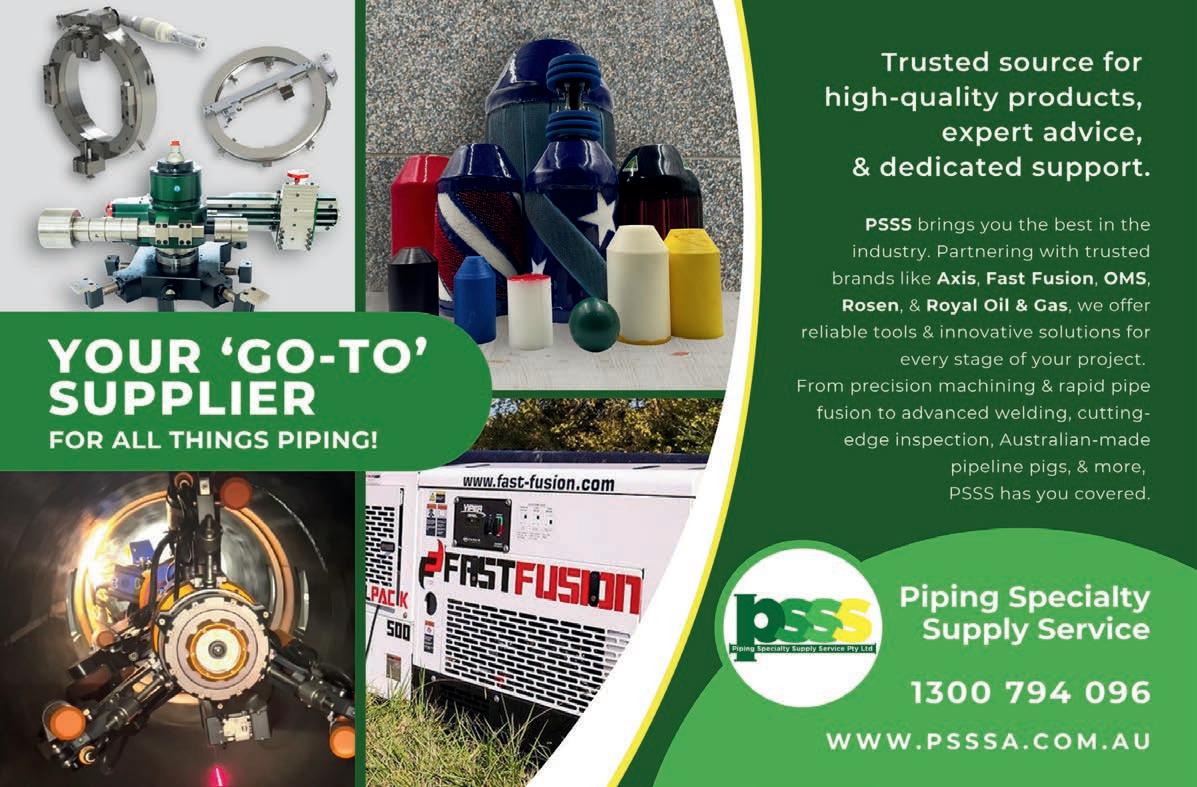
At this year’s Australian Pipelines and Gas Association Convention, Mipela GeoSolutions is on deck to help solve the pipeline sector’s most pressing data challenges.
The energy transition is ramping up, with more and more businesses moving away from fossil fuels to electrification to drive down carbon emissions in their operations.
As companies face mounting pressure from regulators and stakeholders to decarbonise operations, the role of data – and its value as an asset within an organisation– is increasingly prominent.
Technology is constantly evolving and is often complex. That’s why pipeline companies are turning to Mipela GeoSolutions for expert guidance in data management.
Mipela’s X-Info suite of software solutions turns data collection and analysis into a streamlined process, as it can manage, share, visualise and capture data for clients – connecting people with information.
“Mipela GeoSolutions is helping its pipeline industry customers learn new ideas to align processes and systems to automate tasks and eliminate manual processes,” Mipela Managing Director Hayden McDonald told The Australian Pipeliner.
Mipela GeoSolutions is currently undertaking a digital transformation of the X-Info suite. The phases of this project are to migrate and modernise, so the Mipela team can in turn enhance security, improve reliability, and increase performance.
“We are continuing with our digital transformation, with the migration phase of our new X-Info portal hosting platform in AWS (Amazon Web Services) now complete,” McDonald said.
Leveraging the new and improved capabilities of its X-Info suite assurance solutions, Mipela is
maintaining and aligning its processes and systems, enhancing the security of customer data, while also driving forward future of solutions with new ideas, improvements and innovations.
These solutions can digitalise core business functions, including stakeholder, project, customer relationship and asset management, geographic information, stakeholder engagement, document management systems, and much more, integrates them into a unified knowledge software solution.
“With Mipela, you can easily monitor, manage and improve the efficiency of your business processes to ensure all procedures and steps are completed on time and your projects remain on track,” McDonald said.
“Storing, maintaining, tracking and analysing information within your business has never been easier.”



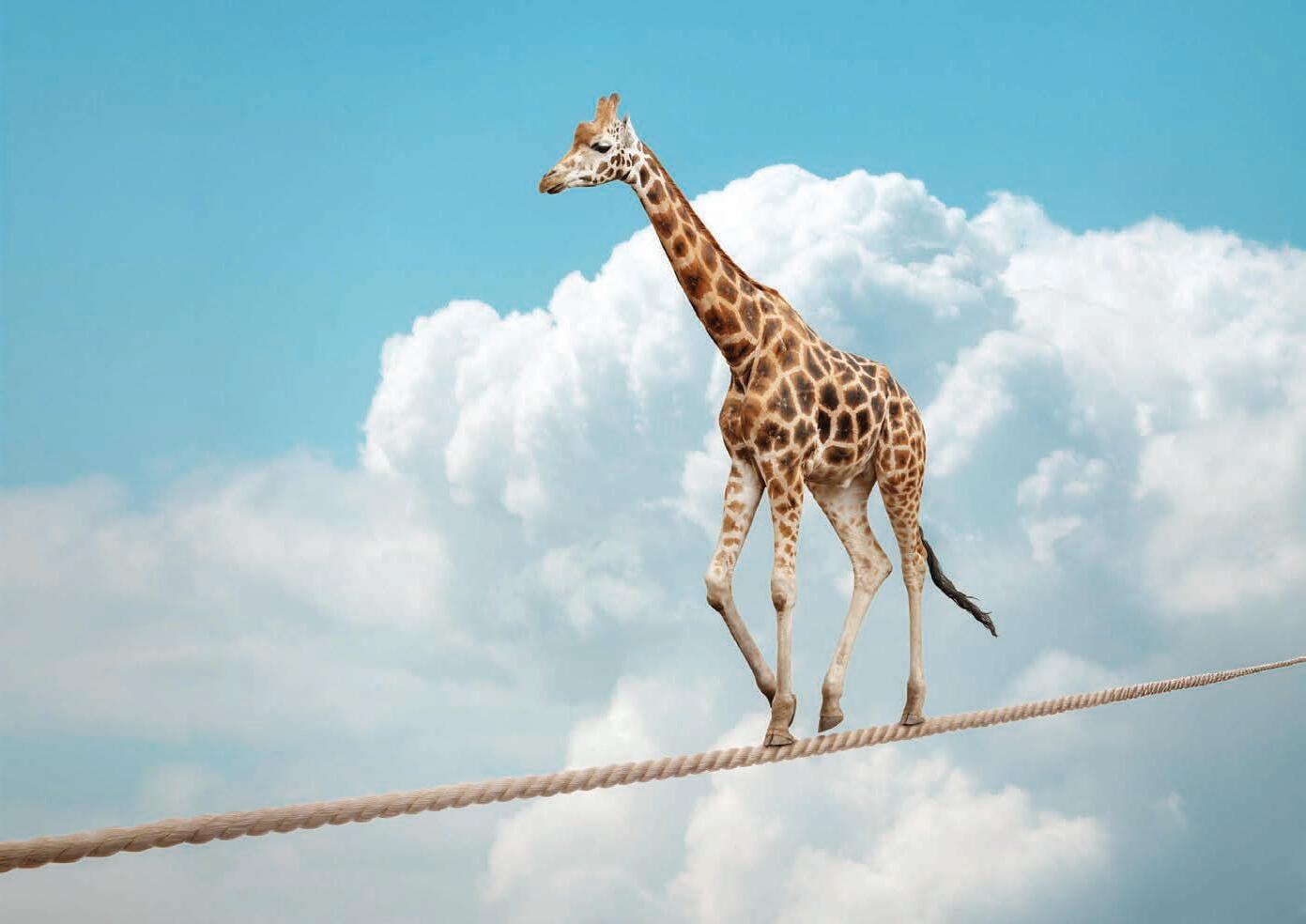

Mipela will be on the ground at the APGA Convention, highlighting the latest in its suite of digital solutions.
“This year we wanted to visually highlight the race that is underway in the energy transition and the tightrope that we are all travelling along, in a way that people could easily understand in how we align the solutions and services we provide,” McDonald said.
“Whether you’re an established player or just starting out, we help clients accelerate the assurance of their day-to-day data management activities or hosting needs, no matter where they are in their journey along the tightrope.
“To help with this transition, we have decided to stage our convention stand as a psychiatrist’s office to help clients diagnose their most pressing cloud hosting or data management ailments.”

Mipela’s stand will be warm and inviting with a fireplace, chaise lounge, and decorated with the company’s animal mascots and key messages.
“At the convention, we will share how we provide secure solutions in pipeline industry,
enabling your people to be proactive and improving the lifecycle of your day-today activities.
Whether it’s digitalising business practices, environmental, social and governance
accountability, eliminating operational inefficiencies, or improving safety, Mipela has a digital solution for almost anything. The company’s suite of products is helping drive the pipeline sector into the future.

Picarro has launched the updated LISA Priority Scoring system embedded in the P-Cubed platform, a revolutionary advancement in leak management and emission management technology.
The company’s comprehensive datainformed framework, powered by Picarro’s patented data collection systems, provides timely, reliable, and actionable insights that revolutionise risk management.
As regulations evolve, operators can seamlessly manage and reduce system risks, streamline reporting processes, and make well-informed decisions to enhance network performance, delivering significant value across the enterprise.
Picarro’s team of experts has been closely monitoring the rapidly changing regulatory environments, driven by the new regulations in Australia and the European Union on methane emissions, as well as the United States PHMSA’s advanced leak detection programs.
In anticipation of these regulations, the company has also developed emissions360™ ensuring it meets current and future needs of advanced leak detection programs, emissions inventories and abatement strategies.
P-Cubed™ identifies gas emitting locations, called ‘Leak Indication Search Areas’ (LISAs), where the gas operator can then send leak investigators to find, pinpoint and address one or more potential gas leaks.
At the heart of this application is the LISA™ Priority Scoring system.
This sophisticated algorithm is a game-changer for distribution leak surveys. It allows operators to generate tailored reports based on a variety of data sources, including utility DIMP models, pipeline GIS data, and emissions source data gathered by Picarro.
By leveraging these inputs, the Priority Scoring system offers customisable results that enable companies to address the most critical indications effectively. Under this new era of leak management operators will be able to prioritise leak repair in a way that will dramatically increase safety and reduce emissions without overburdening operations with additional repairs.
Picarro Director of Gas Sales and Marketing Doug Ward highlighted the impact of the LISA Priority Scoring system as a powerful tool for leak management.
“By digesting data from diverse sources— utility DIMP models, pipeline GIS data, and
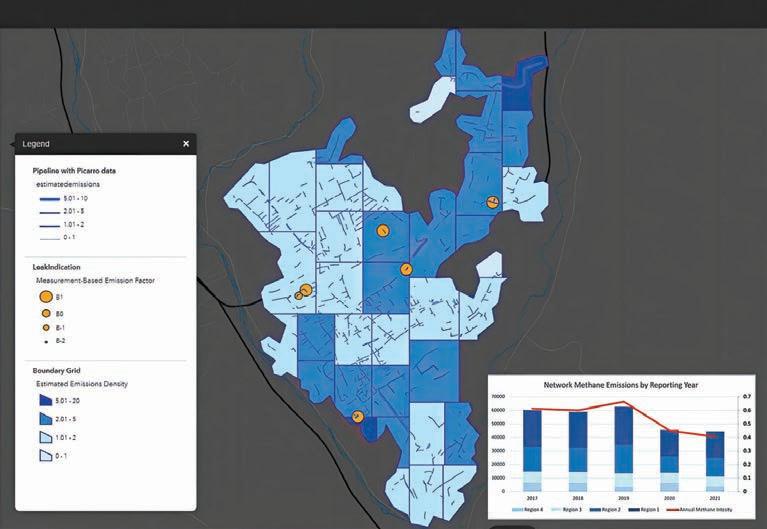
Picarro’s emissions source data—the system provides highly customisable results,” Ward said.
“This new feature from Picarro allows operators to focus on indications that matter most –focusing on risk reduction and system safety.”
With this latest release, P-Cubed provides a comprehensive solution for identifying and managing leaks with precision.
Key features of emissions360 latest release:
• Adjustable Super Emitter (SE) Threshold: A Super Emitter survey program deployed by the gas operator allows the operator to collect and aggregate gas leak and emissions data on their network while identifying only their larger more impactful emitters for follow-up leak investigations. The SE threshold is customisable, allowing users to align it with their specific operational conditions. This flexibility enhances the accuracy of SE counting on the Playbook Page, providing more precise data for decision-making.
• SE Program Planner Enhancements: The SE Program Planner now runs simulations exclusively with Super Emitter leaks. Allowing the operator to accurately plan their abatement
strategies tailored to their system metrics and operational procedures.
• Picarro Inventory Playbook Page: Follow step by step as the software guides users to truly understand their systems emissions. Increase operational efficiency and accelerate reductions by digesting data like never before.
Picarro supports natural gas operators around the globe, addressing the specific challenges they face in leak management and emissions monitoring.
With its advanced technology and user-centric features, P-Cubed offers a forward-thinking approach to managing leaks and meeting regulatory requirements.
In the evolving landscape of emissions control, Picarro is setting a new standard for excellence. By combining cutting-edge technology with a deep understanding of industry needs, Picarro is helping operators achieve significant reductions in emissions while improving overall safety and efficiency.
As the industry continues to evolve, Picarro remains committed to providing innovative solutions that support operators in navigating complex regulatory environments and enhancing their operational practices.
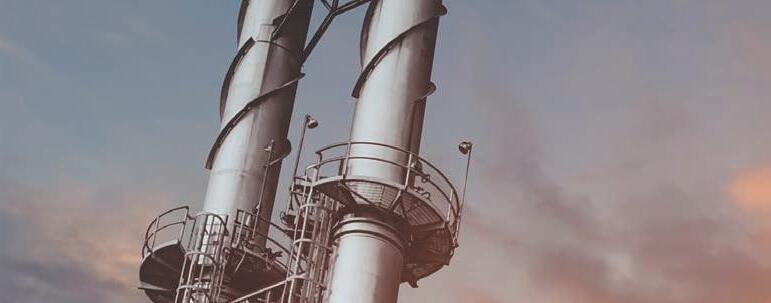



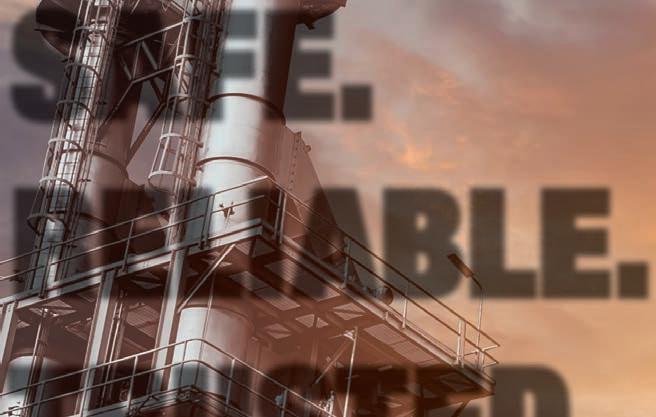


















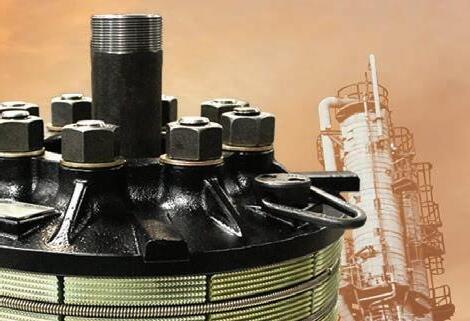







































Safe and Effective Solutions for Rapid Pipe Testing & Repairs
Confidently test open-end pipe, pipelines & pressure vessels without welding, and isolate & test flange-to-pipe weld connections with GripTight Test & Isolation plugs from Curtiss-Wright.
• Patented gripper design for increased safety in high-pressure applications
• Eliminates welded end cap procedures for testing pipe spools & piping systems
• Test flange-to-pipe welds without pressurizing entire systems
• Isolate & monitor upstream pressure and vapors during hot work
• Standard pressure ratings up to 15,000 PsiG (1034 BarG)
• ASME PCC-2 Type I, III & IV testing devices











STAND 38 & 40
ROSEN Senior Engineer Alex Hazeltine and Principal Engineer Erwin “Erk” Gamboa discuss how data analytics can be used for advanced integrity management of pipelines with cracking.
Pipeline integrity management is critical within the oil and gas industry, where failures can lead to severe environmental, economic and human consequences.
The progress made in advanced in-line inspection (ILI) tools and data analytics fuelled by the ROSEN Integrity Data Warehouse (IDW) has revolutionised the integrity management of pipelines with cracking.
These dual aspects of integrity management not only enhance the detection and characterisation of cracks but also helps inform integrity management activities, ensuring the safety and efficiency of pipeline operations.
The ROSEN IDW is a data repository that is used to store, discover, and understand high quality historical ILI and pipeline information datasets from tens of thousands of pipelines that ROSEN has inspected over multiple decades across the globe.
As the global pipeline network ages, the threat of cracking (particularly stress corrosion cracking (SCC) and fatigue) becomes more prominent. Cracking mechanisms are often complex and can be challenging to both inspect and manage. A good understanding of the cracking mechanism, careful consideration of the inspection technology, data analysis, field verifications and integrity responses are required to ensure effective management of the cracking threat.
A recognised effective method for the management of cracking threats is ILI. Ultrasonic (UT) ILI tools are typically used for liquid lines, while electromagnetic acoustic transducer (EMAT) ILI tools are used for gas lines.
Combining multiple datasets for comprehensive insights
Effective integrity management of pipelines integrates data from various sources, offering a comprehensive view of pipeline integrity and highlighting key focus areas. Key data sources (such as those found in the ROSEN IDW) include:
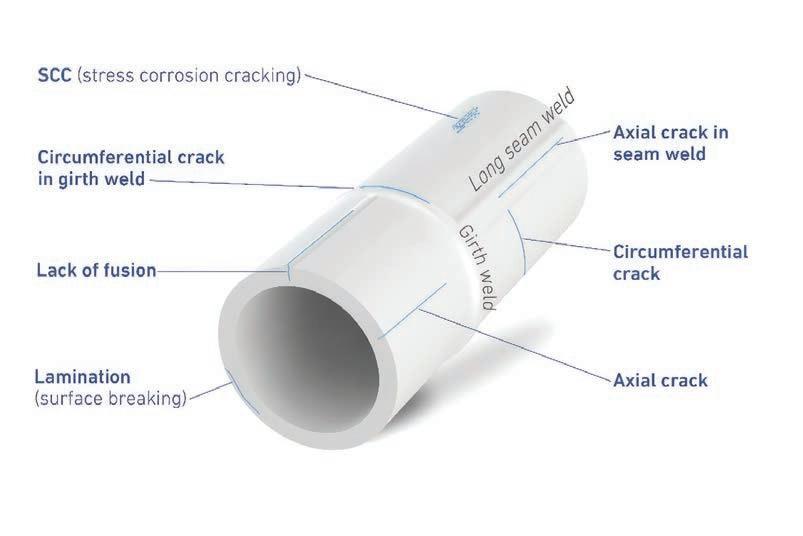
inspections to identify trends in pipeline integrity. Considering multiple ILI technologies that are not directly used for crack detection but for inspecting other pipeline threats can help improve the understanding of cracking susceptibility along the line. Historical datasets may include:
∘ Corrosion or coating disbondment surveys that can identify locations with conditions suitable for other electrochemical attack mechanisms (such as SCC)
∘ Geometry and bending strain inspections that can report areas of local (dents) and global (bending strain) changes in stress; areas of increased stress are more susceptible to cracking.
• Verification and laboratory data: Destructive and non-destructive testing data is needed to determine the specific cracking mechanism present, allowing more targeted management strategies.
• Operational data: Understanding key parameters such as pressure, temperature, flow rates, and product composition is crucial for understanding possible and existing cracking threats and how to manage them.
environmental systems (including cathodic protection) integrated with inspection data help understand conditions contributing to crack formation and growth.
• Geospatial analysis: The integration of terrain and environmental data helps to identify external factors influencing pipeline integrity, which is crucial for pinpointing high-risk areas and tailoring inspection and maintenance strategies.
Availability of high-quality data is crucial in providing confidence in data analytics insights; sufficient high-quality data is often unavailable for many pipelines across the globe. Work is ongoing within ROSEN to further leverage the vast amount of data within the IDW to fill these data gaps based on datasets from similar pipelines.
The role of data analytics in integrity management
A combination of data analytics techniques and high-quality data sources, such as the ROSEN IDW, can support a robust framework for managing pipeline cracks, providing value throughout the integrity management cycle:
• Susceptibility and predictive modelling: Aggregating data from multiple sources to
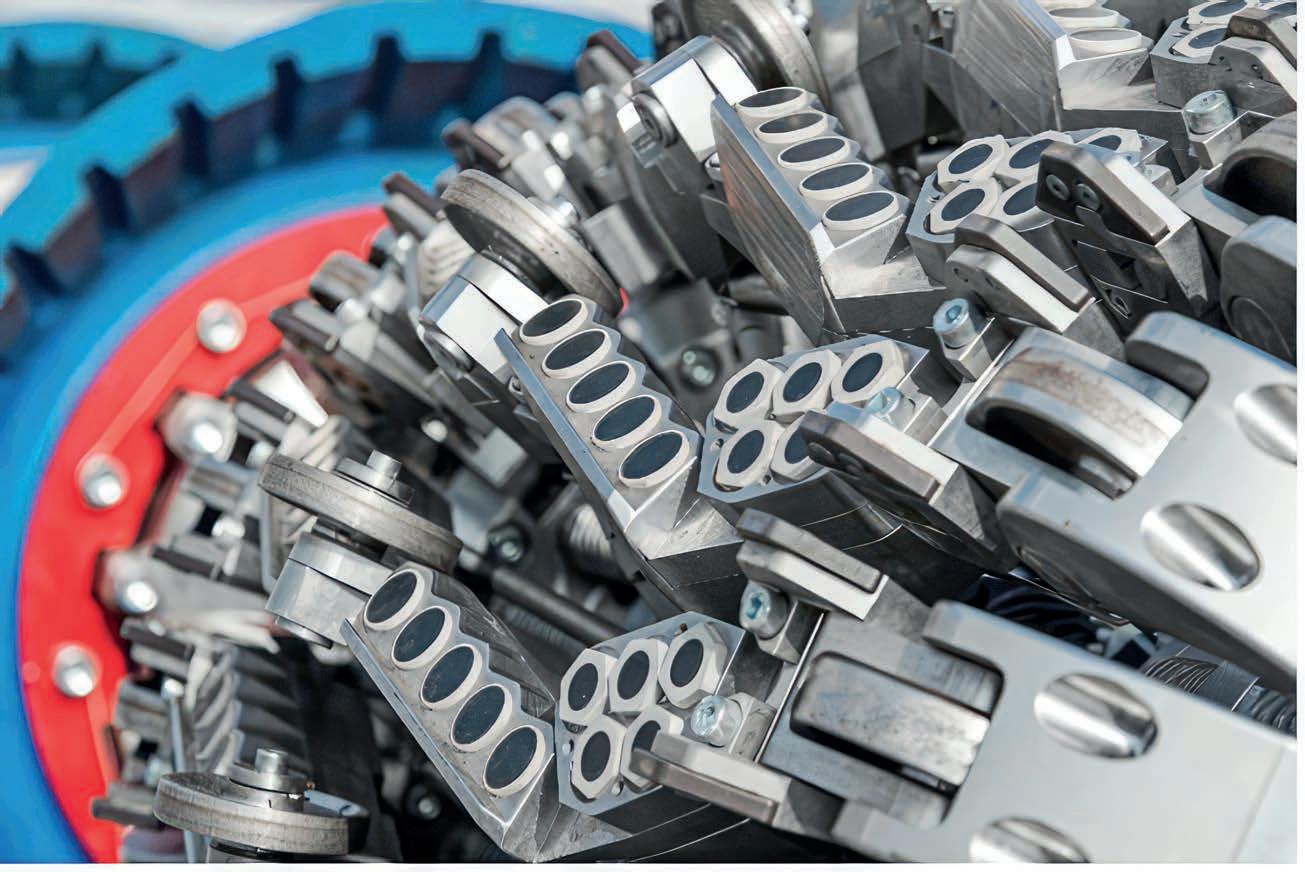
• Enhanced integrity decision-making: Access to detailed, up-to-date information allows pipeline operators to make informed
insights that enhance the overall efficiency and effectiveness of integrity management programs.

Advancements in sensor technology, machine learning algorithms, and data processing capabilities are expected to further enhance the effectiveness of decision support systems at all levels. Continued research and development will be required in addressing current limitations and unlocking the full potential of data analytics for ensuring pipeline safety and reliability.
Data analytics represents an emerging opportunity to move the needle in pipeline integrity. Leveraging data analytics allows accurate detection, predictive maintenance, and monitoring of cracking threats, ultimately enhancing pipeline operations’ safety, efficiency and profitability. As technology continues to evolve, integrating data analytics into integrity management practices of pipelines with cracking will play a pivotal role in safeguarding pipelines for years to come.
STAND 70 & 71
Energy is a global market and what happens on the other side of the world is vital for the future of Australia’s pipeline industry.
Written by David Norman, CEO Future Fuels CRC
Hydrogen in Europe has taken four sigificant steps forward this month:
• Shell confirmed it will build a 100-megawatt renewable hydrogen electrolyser in Germany, producing up to 44 tonnes a day of renewable hydrogen to partially decarbonise the Rheinland refinery’s operations. This on top of their 200MW Holland Hydrogen 1 in the Netherlands.
• TotalEnergies took FID on its 350MW OranjeWind project in the Netherlands.
• EWE confirmed their 280MW CHC-EEF project in Germany.
These three new projects will significantly push forward Europe’s capability in delivering and running major hydrogen facilities. Given the ambitious emissions targets set for 2030, more announcements should be occurring soon both for hydrogen and biomethane projects and infrastructure at significant scale.
But the fourth development is even more relevant to Australian pipeliners. The first sections of the European Hydrogen Backbone are now being installed in locations such as Rotterdam, the Netherlands, incorporating capacity for longer term volumes, more than ten times the first projects needs. This project has required foresight, planning, collaboration and support from all stakeholders, especially industry and government. The role of government is crucial, especially providing policy clarity, sufficient investment certainty and financial support to allow the delivery by private sector investment.
Germany’s recent announcements clearly specifying the need for over 9000km of such pipelines for hydrogen by 2032 are yet another such indicator of the rapid recognition of the need for such infrastructure to support industrial decarbonisation, heavy duty transport and firming of the power system.
Europe is at the very initial stages of establishing new supply chains delivering hydrogen to their key industrial centres, similar to Australia’s plans under the now expanded Hydrogen Headstart program targeting heavy
industrial centres. Key is not just the supply of hydrogen but also the need for secure customer offtakes and most importantly to our pipeline community, the necessity of connecting infrastructure. High-pressure hydrogen transmission pipelines and storage is rapidly becoming recognised as an issue to be planned and executed now, not in 10- or 20-years’ time.
Initially centred on hydrogen hubs, Europe’s planning is already racing to optimise the interconnection of these hubs, as projected demand grows and reliability and back-up of the network increases. The hydrogen networks will need to be installed and operated in parallel with existing gas networks continuing to deliver critical natural gas to communities.
The years of progressive, forward-looking research work undertaken by Future Fuels CRC’s industry and research community are time and resources well invested to prepare us. This research was exemplified last month by the launch of our Australian Hydrogen Pipelines Code of Practice (CoP). Our pivotal project to deliver Australia’s Hydrogen Pipeline Systems CoP is now complete and available to all our participating organisations. Initiated in 2021, this project is a major achievement for the Future Fuels CRC community and shows how Australian industry is leading the world in the development of best practices for hydrogen pipelines. The CoP provides engineering guidance based on current knowledge for the design, construction and operation of transmission pipeline systems transporting gaseous hydrogen or blends of hydrogen and hydrocarbon fluids.
The CoP supports the safe, reliable and efficient transportation and storage of hydrogen in transmission pipeline systems and is an initial and substantial step to the incorporation of hydrogen into the AS(/NZS) 2885 series. High pressure pipeline systems are a cost effective and reliable means of transporting hydrogen or hydrogen blends across land in large volumes. As a compressible fluid in its gaseous form, hydrogen pipeline systems also provide additional storage that could provide flexibility
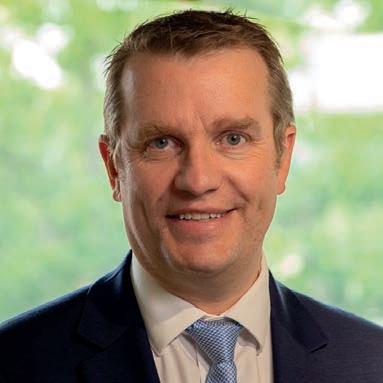
to support differences in supply and demand profiles and meet a range of end user requirements. Re-purposing existing natural gas systems to adopt hydrogen could, where practical, provide an economical method over new infrastructure development, with reduced disruption to the community and the environment.
We’d like to thank all the authors and the project team for their hard work to achieve a major engineering milestone for Australian industry: Josh Wickham, Nick Kastelein, Margaret Gayen, Sam Hatwell, Mark Lackenby, Craig Clarke, Dennis Kirk-Burnnand, Richard McDonough, Marzieh Amanabadi, Tom Amrein, Andrej Atrens, Phil Colvin, James Czornohalan, Oliver Day, Cameron Dinnis, Gilles Dour, Amir Esmaeili, Mehdi Fardi, Zachary Hill, Susan Jaques, Raj Jeyarajah, Daniel Meyer-Rodenbeck, Guillaume Michal, Mike Peoples and Klaas Van Alphen. We would also like to give special thanks to GPA Engineering and the APGA for all their support. Our participants can download the CoP from our website, and we are working with the APGA to get it quickly published wider and adopted as an industry code of practice.
As the global energy transition starts hydrogen infrastructure, Australia’s engineers and pipeliners are gearing up to meet our customers’ future needs.
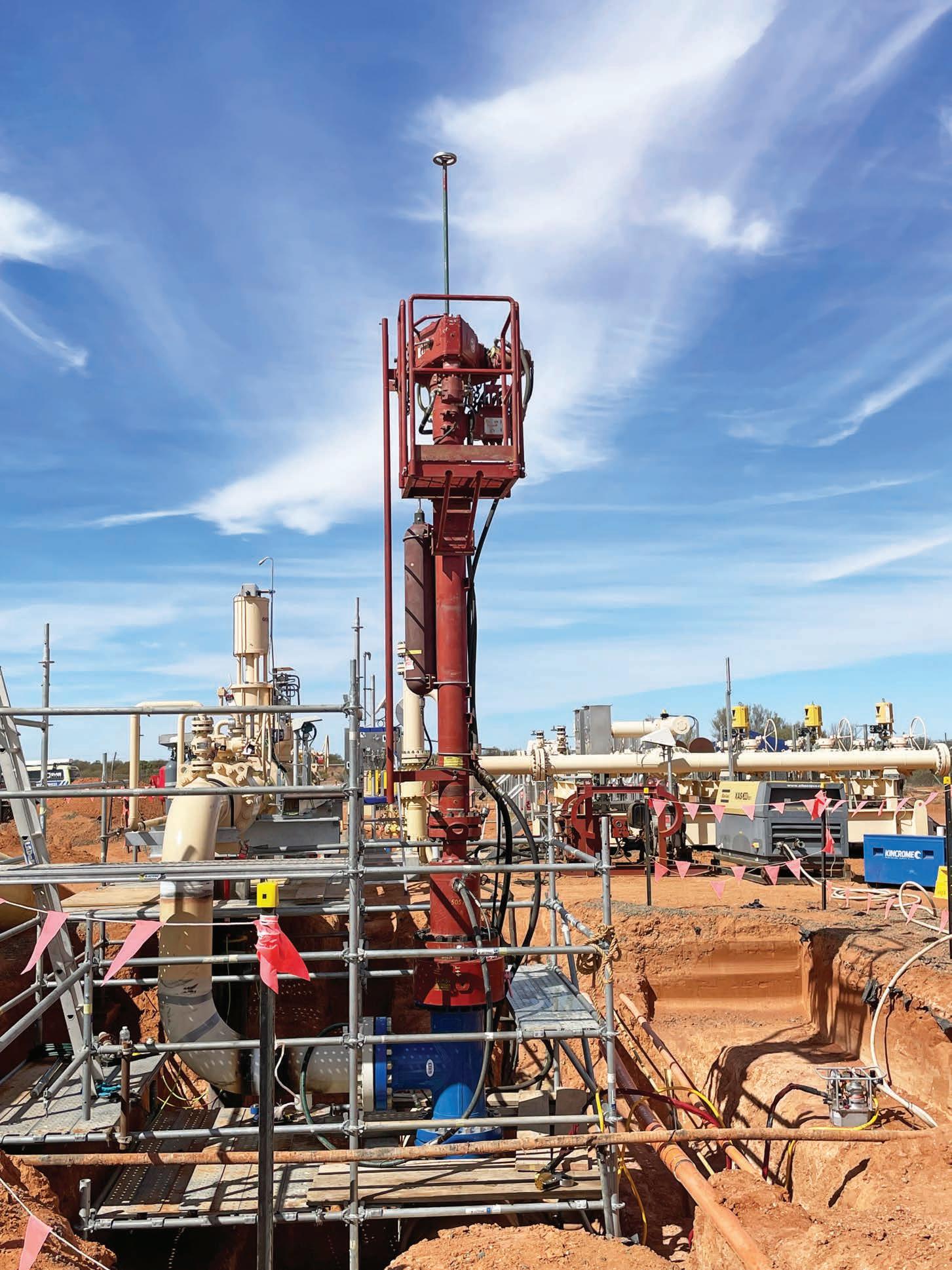



STAND 21 & 22
TFG Group is backing the pipeline industry with rapid and high-quality fabrication and in-service repair work.
Pipelines are the backbone of essential resources that help the wheels of industry turning. But while the pipeline sector is more technologically advanced than ever, no system is infallible. Ageing infrastructure, extreme weather events, and plain old accidents are just a few reasons a pipeline can become damaged.
When repairs are needed, pipeline companies need a reliable and fast solutions-provider. And that’s where TFG Group comes in.
As part of APA Group’s supplier network, TFG Group provides a nationwide team of specialised and experienced welding professionals for both fabrication and in-service repair work.
With its one-stop shop approach, TFG Group offers a comprehensive suite of services that encompass supply, fabrication, installation, live line tie-ins, and maintenance, providing a seamless experience for pipeline owners and operators.
By having a dedicated team proficient in all aspects of pipeline integrity and maintenance,

TFG Group Oil and Gas Operations Manager Norm MacKinnon told The Australian Pipeliner “Our rapid response teams have both fabrication and in-service installation capabilities and are ready to mobilise at a moment’s notice, Australia-wide.”
In-service pipeline welding is a highly
spools required for both urgent repairs and scheduled maintenance.
This includes TFG Group’s Type B repair sleeve, which launched earlier this year.
Historically, the market only offered ASME B31.8 and ASME PPC-2 sleeves, which fell short in supporting the unique needs of many pipeline projects.
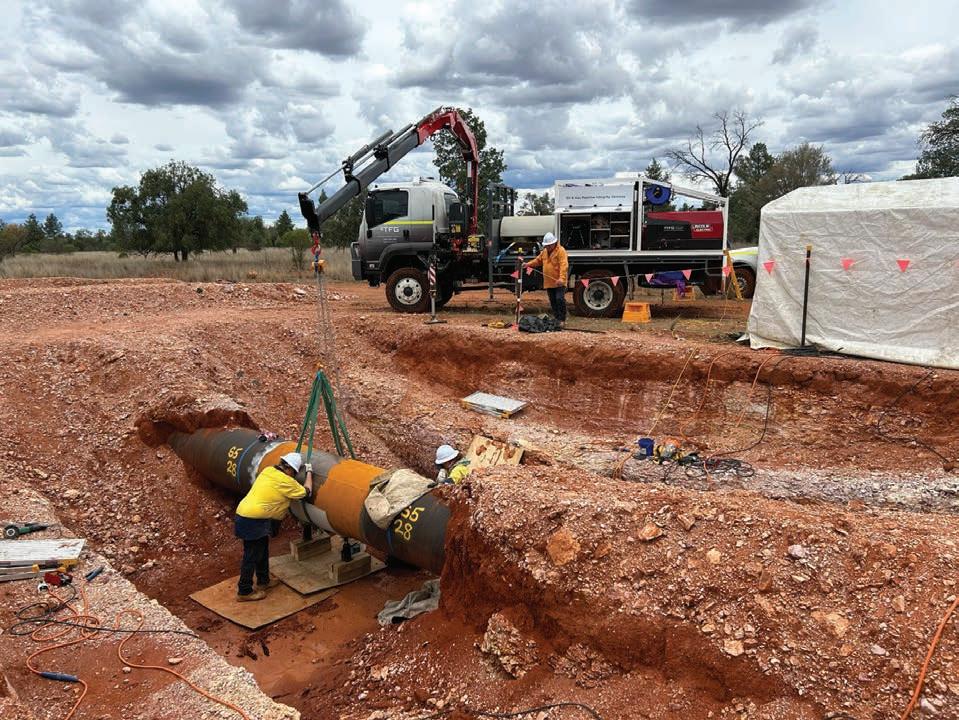
This led TFG Group to design its Type B repair sleeve, an AS2885-certified pipeline solution.
The product of meticulous engineering and testing, Type B repair sleeves provide a reliable and customised approach to pipeline repairs.
“This tailored approach caters specifically to the unique needs of the Australian and New Zealand markets and addresses nuances that generic alternatives may overlook,” MacKinnon said.
Being AS2885-certified ensures these repair sleeves align seamlessly with Australian standards, facilitating effortless integration within the domestic oil and gas sector, while also ensuring they meet industry expectations for reliability.
And never one to settle for ‘good enough’, TFG Group is expanding its capabilities into other areas such as scrape stations and pressure reduction stations, so it can better service the pipeline industry.
Time is money in the oil and gas industry, and every moment of pipeline inactivity translates into substantial financial losses for operators.
Fortunately, TFG Group’s ability to handle the entire process from supply to maintenance ensures a streamlined workflow, getting pipelines back up and running with minimal time, cost and fuss.
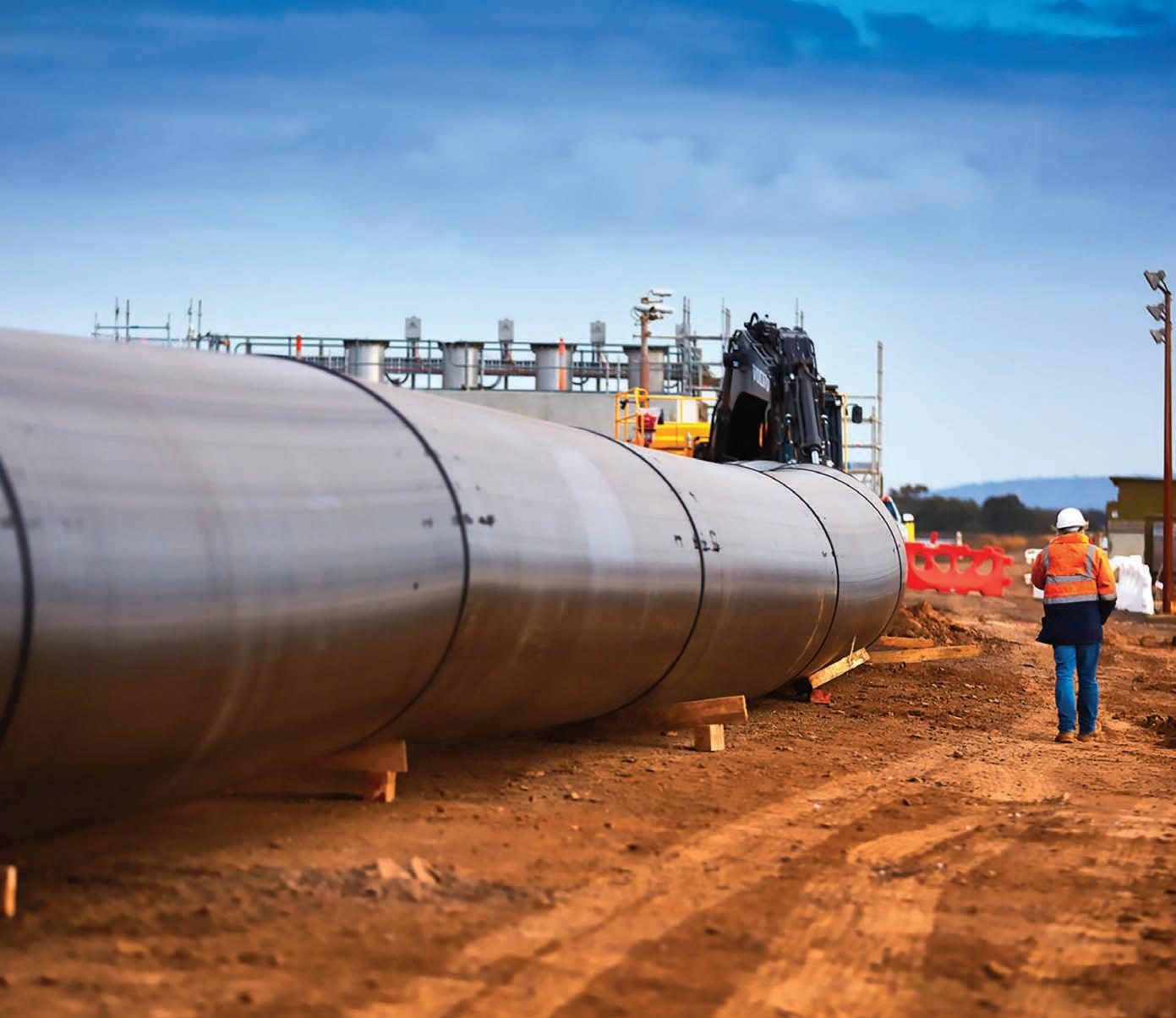
Diameter range from DN16 to DN2000


Australian Made
Locally manufactured and supplied in Australia

Iplex offers technical support for your project needs
Fabrication Available
Manufacturing capability for customised fittings
Contact us to learn more about Iplex large bore polyethylene pipes.
14
Herrenknecht AG discusses recent advancements in slurry microtunnelling methods that expand its broad application range, especially for small-diameter pipeline and underground cable installations.
Australian Energy Market Operator’s (AEMO) latest roadmap. Currently, 40 per cent of the electricity in Australia’s main grid comes from renewable sources, leading to cheaper, cleaner, and
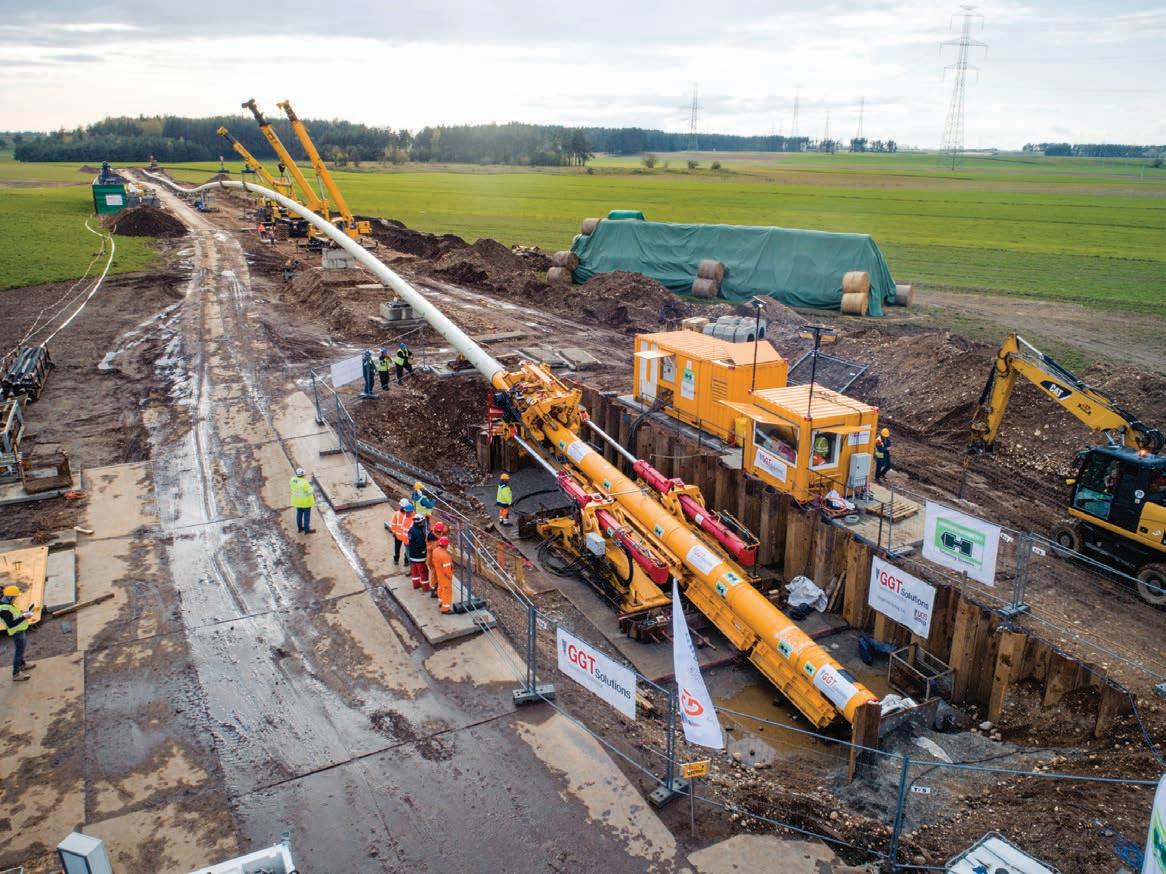
step and utilise a tunnel boring machine with
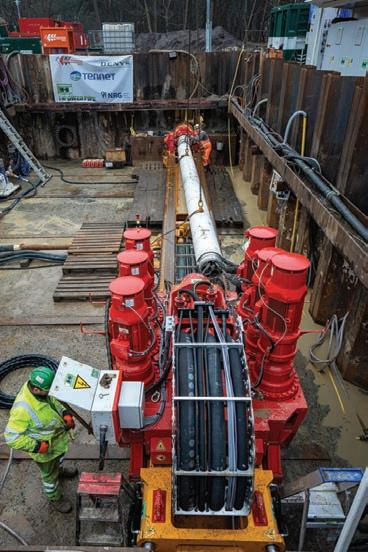
tunnel boring machines with slurry conveyance are used in these applications. The explanation of the AVN technology, with its extensive geological application spectrum, tailored cutterhead designs and hard rock concepts, further underscores its significance. Thus, slurry microtunnelling methods boast the widest range of applications, in terms of pipe material, ground conditions, diameter, installation length and depth.
Microtunnell boring machines (MTBMs) with slurry conveyance are nowadays employed in various microtunnelling processes from classic pipe jacking of concrete pipes to the installation of steel pipes, pipelines, and all kinds of HDPE protective pipes. In response to the requirements of pipeline construction and underground cable installations, Direct Pipe and E-Power Pipe have been developed based on microtunnelling techniques.
integrated into Herrenknecht AG’s AVN concept, creating the AVNS machine range. As a single slurry pump, the jet pump is integrated into the MTBM and enables a high conveying capacity simultaneously requiring very little space. Due to its compact size, it can be installed in slurry machines from approximately 20-inches and larger, resulting in drive lengths of up to currently 2000m.
Herrenknecht AG’s E-Power Pipe technology has been designed for the installation of nonpressure-resistant HDPE pipes as cable protective pipes but can also be used for smalldiameter pipelines of 10-inches to 28-inches diameter underground, wherever conventional methods, like HDD, reach their technical limits.
It is suitable for crossings in difficult, nonstable ground conditions or drilling with low ground cover, and long distances.
The two-stage process integrates aspects of the proven horizontal directional drilling (HDD) technology and of slurry microtunnelling. The broad spectrum of applications ranges from the installation of cable protection pipes for underground cables and bundles to pipelines for gas supply, district heating or the transport of hydrogen.
In the first step the AVNS Slurry MTBM and the reusable, temporary steel jacking pipes are pushed through the ground along the specified alignment by a rack and pinion jacking frame installed in the launch shaft.
After breakthrough at the target point, the MTBM is separated from the pipe string and a pullhead is then attached instead. The prefabricated product pipe lying ready for installation is then connected. Whilst the temporary jacking pipes are pulled back by the jacking frame, the product pipe is also successively pulled in.

The borehole thus remains mechanically supported the entire time. During insertion, the product pipe can be connected to the ground with the addition of backfill material.
E-Power Pipe can work in shallow depths, with high precision and in a wide range of ground conditions. Minimal earthmoving, no heavy equipment between launch and target pits, thus less noise and exhaust emissions, with less impact on the surface are other benefits of this slurry microtunnelling method.
These features are of special interest to modern pipeline projects, with landowners’ concerns, environmental protection, and strict regulation all critical considerations for a project to be realised.
To date, several projects have been executed with E-Power Pipe with an overall total length of 12km. The world record length has been achieved in the Netherlands in January 2022, where a bundle of cable casings has been installed with E-Power Pipe on a significant length of 2km.
STAND 60, 61 & 62
T.D. Williamson explores the safety procedures during a squeeze off, the most common way to isolate polyethylene pipes.
Risk is an everyday part of life for pipeline operators, and controlling risk is a full-time job.
Consider how this might play out during a squeeze off, a common way to isolate polyethylene (PE) pipes.
Squeezing involves using hydraulics or mechanical tools to compress the pipe between two parallel, rounded bars.
The process has been applied safely in gas distribution networks for decades, but there’s a caveat – the technician must be careful to follow the prescribed procedure.
Any deviation can negatively affect pipeline integrity, people and the environment.
T.D. Williamson (TDW) engineers performed various squeeze offs on 4-inch medium-density polyethylene (MDPE) pipe and evaluated the impact on the pipe using microscopy.
The test began with an ASTM F1041compliant squeeze. Before squeezing, the pipe had very smooth inner and outer walls and no visible deformities.
The wall thickness, roughly 10.8mm, was fairly consistent throughout. Consistent pipe wall thickness is critical to the structural integrity of the pipeline. Any significant decrease in wall thickness could constitute a weakness in the pressure properties and shorten the life of the pipeline.
After the ASTM F1041-compliant squeeze, there was a small amount of deformation on the inner wall as an approximately 3.7 per cent decrease in wall thickness, from about 10.8mm to 10.4mm. There was nothing to suggest the pipe suffered significant damage.
Next, TDW performed a non-compliant procedure on a different piece of the same type of pipe. Engineers squeezed and released the pipe twice as fast as prescribed.
This time, the results were very different from the first test.
There was significant plastic deformation on the inner wall of the pipe as well as a 3.8cm-long crack on the outer wall. The crack was approximately 1mm deep, or about 8.5 per cent of the total wall thickness.
In addition, the pipe’s wall thickness had
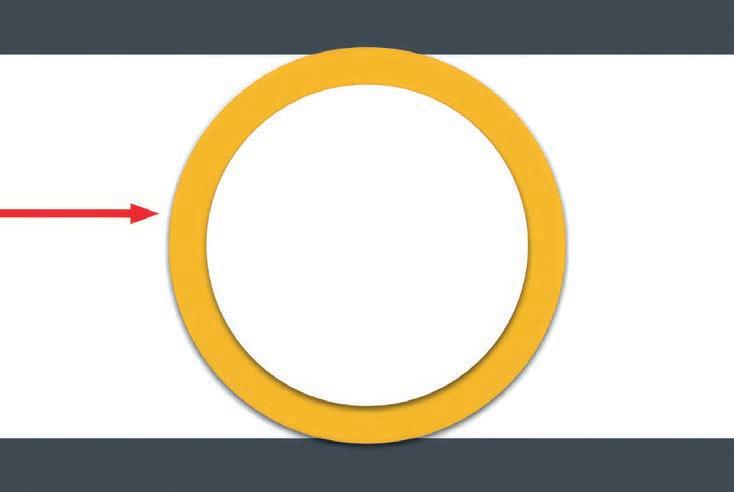

These drawings represent the way a PE pipe would look prior to squeeze off, left, and during squeeze off, right. The stress points during a squeeze off are the corners, or “ears,” in the drawing on the right.
decreased about 11 per cent, from close to 10.8mm to 9.6 mm.
This test confirmed that following the proper squeezing procedure is critical to the safety, integrity and life of the pipeline.
The squeezing procedure is somewhat tedious and requires diligence to execute properly. It can be easy to unknowingly deviate from the proper procedure.
For operators looking to further eliminate or reduce the risk associated with relying on
human behaviours, there is another option: using an engineered physical solution.
According to TDW Senior Director Hot Tapping and Plugging (HT&P) Product Line, Ed Guidry, it’s generally better to apply a physical change or engineering control to a product than to simply assume that workers will follow a procedure.
“As a service provider and original equipment manufacturer, our goal is always to eliminate or reduce risk whenever possible, and local distribution companies are no different,” Guidry said.
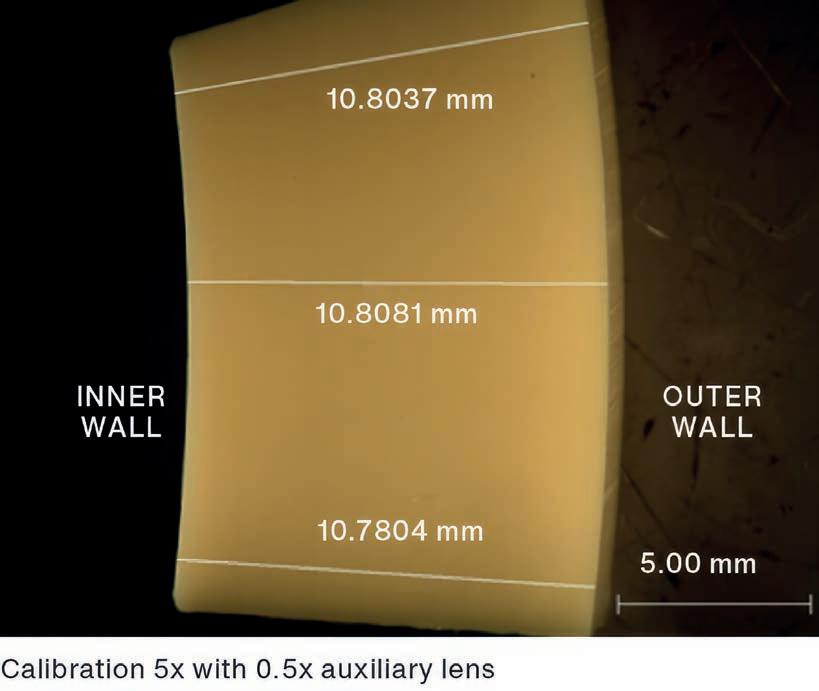
further up the strength of defences risk model TDW uses and reduce risk by adding engineering controls, we absolutely want to do that.”
Using an engineered solution doesn’t eliminate the need for proper procedures. In this case, the pipe must be prepared before the fitting can be successfully fused onto it. Preparation includes peeling or scraping the pipe with an approved tool to remove any oxidation on its outer most layers.
Thorough preparation should not be ignored; if the pipe is not peeled before fusion, it is usually because the operator has made an intentional decision to skip this step.
A suitable replacement for line squeezing
To allow an operator to perform PE isolation and branching activities through a fitting easily and safely, TDW developed the POLYSTOPP® Quick Connect system.
It incorporates multiple engineered safety features to keep the technician from using the equipment incorrectly.
For example, the tapping machine is designed with a positive stop that makes it impossible for the technician to accidentally tap through the bottom of the pipe.
locking collars prevent pipeline damage or personal injury should the technician deviate from the proper operating procedure.
As effective as the POLYSTOPP Quick Connect system is, Guidry said that, in the end, the primary concern should be the fitting.
“Since risk is all around us, safety and quality
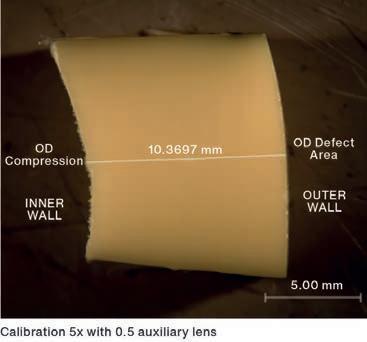
a
a slight
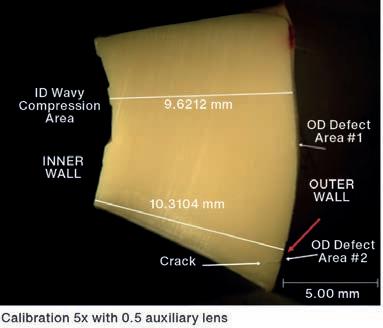
are our primary mandates,” Guidry said.
“By performing isolations with engineered solutions like the POLYSTOPP Quick Connect system, our customers can be assured that they will meet safety requirements and, more importantly, eliminate the risk of pipe damage and offer their teams the security of a truly safe work environment.”
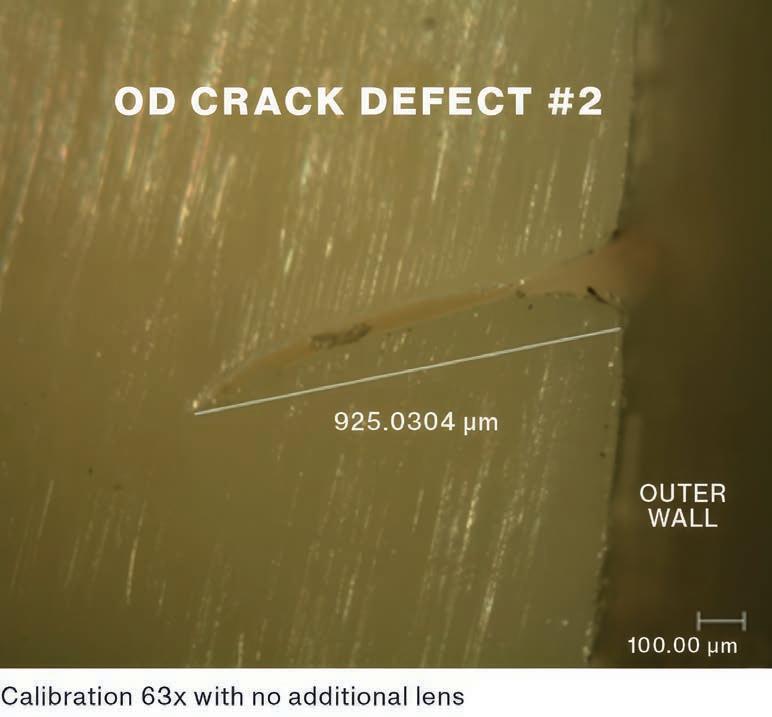
When the squeeze-off didn’t follow proper procedures, it caused a crack defect approximately 1mm deep and 3cm long.
STAND 60, 61 & 62

When it comes to providing hot tapping and line isolation services in the Australian pipeline industry, Pro Pipe Services continues to grow. Now, the company has a presence in every state and territory of Australia and Papua New Guinea.
Since its inception in 2018 into the pipeline industry, Pro Pipe Services has prided itself on service excellence, with a 100 per cent success rate on all service work and projects completed in every state and territory of Australia and Papua New Guinea (PNG).
Pro Pipe Services has seen exponential growth over the last six years, particularly in the pipeline industry. In a sign of this growth, Pro Pipe Services is set to relocate to a newer and larger state of the art facility later this year.

Recently, the company successfully and safely completed a project in Western Australia (WA) for a major pipeline operator.
The project involved the realignment of a high-pressure pipeline requiring four simultaneous isolations with double block and bleed, to allow the tie-in welds to be completed in a gas free environment. The customer was extremely satisfied and appreciative of the work and professionalism provided by the Pro Pipe Services team.
Continuing on its success journey, Pro Pipe Services also completed works at a major site in Alice Springs, Northern Territory (NT).
This job was logistically challenging due to the remote location and security clearances required to work on site. The project involved Pro Pipe Services executing eight 10-inch DN250 hot taps and four 4-inch DN100 hot taps for the isolation into a 16-inch DN400 water pipeline.

All the hot taps were completed in four days, and the customer commented on the excellent service and efficiency, whilst maintaining the highest level of safety on the job site.
As well as executing the works in WA and the NT, Pro Pipe Services has also completed works in South Australia, Canberra, New South Wales (NSW), and Queensland, as well as its usual workflow in Victoria.
The second quarter of 2024 has been an extremely busy period for Pro Pipe Services with major projects coming up towards the end of 2024, heading into 2025.
When it comes to providing hot tapping and line isolation services, Pro Pipe Services uses proven technology that has stood the test of time.
One example is T.D Williamson’s (TDW) hot tap and STOPPLE®, which has been designed,

engineered and successfully operated for many decades.
By using TDW’s hot tap and line isolation equipment, Pro Pipe Services achieves a seal that can provide the customer with a safe environment to perform alterations, tie-ins or abandonment of existing infrastructure, whether it be for a modification or repair of a pipeline.
The channel partnership between Pro Pipe Services and TDW, means the company can access more equipment, engineering, and products for its customers.
As well as providing hot tap and line isolation services, Pro Pipe Services provides other pipeline services, such as commissioning new pipelines, decommissioning redundant pipelines, pipeline cutting services, equipment maintenance and technical training.
Such was the case recently on the NSW south coast, where a new starch plant was being commissioned.
Pro Pipe Services’ highly skilled technicians were mobilised to site to commission a new
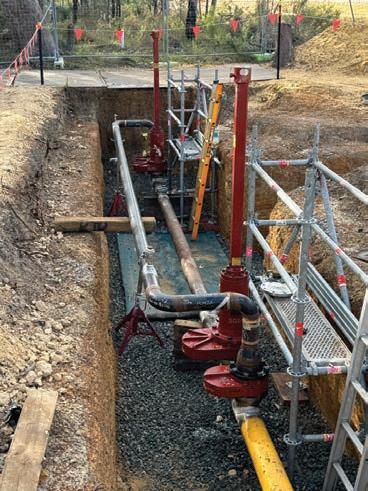
high-pressure regulator operating at 11,000kPa.
The task involved purging the new pipeline and ensuring 100 per cent gas was achieved using specialised gas monitoring equipment.
This work was all completed on time, but most importantly was accomplished safely.

Pro Pipe Services places the safety of its workers, customers and the public above all else and is committed to overcoming any challenge and completing all required works with the utmost professionalism, efficiency and safety.
For more information, visit propipeservices.com

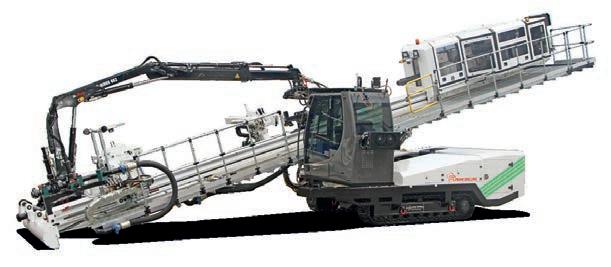

Iplex is backing the pipeline industry with high-quality polyethylene piping

The industry is increasingly turning towards polyethylene (PE) piping to help deliver water and energy projects across the world. From chemical resistance to homogenous design to lower costs across service life, PE piping offers a range of benefits over traditional piping materials.
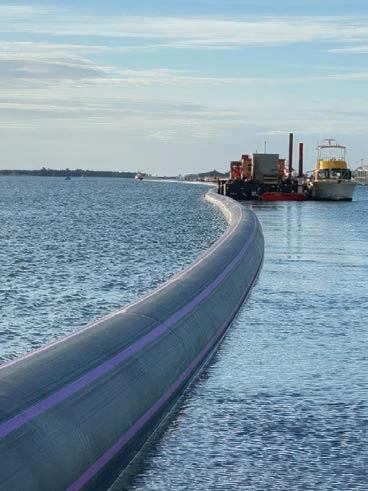
As PE piping increasingly finds its way into large-scale industrial applications, a demand for higher-capacity and larger piping has emerged. And with its expert staff and 85-year company history, who better to answer the call than Iplex?
Iplex can manufacture PE pipes with an outside diameter (OD) ranging from a precise 16mm all the way to an impressive 2m.
Iplex Product Manager for PE Pipe Systems Luke Kennedy said that the success of Iplex’s PE pipes was partly due to the extreme longevity of the material.
“Unlike other pipeline materials, which often contain rubber rings and other joining components, PE is a homogenous material, which significantly simplifies the process when it comes to chemical considerations,” he told The Australian Pipeliner
“This simplifies the design stage and also means there are fewer components that can fail during operational life of the pipe.”
Unlike metal alternatives, PE piping has exceptional resistance towards corrosion both in the actual fluid being transferred, as well as external trench conditions such as acid sulphate rich soils.
When properly installed, Iplex PE pipes can last in the ground for significantly longer durations as compared to other materials.
Kennedy said that PE has a range of environmental benefits as the material doesn’t break down in the ground, significantly reducing the chances of contamination from spillage and the piping itself.
PE pipes are also resistant to scaling, helping keep friction within the pipe to a minimum.
With benefits like these, it’s little wonder that Kennedy has seen exceptional demand for PE piping from a range of industries.
“We see a big demand for PE, particularly in civil infrastructure water projects,” he said.
“Closed water distribution systems present massive economic and environmental benefits over open channels, as well as environmentally sensitive installations.
“With a changing climate, water distribution is difficult to predict, so there is a greater need to capture and distribute water in broader networks, requiring larger PE pipes at higher pressures.”
Another allure of PE is its inherent flexibility.
“As population exponentially grows in Australia, more infrastructure is required,” Kennedy said.
“This means we’ll need more sewerage, water, electrical and gas lines, all of which can be done in PE.”
The transition from metal to PE piping, for example, has its challenges, namely that it demands a different kind of technical knowledge. Fortunately, Iplex offers much more than just manufacturing.
“Using our suite of fittings and in-depth experience, we are also able to adapt our existing products to better suit our customer’s needs,” Kennedy said.
“When you are talking about transitioning to a different type of material, you need to know that you know you have the backing of a company confidently able to assist you from the design phase right through to project management and execution.
“We’re a very safe set of hands to deal with.”
From the lifespan of its piping to the company’s expert staff, longevity and experience are a part of Iplex’s DNA.
“Iplex has many long-term employees in its
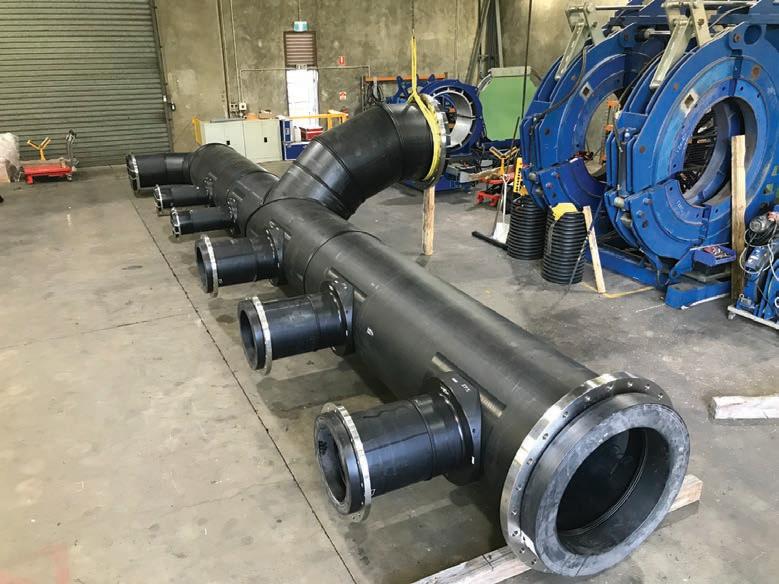
incredibly experienced,” Kennedy said.
“We have a large team of experts, and it’s not uncommon to find people with over 30 years of industry experience in the team.”
As a reliable and lower cost alternative to
many industries are turning to PE to see their pipeline projects to fruition. Though the transition can be complex, Iplex has the experience, reach, and technical know-how to guide customers through to successful delivery.

As the Australian Pipelines and Gas Association Convention approaches, Piping Specialty Supply Service is set to showcase its extensive range of high-quality products and solutions for sale and hire.
With nearly a decade and a half of dedicated service, Piping Specialty Supply Service (PSSS) has earned a strong reputation as a go-to supplier for all things piping, delivering innovative and reliable solutions tailored to the pipeline industry’s needs.
Notably, PSSS has been shortlisted for the APGA Innovation Award for two consecutive years, an accolade recognising groundbreaking advancements in the industry and highlighting innovative products, services and technologies.
PSSS prides itself on being more than just a supplier, it’s a trusted partner committed to providing exceptional service and innovative solutions.
“Our goal is to help clients succeed by offering high-quality products, expert advice, and unwavering support,” PSSS Managing Director John Wilton said.
At the upcoming APGA Convention, attendees will have the opportunity to explore PSSS’s comprehensive product range, meet the dedicated team, and discuss specific project requirements.
“We’re excited to connect with both existing and new clients and share how we can support their businesses,” Wilton said.
PSSS partners with leading brands to meet and exceed the diverse needs of its clients within the pipeline industry.
As the exclusive Australian agent for Axis Machines, PSSS offers precision tools like flange facers, clamshell pipe cutters, and bevelling machines.
“Our collaboration with Axis ensures clients access cutting-edge tools that enhance efficiency and accuracy, and also the ability to consult with the manufacturer for bespoke solutions for their machine requirements,” Wilton said.
The company’s partnership with Fast Fusion brings innovative technology that enhances safety and control in poly pipe welding, with a goal to eliminate failed fusions and increase efficiency.
“Fast Fusion’s technology reduces fusion cycle times and minimises the risk of failures, boosting productivity,” Wilton said.
agent for OMS, expanding its offerings to include advanced camera and laser inspection services.
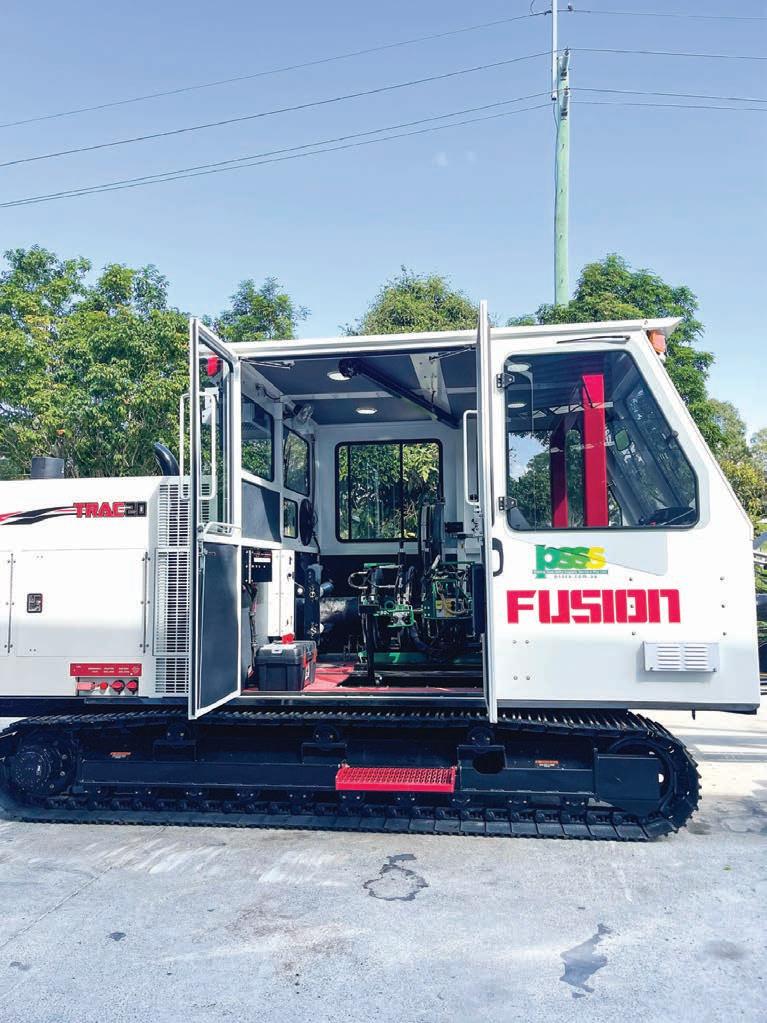
surface preparation, weld scanning, defect detection and repair, and data analysis.
“With OMS, we provide leading measurement, inspection and remediation solutions to support and deliver critical requirements,” Wilton said.
In addition, PSSS partners with ROSEN, a leader in pipeline inspection and integrity services.
“Our relationship with ROSEN allows us to offer clients cutting-edge inspection technologies that safeguard the integrity of their pipelines. Through this partnership, we can hold stock here in Brisbane, ensuring quicker access to essential equipment which helps our clients detect and mitigate potential issues,” Wilton said.
Finally, its partnership with Royal Oil and Gas,
“PSSS’ distribution agreement with Royal Oil and Gas ensures clients receive Australian-made products that meet the demanding standards of the pipeline industry,’ Wilton said.
“By supplying directly from Perth, we can reduce supply uncertainties and import costs, and also lower our carbon footprint.”
PSSS is distinguished by its dynamic team, who are always adapting and seeking new opportunities. Their commitment to deliver customised solutions provides clients with a great advantage.
With a passion for innovation and collaboration, PSSS is dedicated to meeting the unique needs of each project with attention and care.







Heath Services and Bureau Veritas Australia are working with Australian gas suppliers to discover a true measure of fugitive emission losses, utilising state of the art equipment to directly measure samples and report via innovative new software for improved analysis.
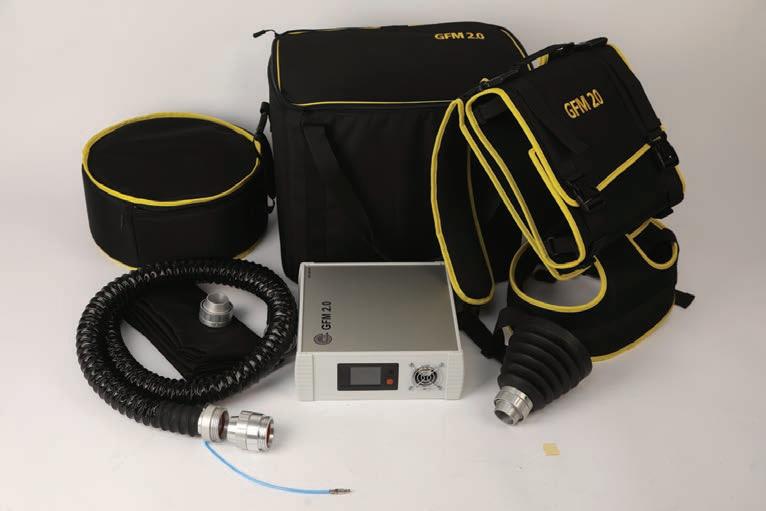
Currently, for Australian providers, committing to The Oil & Gas Methane Partnership 2.0 (OGMP 2.0) framework is voluntary.
The OGMP 2.0 is the United Nations Environment Program’s flagship oil and gas reporting and mitigation program.
It is the only comprehensive, measurementbased reporting framework for the oil and gas industry that improves the accuracy and transparency of methane emissions reporting, according to the United Nations, and is key to prioritising methane mitigation actions in the sector.
However the European Union (EU) proposes to introduce new legislation, and the rest of the world is likely to follow.
This new mandatory EU legislation proposed by the European Commission applies a time based OGMP 2.0 framework. This includes providing direction to oil and gas producers on monitoring and reporting, mitigation obligations, leak detection repair, venting and flaring requirements.
Legislation requires that by 2027 all external oil and gas importers must also abide by the same regulations as EU producers.
Leading Australian exporters are anticipating
the implementation of comparable regulations and taking practical steps to meet new standards.
Together, Heath Services and Bureau Veritas ensure field work is carried out to appropriate standards by updating inventory databases ensuring completeness and accuracy, quick and safe scanning for leaks using lasers.
They also quantify leaks using a Heath DPIR or GMI 700 series and directly measure flow rates of emissions using the OPGAL QOGI camera or the ADDGLOBE GFM 2.0 High-flow Sampler.
Large incompatible datasets from diverse origins produce complexities where amassed data is difficult to compare.
Leading methane emissions reduction strategies are incorporating digital platforms, understanding that creating a harmonised approach for global emission calculations removes variances originating in local regulatory frameworks.
Bureau Veritas is a recognised world leader in quantifying greenhouse gas emissions and providing unbiased third-party compliant emission reporting.
Bureau Veritas is working with Australian clients to combine the data that Heath are collecting, the multiple levels of the OGMP 2.0 reporting framework, and the Australia’s National Greenhouse and Energy Reporting Scheme.
The unique BV EmissionView dashboard combines multiple reporting schemes into one easy to analyse visually interactive platform that presents data compliant with regulations.
The platform lets users explore emission data with the potential to identify specific problem areas at multiple levels of granularity.
This enables industry to improve efficiency and optimise maintenance strategies, whilst reducing environmental footprint and enhancing societal responsibility.


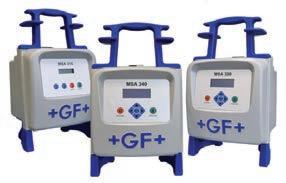
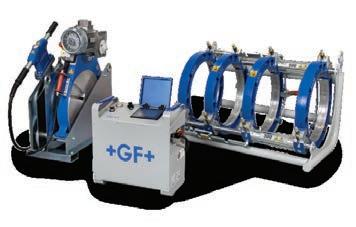
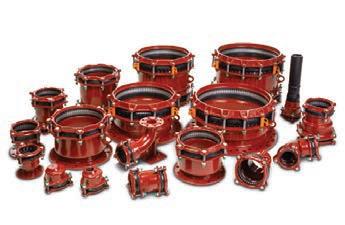

Maintenance-free and durable
For all water, gas and multiple industrial pressure applications. Benefits: corrosion-free, low weight, high chemical resistance, low overall costs and an extensive service life of installations.
Minimal training required GF produces a full range of high-performance electrofusion machines that guarantee complete documentation of the electrofusion process. Compact and portable, these machines are made from robust materials, enabling them to be used in even the harshest conditions.
Rapid, reliable and high-quality butt fusion joints GF CNC butt fusion machines minimize distortion, maintain a high level of stability and keep the butt fusion process as short as possible. All heating elements are exceptionally reliable and the units are easy to operate via an intuitive control panel.
Quick, safe and simple for maintenance and repair
The MULTI/JOINT 3000 Plus system easily connects pipes from distribution and transport grids made of a wide variety of materials with a wide range of outside diameters.
Tailored innovation, inspired by you GF delivers the creative solution for your challenge, from the first briefing via design, manufacture and testing (NDT available), up to delivery. Based on a customer’s specific needs, we can customise parts from the product library to ideally suit an application.



As Australia steps into a new financial year, the job market faces significant challenges. Peter Norman Personnel spoke to The Australian Pipeliner on why investing in environmental, social, and governance initiatives is imperative for companies in the pipeline industry.

According to the latest Jobs Report from the Recruitment, Consulting and Staffing Association (RCSA), the Australian employment market has experienced a significant downturn over the past three months, affecting multiple sectors and regions.
The data revealed a decline in job postings across most sectors, with the National Jobs Index dropping 9.5 percent in the second quarter of 2024, and a 23.6 percent decline over the past twelve months. This downturn has particularly impacted industries such as construction, infrastructure, and utilities, which recorded a quarterly decline of 20.6 percent.
Peter Norman Personnel, a major sponsor of
this year’s APGA Convention, has extensive experience in providing specialised talent in contract and permanent placements within the pipeline industry.
As job opportunities tighten, Peter Norman Personnel Recruitment Manager Kate Cuic emphasised the unique challenges for the pipeline industry, which relies heavily on large-scale infrastructure projects and skilled labour.
“Companies must navigate a landscape where there are misconceptions about the future of the gas pipeline industry, and workforce stability is threatened by reduced hiring and potential layoffs,” Cuic said.
“But downturns are cyclical, and they can
provide valuable insight into how companies can prepare for the next boom.”
Cuic stressed the need for companies to focus on retaining high morale and workforce loyalty through investing in skills development and leveraging environmental, social, and governance (ESG) best practices to ensure a long-term career in pipelines remains attractive.
“Engaging in ESG initiatives positions companies as forward-thinking leaders in sustainability right across the board – it speaks directly to workplace culture and working community,” Cuic said.
To retain high morale and workforce loyalty while improving the public perception of the gas


industry, companies should consider the following strategies:
• Enhance employee engagement: Foster a culture of open communication and collaboration. Regularly seek feedback from employees and involve them in decisionmaking processes.
• Invest in training and development: Provide ongoing education and training opportunities to help employees stay updated with industry trends and advancements.
• Promote work-life balance: Implement policies that support work-life balance, such as flexible working hours, remote work options, and mental health support.
• Recognise and reward performance: Regularly acknowledge and reward employees’ contributions.
• Corporate social responsibility initiatives: Engage in community projects and volunteer opportunities that resonate with employees.
• Transparency and ethical practices: Be transparent about the company's goals, challenges, and achievements.
“Transparent governance practices reassure employees and stakeholders that the company is committed to ethical operations and long-term sustainability,” Cuic noted.
Implementing ESG best practices can significantly boost workforce morale and loyalty. Employees are more likely to stay with companies that are seen as responsible and forward-thinking. By fostering a culture of continuous learning,
responsibility, companies can create a positive work environment.
“Employees who feel valued and see their company making a positive impact are more likely to remain loyal and motivated,” Cuic said.
Public perception of a career in gas pipelines can be improved by highlighting the industry’s commitment to ESG principles.
Showcasing the industry’s efforts to innovate and lead in sustainability can attract new talent and reassure existing employees of their career choice.
“And we shouldn’t overlook our other stakeholders throughout our supply chains as they too make up a significant part of the ecosystem,” Cuic said.
Demonstrating fairness, loyalty, and working
downturn builds trust and enables opportunities for sustainable business practices. The flow-on effect of this goodwill is the potential for innovation, cost reduction, and supply security when demand peaks.
“The pipeline industry’s proactive approach to ESG can differentiate it in the market and attract individuals who are passionate about making a positive impact,” Cuic said.
Investing in ESG initiatives is not just a trend; it is a necessity for the gas pipeline industry in Australia, according to Cuic. By prioritising environmental sustainability, social responsibility, and strong governance, companies can navigate the challenges of the new financial year, retain a motivated, agile workforce and supply chain, and improve their public image.

How women-led networking events are giving new opportunities to all in the industry.

Tbusy in the last few months.
New South Wales hosted a social networking event in May, where the lovely Kate Mason captivated the audience with her presentation of ‘Empowering Women in the Workplace.’
Victoria hosted its first net-walking with executives’ events in June. Attendees were paired with an executive from a range of companies, including APA Group, Jemena, McConnell Dowell and ExxonMobil. Conversations allowed attendees to swap career challenges and gain experience from each other.
Finally, over 40 Queensland women from various APGA member companies and roles braved particularly icy winds for their net walking event.
the Botanic Gardens.
These events focus on strengthening the WPF community and fostering connections among its members. Men are also welcome to support and attend these programs, as they provide a platform for everyone to engage and learn together.
Advertised “women” events can sometimes be perceived as creating a divide in the workforce and continuing the narrative that there is something intrinsically separating men and women in the industry. However, they play a crucial role in offering safe, accessible, and professional networking spaces for traditionally

industry. They provide opportunities for open and honest discussions about challenges specific to women, encourage skill-building, leadership, and personal development, and help everyone gain confidence in their abilities.
Additionally, these events offer unique networking opportunities, distinct from traditional ones typically held after hours, making them more accessible. They facilitate connections with likeminded individuals, providing support, encouragement, and collaboration opportunities. Featuring successful female leaders as speakers and panellists, these events inspire attendees by showcasing role models who have overcome similar obstacles.
WPF events are open to everyone, regardless of gender, to learn and develop together. The goal is to create an inclusive environment throughout the industry.
WPF is excited about the upcoming events for the rest of the year, and offers a huge thanks to the NSW, Victoria, and Queensland subcommittees for their hard work in organising and hosting these events.
WPF also expresses its gratitude to everyone who attended, who came to learn, share insights, and expand their professional network. WPF is looking forward to ending the year on a high note with its final virtual and state-based events and, of course, seeing everyone at the APGA Convention.
For more information, contact wpf@apga.org.au
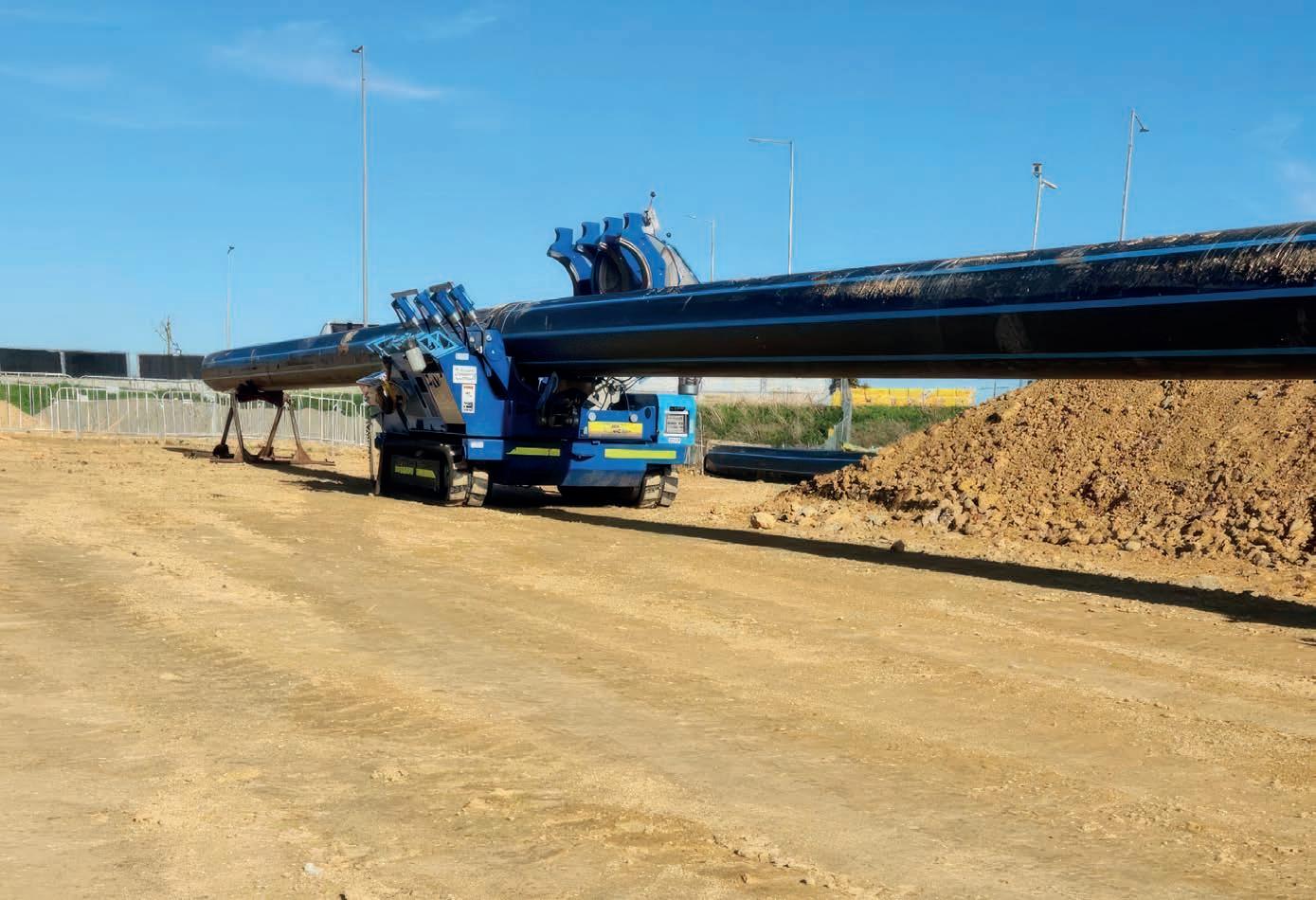

Since 2013, Poly Welding Specialists (PWS) has been a trusted leader in poly welding, offering innovative solutions and efficient project delivery for all sizes.
Poly Welding Specialists (PWS) handles projects of all sizes, with expertise in civil works, treatment plants, landfills, fire services, and communications. Leveraging custom fabrication capabilities and a skilled team from our sister company, Mako Poly, PWS is your trusted partner in poly welding.


GET IN CONTACT WITH US NOW TO DISCUSS YOUR HDPE PIPELINE PROJECT
Troy Marshall 0408 333 573
Landline 03 9708 2241
troy@polyweldingspecialists.com.au
43a Access Way, Carrum Downs VIC 3201
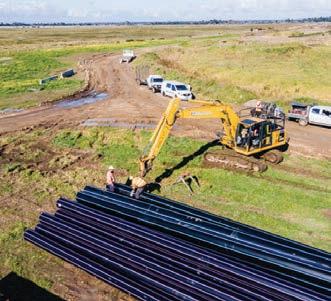

McElroy Manufacturing is set to roll out the latest technology features, updates and support options for its quality assurance tools.

For decades, McElroy has been a leader in fusion innovations and technology within the plastic pipe fusion industry. In the past year, the company has continued its commitment to digital development of its quality assurance tools with several new features to improve user experience.
The DataLogger® 7 captures and records all pertinent data related to each fusion joint, including pressures, the fusion standard being used, and the joint’s GPS coordinates.
Working in tandem with the DataLogger is the Vault™, McElroy’s powerful cloud-based data storage platform. Operators can share reports with supervisors, owners, and inspectors for closer evaluation to ensure each fused joint conforms to industry standards and is ready for service.
McElroy introduced new Vault notifications that allow operators to take better control of their fusion operations.
These notifications, tailored toward exception reporting are sent directly to the user’s Vault dashboard and can be sent to users’ inboxes as well.
An exception report highlights events that deviate from normal or expected results.
“Exception reports are invaluable from a quality control standpoint,” McElroy Digital Strategy Director Chris Zenthoefer told The Australian Pipeliner
“On our end, we wanted to make sure there was a way to highlight what exactly was done that didn’t line up with accepted best practices, and to make sure that information is delivered quickly to the correct person.”
McElroy has been committed to improving both the quality control aspect and the user experience for its users.
“Updates that we’ve made in the last year have made that data more actionable,” Zenthoefer said.
“We have millions of joints recorded in the Vault, and we know that users at all levels – from machine operators to contractors to inspectors – are finding value in knowing that they can access everything they need in one place.”
And work is still going on. In mid-2024, McElroy rolled out a new user interface for the Vault. It was designed with mobile users in mind, and improvements include better navigation, better accessibility and collapsible navigation to accommodate a variety of screen sizes.
Alongside the Vault UI update, the interface for the McCalc® Fusion Pressure Calculator was given a refresh of its own. The McCalc App, available for both Android and iPhone, allows users to quickly determine the correct fusion pressures for their job.
“In situations where the DataLogger may not
be an option, the McCalc App is a great resource for calculating the parameters you need for a successful fusion,” Zenthoefer said.
“For that reason, it’s critical to make sure that the app itself is as user-friendly as possible.”
Recently, McElroy created a “training mode” on the DataLogger 7. In training mode, a fusion is simulated without the DataLogger being connected to a machine.
“Training mode lets operators familiarise themselves with both the fusion process and with the machine they’ll be using without needing to physically go step-by-step through it,” Zenthoefer said.
“This functionality is now available on all connected equipment – meaning our TracStar iSeries line and the Tritan 560.”
Another addition to McElroy’s quality assurance line up is the McElroy Equipment Inspection app, which is now available online for Android and iOS devices.
The app allows machine owners to manage and maintain their fleets, ensuring each piece of equipment is ready to perform.
It also seamlessly guides users through the inspection with pre-populated checklists for machines and components.
The built-in DataLogger camera can be used to snap pictures of machines, allowing for easy
identification. To streamline operations, the Inspection app allows users to create customised inspection surveys for any piece of equipment they own – not just McElroy fusion machines.
Through the app, owners and technicians can share jobs and create detailed reports at the push of a button.
As the world becomes more technology-driven, McElroy has continuously connected with channel partners and users to gather feedback. That feedback has led to the addition of remote diagnostic help for TracStar iSeries and Tritan 560 machines.
If an operator or contractor is encountering a problem with their TracStar iSeries, after obtaining permission to access the machine, McElroy technicians can log in to the machine remotely and access the machine’s full CAN traffic.
To even further improve the level of support offered to Australian customers, McElroy debuted a website dedicated to Australian distributors and customers.
“Australia has been a large international market for McElroy for some time,” McElroy CEO and President Chip McElroy said.
“We saw the need for a localised site that would allow our partners to quickly access
resources tailored to their geographical location.”
Through mcelroyfusion.com.au, users can also directly contact staff at McElroy’s Australian location, and offers users a way to quickly find available poly welding courses, training, and certification opportunities in Australia.
In July 2024, McElroy introduced guided firmware updates, a process that allows users to update components controlled by firmware more easily.
The process, accessed via the DataLogger 7, will guide the operator in the correct procedure for updating machine components as new releases become available.
Updating firmware is essential to ensuring the machine is running the latest version for continued enhancements and new features.
To provide yet another level of support for users, McElroy has also published a new McElroy Help Portal at mcelroy.com/help.
The McElroy Help Portal provides videos and other resources to users to help them familiarise themselves with McElroy fusion machines, educational resources, and more – all in one common location. As the global need for actionable data and live support increases, McElroy remains committed to providing the highest level of quality in its equipment, quality assurance tools, and support.

Trenchless technology such as the Primus Line Rehab offers significant cost and time savings in the rehabilitation of fire water mains.

Femergency. Their failure can have serious consequences for people and the environment, so regular maintenance and repair is essential.
In the industrial sector, such as refineries, chemical plants or airports, functional fireextinguishing systems are a prerequisite for operating licences. To maintain this, operators regularly test their fire water pipework. Any weak points or damage must be repaired to ensure that the pipes function properly in the event of a fire.
Damaged, ageing or corroded pipelines often fail to withstand increased pressure, leading to further damage.
The use of seawater or salt water in firefighting can exacerbate corrosion, especially in steel or castiron pipes without a cement lining, rendering them unable to withstand operating pressures.
Accessibility is another challenge in industrial plants, where pipelines are often buried under roads, asphalt surfaces or concrete.
The presence of numerous other transport and utility lines adds to the complexity.
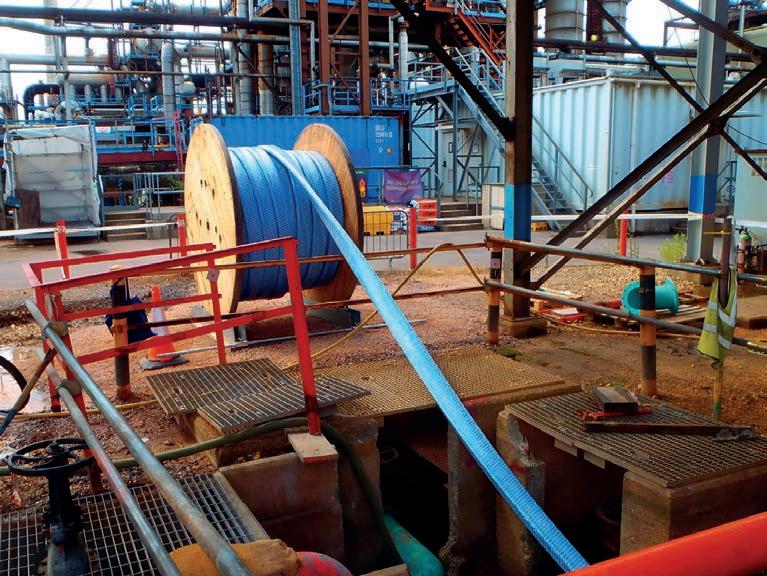
Operators also must consider permits, scheduling of repairs and the impact on operations. These factors complicate the maintenance and repair process, making efficient solutions crucial.
Trenchless systems preferred
Trenchless methods such as Primus Line Rehab offer a practical alternative. They require only small construction pits at the beginning and end of the rehabilitation section.
These pits can be created with minimal equipment, such as a pulling winch, reducing the need for large crews and heavy machinery. The insertion speed of up to ten metres per minute further minimises installation times.
In emergencies, quick rehabilitation is possible, especially when flexible pipes such as Primus Line Rehab are stored on site.
Regular maintenance can also be carried out within short-notice maintenance windows without external personnel, as Rädlinger Primus Line trains the operator’s maintenance staff for such tasks.
There are no follow-up costs after a Primus Line rehabilitation, as the product is designed for a service life of 50 years.
Its durability has been proven in various installations, such as at an Austrian airport where a refinery's fire water pipework rehabilitated with
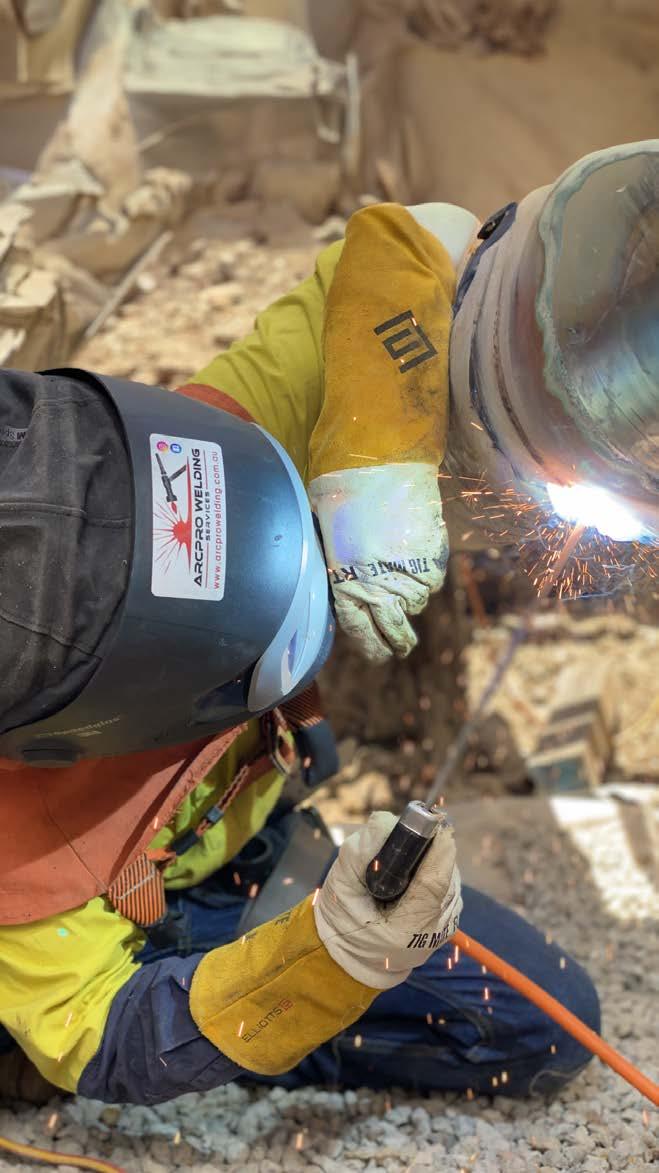
Primus Line Rehab almost twenty years ago is still functioning perfectly.
Primus Line Rehab is flexible enough to handle multiple bends within a single section, making it suitable for complex pipeline layouts.
Installation crews can adapt to site conditions, even when as-built plans are out-of-date or inspections with a camera prior to rehabilitation start are not permitted.
Safety is paramount for industrial operators, and Primus Line Rehab has undergone extensive fire resistance testing in the presence of independent testing companies.
When filled with fire water, the pipe remains functional even under direct heat, with only the outer layer showing scorch marks while the inner layer and reinforcing aramid fabric remain undamaged.
The benefits of trenchless systems such as Primus Line Rehab are reflected in significant cost reductions.
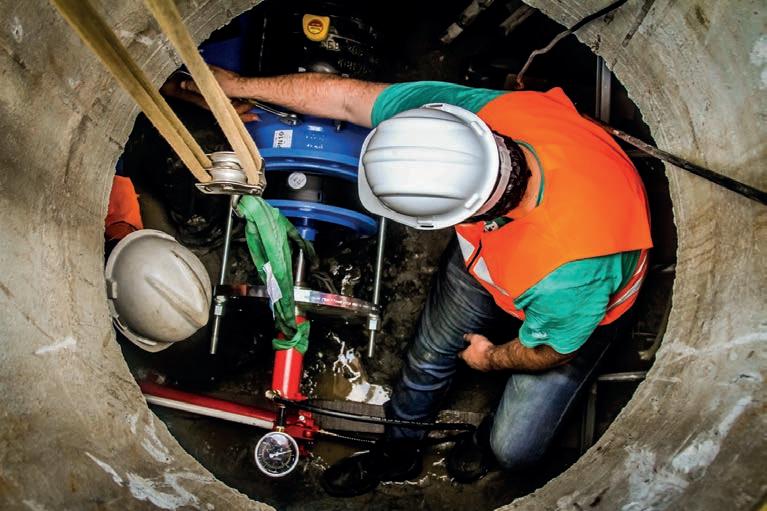
trenchless rehabilitation cut the cost per metre in half and increased the number of metres rehabilitated per month by a factor of 10 to 15 in total.
Over 13 years, the operator had accumulated repair costs in the low tens of millions for numerous leaks.

For more information, visit primusline.com
investment by a third and eliminate followup costs.
Primus Line Rehab increases efficiency, lowers capital and operating costs and extends the service life of fire water mains, making it a compelling trenchless rehabilitation option.
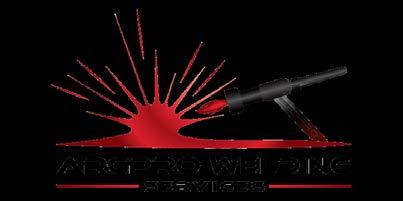
The Kutubu Refinery in Papua New Guinea faced significant challenges following a magnitude 7.5 earthquake in February 2018. Tasked with the reconstruction and upgrade of the refinery, Nacap took on the role to restore and enhance the facility. REHAB
The primary goal of the Kutubu Refinery repair and upgrade project in Papua New Guinea (PNG), was to repair and replace the damaged refinery with a new modular facility while integrating it into the existing balance of plant infrastructure.
The refinery is essential for producing fuel for field vehicles and aviation.
Nacap’s scope of work included geotechnical works to stabilise the earthquake-damaged areas, the installation of a new modular refinery process package unit, and the integration of new and reused balance of plant facilities. The engineering services and commissioning scopes were supported by Nacap’s Quanta sister company Enscope.
The project also involved upgrading existing plant components, constructing new storage tanks, crude oil supply line from the Central Process Facility (CPF) to the refinery, and enhancing the truck loadout gantry.
“The project awarded to Nacap was for engineering, procurement, construction and commissioning and this presented technical challenges around trying to work within the existing brownfield site, the whole reuse and integrity assessment part,” Nacap Project Manager Joseph Falzon said.
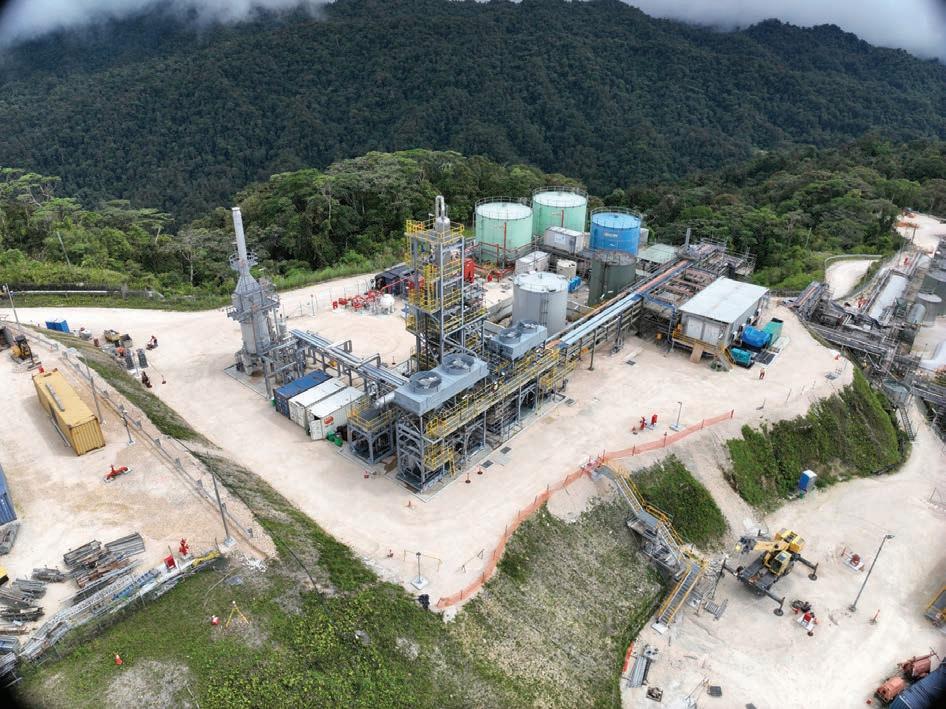
In addition, due to site’s remote location, several technical challenges were encountered.
“It’s a challenging environment,” Falzon said.
“There’s a lot of unstable areas and the footprint that we had to work within was a set footprint that we couldn’t expand out from.”
Additionally, the logistics of transporting materials to the site were complicated by the limited ability to airfreight items and the 800km journey from Lae to the site, which takes four to five days.
Key to Nacap’s success was partnering with the landowner companies that not only enhanced its ability to deliver a complex project, but also knowledge sharing, skills transfer, and the cultural exchange that enriched both professional and personal development of those involved in the project.
The project provided Nacap the unique opportunity to leverage its geographic footprint and align teams across Australia and PNG.
subsequent exchange of PNG staff into Nacap’s operations in Australia, broadening their skill set and nurturing leadership qualities to help create the future leaders of our PNG business.
Due to these technical challenges, effective collaboration with key vendors and client stakeholders was crucial.
Falzon emphasised the importance of this collaboration.
“We had close collaboration with key technical stakeholders because of the complexity of the project,” he said.
“That includes working closely with our valued client, Santos to ensure the facility is handed over and meets their expectation.”
McTavish agreed and described PNG as a hugely rewarding and challenging place to work, from remoteness to the logistics.
“There’s a lot of integration required with our client team and key vendors, just to integrate with the existing site,” he said.
“We have a very good relationship with Santos as a valued client.”
During the detailed design phase, the Nacap team focused on value engineering and identifying cost-saving opportunities.
Nacap was able to optimise various aspects of the project, including high voltage supply, slope stabilisation, valve rationalisation, and simplifying foam injection units, resulting in substantial cost savings.
Nacap’s proactive approach to long lead procurement also played a critical role in the project’s success.
Early engagement and alignment with vendors ensured that equipment specifications met the necessary standards, allowing delivery of critical items such as the Electrical Equipment Room, API 650 Tanks and API 610 Crude Pump Skids.
The Kutubu project demonstrated Nacap’s ability to deliver complex multi-disciplinary EPC facility project in challenging environments.
“It’s a once in a lifetime opportunity to work on a niche project rebuilding an oil refinery in the middle of PNG,” Falzon said.
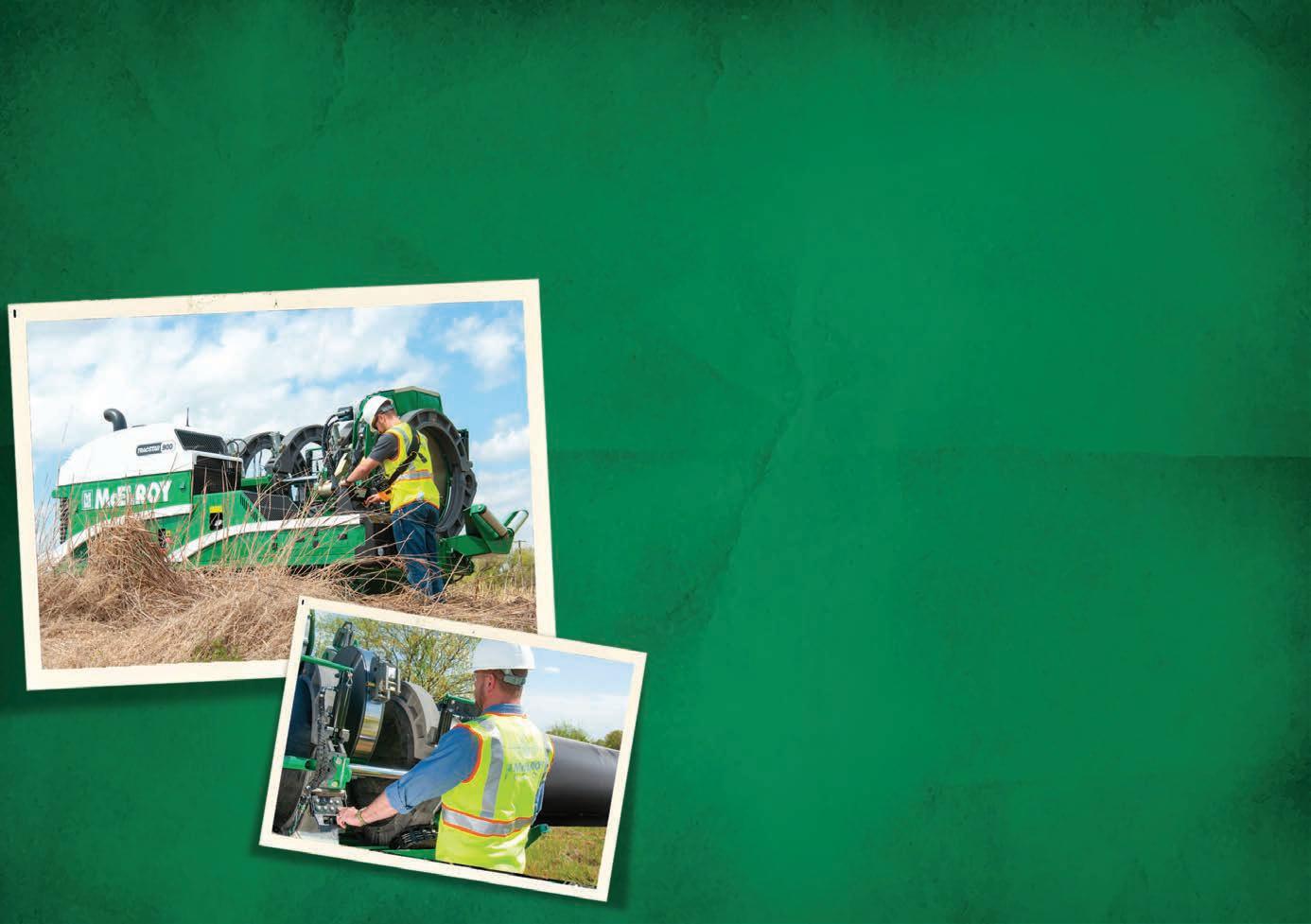
“The project involved intricate control systems, electrical instrumentation, high voltage tie-ins, and extensive modification work, including the installation of new pipe work and structural steel all of which were fabricated on-site.”
McTavish emphasised the project’s significance in showcasing Nacap’s capabilities.
"It’s a demonstration of our capability,” he said.
“We strive to be known for being able to deliver very challenging and complicated projects.”
“When you add in all of the layers of the greenfield site, brownfield site, earthquake damage, remote location, multi-national workforce, from all over the world and every discipline, I think it really shows what we can do.”
The Kutubu project provided valuable lessons and best practices for Nacap, with continuous improvement being a key focus.
“Continuous improvement can be buzzwords, but we’ve learned a lot,” McTavish said.
“It’s really helped to start aligning our strategy of what differentiates Nacap in delivering a project of this complexity.

The works involved geotechnical works, the installation of a new modular refinery process package unit, and the integration of new and reused balance of plant facilities.
“We’ve taken a lot of lessons away from this and it’s really helped to firm up where we sit.”
The experience reinforced the importance of client relationship and focus, effective stakeholder collaboration, meticulous planning, and a proactive approach to procurement and value engineering.
These lessons have helped Nacap refine its
strategies and strengthen its position as a leading contractor capable of handling complex and demanding projects.
Despite the numerous challenges posed by the earthquake, remote location, and existing infrastructure, Nacap successfully restored and enhanced a critical component of PNG’s oil and gas industry.

Mcelroy has a LongHeritage
of redefining pipe fusion. Throughout the years, we’ve streamlined jobsite efficiency and safety with equipment like the TracStar® – the world’s first self-contained, track-mounted fusion machine in 1997. Today, the latest evolution of the TracStar line, the TracStar iSeries, transforms the jobsite once again by offering customized levels of operator control, built-in data logging, and more.
Learn more about the TracStar iSeries and see the entire fusion machine lineup at
Farming, cattle grazing, and the construction of dams have all contributed to changes in the waterways of the Lower Yarra River Floodplains in Melbourne, Victoria.
Melbourne Water undertook to re-water the Annulus Billabong to conserve many indigenous plants and birds. The Argyle Reel System equipped with Waterlord layflat hose from Crusader Hose was the temporary pipeline solution that helped deliver the project.
The waterways around Melbourne’s Lower Yarra River Floodplains have gone through many changes with urbanisation. Areas that were once natural habitats for indigenous plants and birdlife were converted to support farming, cattle and horse grazing.
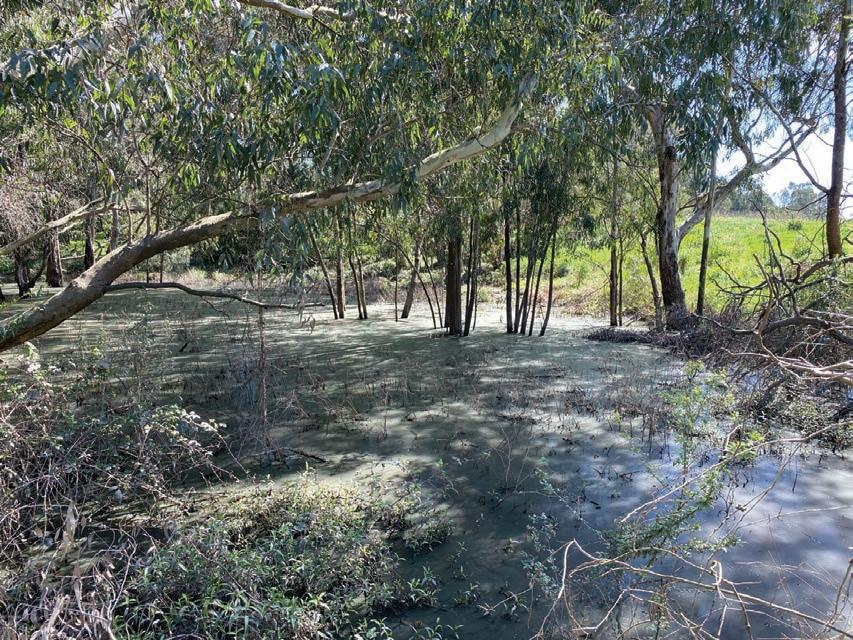
The regular flooding of rivers by rainfall, which is responsible for the life cycle of billabongs, was affected by the construction of the Yarra Dam in the 1950s and climate change. As a result, many billabongs located in the Yarra Flats dried up slowly, affecting the delicate ecosystem. The Annulus Billabong was one of these.
In the 1980s, efforts were undertaken to rewater the billabong using windmills and pumps. An island was created in its centre, promising a haven for birdlife. Over time, however, the trees around the windmill grew too tall, and funding ran out.
The Melbourne Water Healthy Waterways Strategy listed the Annulus Billabong as a key waterway within the wildlife sanctuary and conservation area. Maintaining water levels is critical for the survival of many indigenous
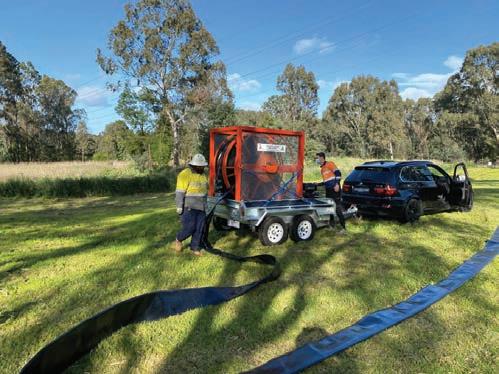
plants, attracting birds and restoring the indigenous landscape. The re-watering of the billabong was commenced in October 2020 by pumping water from the Yarra River and bringing various organisms into the billabong ecology
Layflat hose was chosen for the temporary pipeline for several reasons. Wound onto reels, smaller, lighter vehicles are used for their transport. Flexible layflat hose takes on the contours of its environment, reducing the need to dig or alter the terrain. The large diameter Waterlord hose was a seemingly perfect solution for this re-watering project. However, knowing that unrolling and rerolling flexible pipelines is physically demanding, the engineers at Crusader Hose dedicated significant effort and consideration to developing a solution. The blueprint for a compact reel system was designed.
“Knowing the challenges of unrolling 200m lengths of eight-inch Waterlord hose, we were keen to design a reeling system to remedy the situation. Our engineering experts designed the Argyle Reel System,” Crusader Hose Managing Director Francois Steverlynck said.
“The main objective was to create a reel system that was agile and efficient.”
Coates Hire Operations Manager Thys Stryker, who undertook the project again in September 2021, was more than pleased at the ease with
which the Argyle Trailer-mounted Reel System deployed the hose. Before, it took a whole day to roll out the hose manually, but with the reeling system, it took only three hours with much less physical strain. The labour force was delighted.
“This ingenious reeling system can quickly and easily deploy up to 200m of hose in a fraction of the time it would take to do it by hand,” Stryker said.
“We are confident this will make the use of layflat hose a lot more desirable for many municipal works.”
Apart from the reel system's efficiency in deploying and retrieving the pipeline, the aim of being mindful of and concerned for the environment cannot be dismissed. No larger than a trailer, the Argyle Trailer-mounted Reel System fulfilled the requirement of reducing the potentially detrimental effect of using heavy trucks to bring in long lengths of poly pipe, the historical mainstay of water transfer.
Nimble, lightweight, and small, the reel system was strategically placed without much disturbance to the area. The flexible pipeline was then laid out alongside and around the delicate flora. A winning solution for everyone involved.
The Annulus Billabong re-watering is now scheduled to be carried out every two years.
The Argyle Reel System with Waterlord layflat can reduce the time and effort to complete water-transfer projects. It’s proved itself as the system of choice.
For a solutions-driven approach, turn to Crusader Hose.
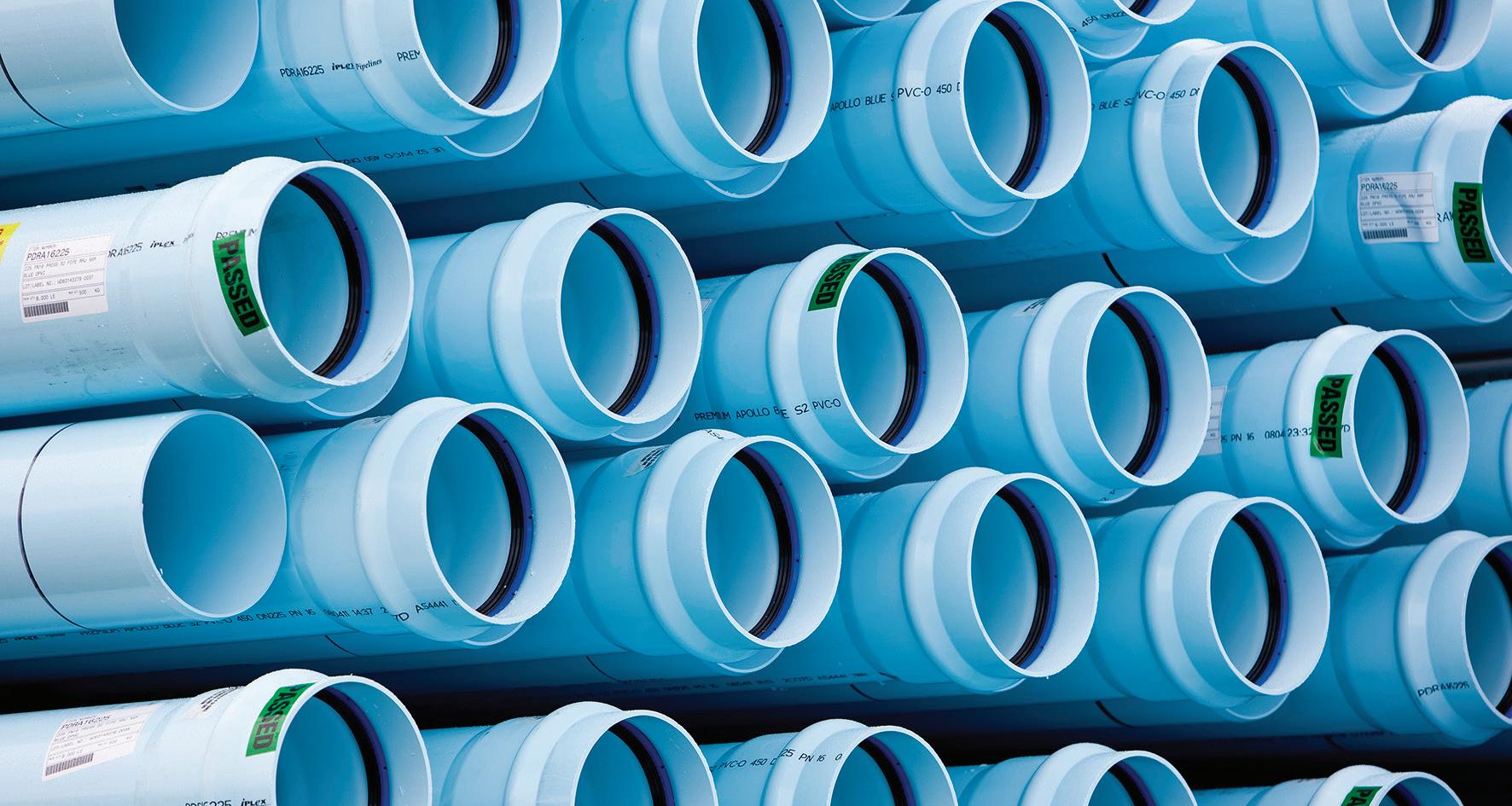
11th – 13th November 2024
Intercontinental Sydney

Come and join the 2-day global networking event from the 11th – 13th November 2024 at the Intercontinental Sydney showcasing a range of technical papers presenting by pipe experts from both Australian and around the world.
Full program is now available!
30 papers will be presented across 2 days covering topics including:
check Global Sustainability Insights
check The Environment and Water Security
check Design
check Innovation
check Hydrogen
check Recycling
check Case Studies
If you are a manufacturer or supplier of plastic pipes and fittings, equipment or a specifier, engineer, designer or end user of plastic pipe systems, this is the conference for you!


Visit ozpipe.com.au to find out more information on the conference program, read abstracts, register and much more!
For 40 years, Vector Magnetics has designed sub-surface navigation technologies, enabling the delivery of highly complex drilling projects around the world.
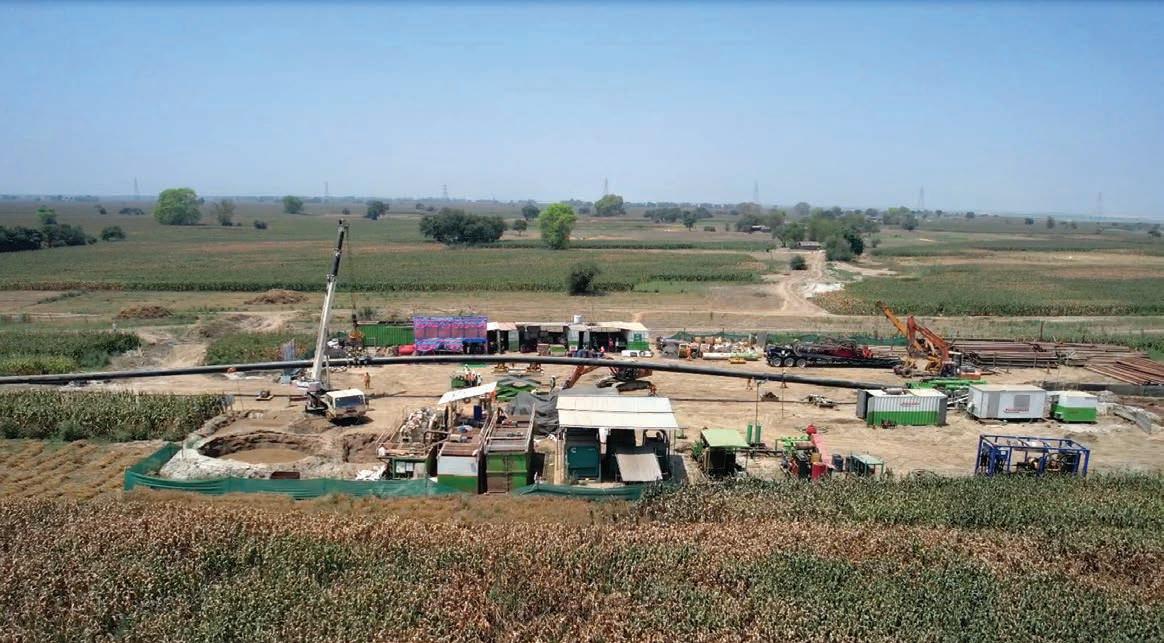
Vmethod in partnership with Prime Horizontal in 2000, which is currently playing a key role in delivering a major oil pipeline in India.
Numaligarh Refinery Limited is in the process of laying a 1635km cross country pipeline from Paradip Port in Odisha to its refinery Numaligarh, Assam, India.
The pipeline is proposed to run from Paradip port, crossing through five states before terminating at the Numaligarh refinery in Assam. The 26-inch pipeline will enable the expansion of the refinery from three million tonnes per annum to nine million tonnes per annum as part of Numaligarh Refinery expansion project (NREP).
The pipeline route crosses all the major rivers in Eastern India including the Ganga, Jia Bharali, Subansiri, and Brahmaputra via HDD. The longest of those crossings under the Ganga River was awarded to M/S Trenchless Engineering Services.
Completing this dual 4027m crossing was a technical achievement made more difficult by the location as well as a narrow weather window in which they needed to complete the crossing.
“Since the location was prone to floods, we had a very small window to enter and execute,” Trenchless Engineering Services Managing Director Vipin Gupta said.
Further, the location was 9km off the blacktop road into a remote village, and the road distance between the rig side and the pipe side was a
a single trip.
As a result, the work was performed in the dry season from January to May. The first pilot was commenced on 25 January 2024 using two American Augers DD1100 rigs. The DD1100 is one of the largest rigs in the American Augers lineup with 500 metric tonnes of push and pull capacity.
Despite the immense rig power available, the crossings were designed to use the intersect method rather than as a single push from entry to exit. Intersecting at a specific point in HDD is a technique often used for long or complex bore paths, especially when dealing with installations that exceed typical drilling lengths of over 2000m.
The intersect method provides several benefits, including:
• Increased accuracy: Intersecting allows for greater control and accuracy in the drilling process. By planning to meet at a designated midpoint or specific location, the drill path can be managed more precisely from both ends, which is crucial in long bores to ensure the paths meet accurately.
• Reduced risk: Drilling from both ends towards a midpoint can help mitigate risks associated with long horizontal drills such as excessive torque, drag, and pipe sticking. It also allows for better management of potential issues
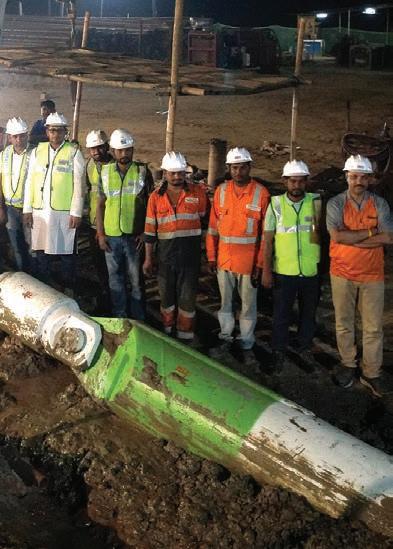
like fluid pressures and borehole stability, since adjustments can be made from either end if problems are detected.
• Equipment limitations: HDD rigs have limitations in terms of the length of the drill pipe they can push or pull due to friction and the power of the rig. By intersecting from two sides, each rig only needs to cover half the distance, making very long crossings feasible without exceeding the capabilities of the drilling equipment.
• Geotechnical considerations: The presence of difficult geologies may limit the feasibility of HDD. The intersect method enables the driving of conductor casing near surface while traversing these zones, then intersecting during a tangent section to complete the pilot bore.
For the Ganga River crossing, Trenchless Engineering Services was tasked with installing two separate pipelines within a narrow 18m right of way. Both a primary 26-inch gas line as well as a parallel 6-inch accessory line was to be installed via the HDD intersect method with just 6m separation.
To guide them across such a complicated crossing, Trenchless Engineering Services chose the ParaTrack HDD Guidance System. ParaTrack offers the trenchless industry’s widest range of guidance technology, allowing contractors to confidently complete installations of any size.
From that expansive guidance toolkit, Trenchless Engineering Services selected the ParaTrack Steering Tool, supplemented by P2 AC Magnetic Guidance, a pressure module and magnetic intersect technology.

Vector Magnetics’s ParaTrack HDD Guidance System, ParaTrack Steering Tool, and P2 AC Magnetic Guidance, are helping to deliver the project.
As the crossing was scheduled during the dry season, river levels were at their lowest, and the surface was accessible for all but 1000m of the right of way. This allowed for the installation of a series of P2 AC Magnetic Guidance coils which were used to verify the surveyed position calculated by the Steering Tool.
The intersects were planned to take place after crossing the Ganga River from the Paradeep side, utilising P2 AC Magnetic Guidance to provide the accuracy required to connect the pilot bores. As each rig’s guidance system references the same external control point, the Intersect can be
performed quickly and reliably, without the need for specialised (and costly) intersect equipment.
After the successful intersection, the 12 ½-inch pilot was reamed in three stages to 20-inch, 30inch and 38-inch for the final pass.
“The crucial thing was to maintain returns up to 4km, so that cutting flow was maintained,” Gupta said.
“Our engineering team designed special reamers for dual-sided pumping, easing the mud purging process and handling the loads efficiently.
“Using two 600 GPM pumps in tandem for reaming, achieving a flow rate of nearly 800 GPM,
was crucial in speeding up the drilling process and managing the cuttings.
“Torque was limited to 80 kilonewton-metres and the 26-inch pipeline was successfully pulled in on 12 April 2024, ahead of schedule, and a world record for the distance at just 76 days.”
With the success of this HDD, Numaligarh Refinery is now focused on completing the remaining HDDs over the next several months, thereby completing all major HDD crossings of its 1635km-long Paradip Numaligarh crude oil pipeline. Construction and commissioning of the project is expected to be complete by mid-2025.
GF Piping Systems is able to check the integrity of butt welds and electrofusion welds in pipelines.

With its non-destructive testing service, GF Piping Systems is ensuring the integrity of welds and plastic piping.
Here’s an obvious but critical fact about pipelines: they’re a lot easier to service before they’re buried.
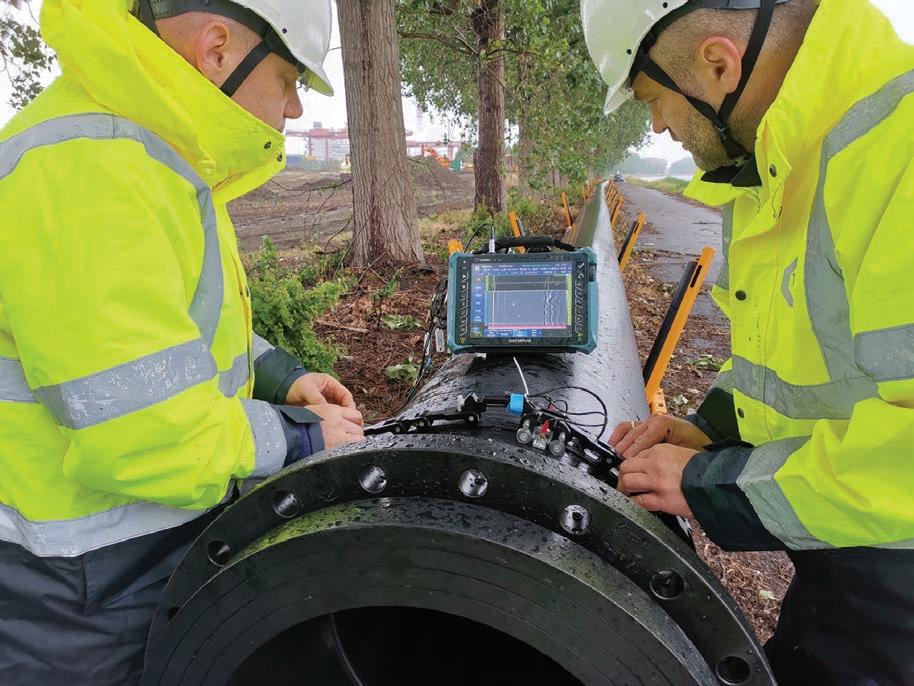
Underground pipelines can happily function for over 50 years, but a single leak caused by a dodgy weld or poorly constructed pipe is a veritable financial headache. On top of that, leaks can have serious consequences for the surrounding community and environment, which, in addition to causing serious harm, also attracts heavy fines from regulatory bodies.
All of this is to say that project managers need certainty that what they’re putting in the ground will stand the test of time.
Fortunately, GF Piping Systems is providing exactly that.
Utilising its ultrasonic non-destructive testing (NDT) field services, the installation company or end customer can quickly, reliably, and cost-effectively provide longterm pipe condition assessments in the field. This allows the company to check the integrity of butt welds and electrofusion welds for issues such as dirt, sand, or lack of bonding.
GF Piping Systems also offers Ultrasonic NDT services within its global network of pre-fabrication workshops to meet customers’
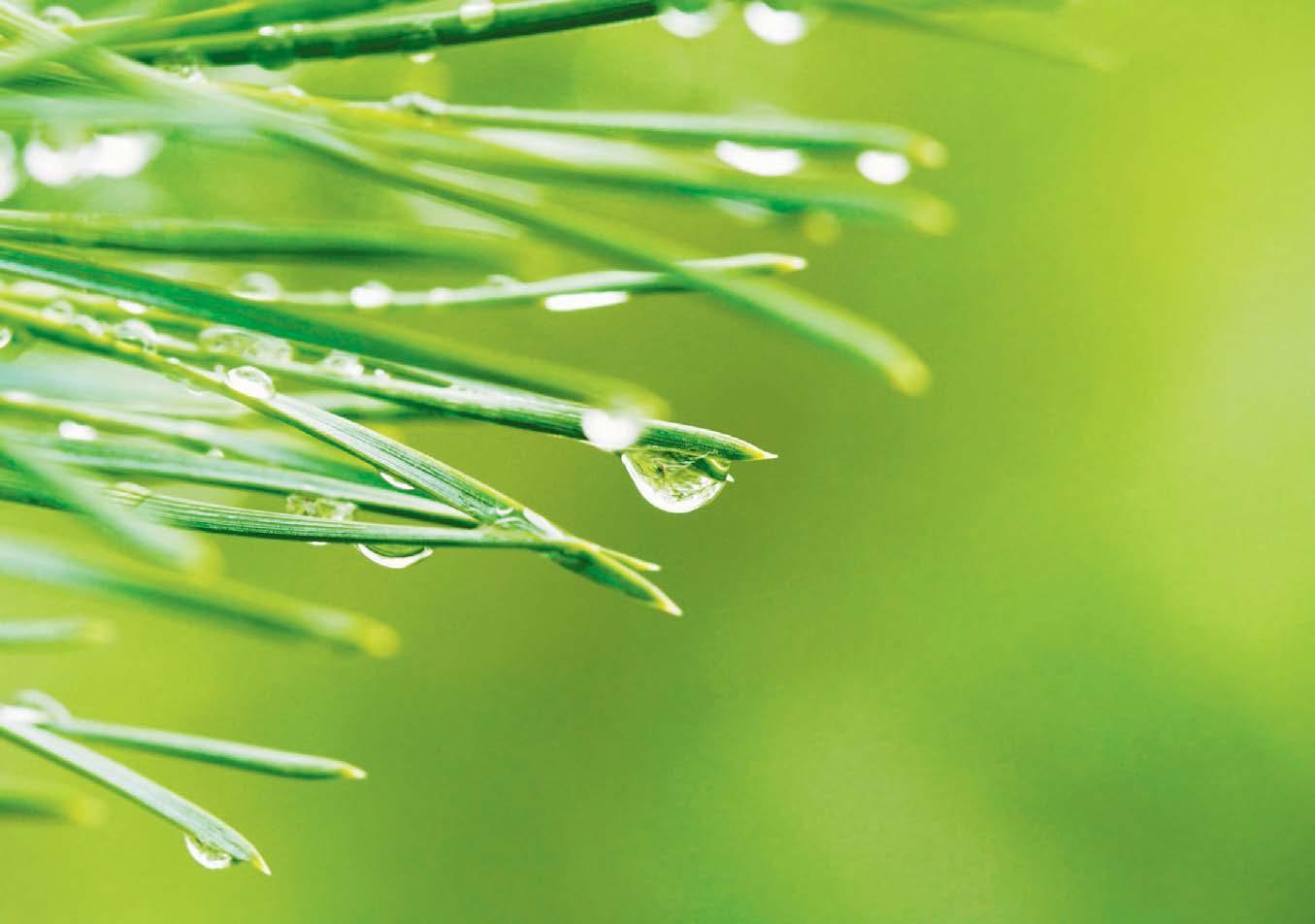


requirements, such as that all pre-fabrication spools are checked and a certificate is issued as part of the overall quality documentation of the finalised component.
Ultrasonic NDT solutions are also able to ensure the structural integrity of polypropylene and polyethylene pipe material by detecting impurities and air bubbles, which can cause the pipe to rupture over time or when pressurised.
GF Piping Systems National Service Manager Bruce Dyne said the most important thing NDT brings to a project is certainty.
“Our NDT service is giving asset owners long-term assurance that their joints and pipes are rock solid, which is critical when you’re dealing with something that’s going in the ground for decades,” Dyne told The Australian Pipeliner
While testing is most commonly done at the beginning of a project’s life, before the pipe goes underground, Dyne said it was not uncommon to test existing pipelines that have previously had a leak.
Traditional destructive testing methods entail cutting a weld out of the pipe, stresstesting it in a laboratory, and rewelding the joint.
“There are limitations to this method, the obvious being that these rewelds might not be up to the same standard as the test,” Dyne said.
“NDT testing eliminates this uncertainty, allowing asset owners to test as many joints as they want while also keeping the pipeline in one piece.”
This includes testing of the critical ‘golden weld’, which connects two existing pieces of piping and is notoriously difficult to test.
“The golden weld is the last weld in the chain that hasn’t been tested, because it’s the cut piece at the end,” Dyne said.
“You can’t pressure test or destructive test it – that weld must be tested by NDT.”
NDT is standard in steel pipeline projects, but Dyne said it’s almost unheard of in the plastic pipelines space.
“NDT for plastic pipelines is making projects much safer,” he said.
For more information, visit gfps.com/au/ndt

Pollard’s Sawdust Supplies has been a trusted national supplier of graded and bagged sawdust and wood shavings products for over 50 years. The pipeline construction industry has been entrusting our business to provide support for their pipe assets for many decades.
“It’s protection for everyone – the company, asset owner, contractor, all of us –because we’re minimising future issues with the pipeline and subsequent liabilities that could arise.
“By driving down these kinds of issues, we’re preventing environmental harm, outages in utility services, costly restoration works, and much more.
“A little preliminary work with NDT goes a long way in safeguarding time, money, and the environment.”
With over 25,000 NDT scans completed since GF Piping Systems first launched the service, there is clearly an appetite for this kind of peace of mind.
“Our NDT service has seen terrific traction across a range of industries,” Dyne said.
“We have large-scale semiconductor customers, nuclear power facilities, major water and gas authorities in Europe all buying into it.
“No system is infallible, but NDT gives you the best results you’re going to get.”

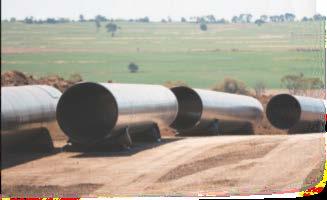
Our pipeline bedding Pack Tuff bags are:
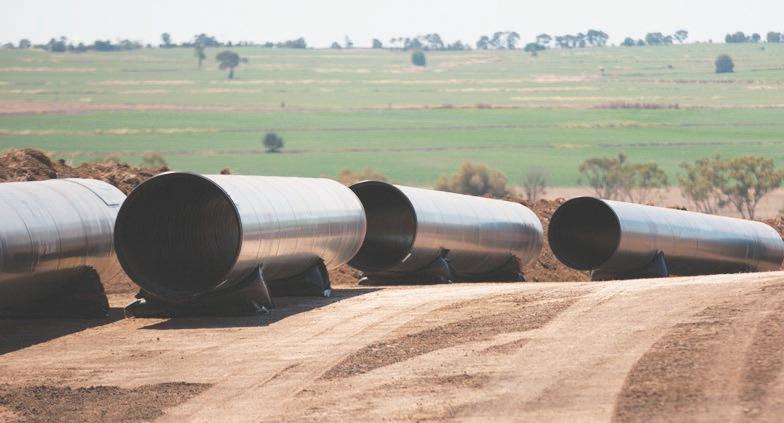
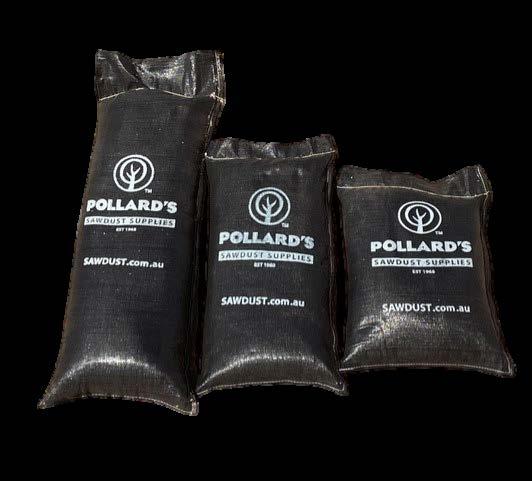





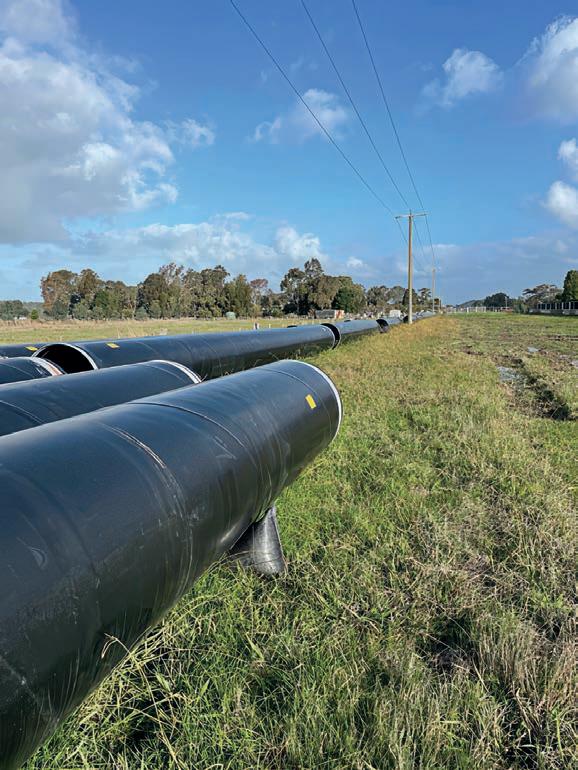
Pack Tuff bags are the perfect solution for safeguarding pipe assets as they are lightweight, yet hard-wearing and very resilient. The bags are the number one choice for protecting pipes by raising them up off the ground and maintaining stability. This makes them ideal for protecting pipes not only on-site, but also during transportation.
They are also suitable for medium to long term pipe storage in laydown yards.
Pollard’s Director Peter Brennan is adamant the Pack Tuff bags “can withstand a lot of hammering”and anything that comes its way.
“Companies choose our bags because they can take a great deal of rough handling and tossing about on job sites, yet will still be intact to enable reuse,” he said.
The bags are available in three convenient sizes to suit all diameters of pipes. The largest Pack Tuff bags are able to withstand up to 15 tonnes.
By comparison, hessian bags will deteriorate due to weather exposure and tear easily which will render them useless.
from an occupational health and safety perspective. Providing a flexible service, Pollard’s ship the Pack Tuff bags across Australia with pallets arriving on-site stretch-wrapped and weatherproof.
The bags have been used with great success and efficiency on numerous projects around the country involving companies such as McConnell Dowell, Steel Mains, MPC Kinetic, Spiecapag, John Holland, and Nacap. These projects include the Victorian Desalination Plant, Northern Gas Pipeline, Lake Way Gas Pipeline and currently the Fitzroy to Gladstone Pipeline in Queensland.
Alongside the Pack Tuff bags, the company also offers a diverse range of graded and bagged hard and softwood products across Australia, for a variety of industrial and commercial applications.
Pollard’s selection includes various chemical-free sawdust products suitable for multiple uses beyond pipe bedding, such as animal bedding, oil and chemical spill absorption, horticultural applications, and as a composite ingredient in numerous end products.





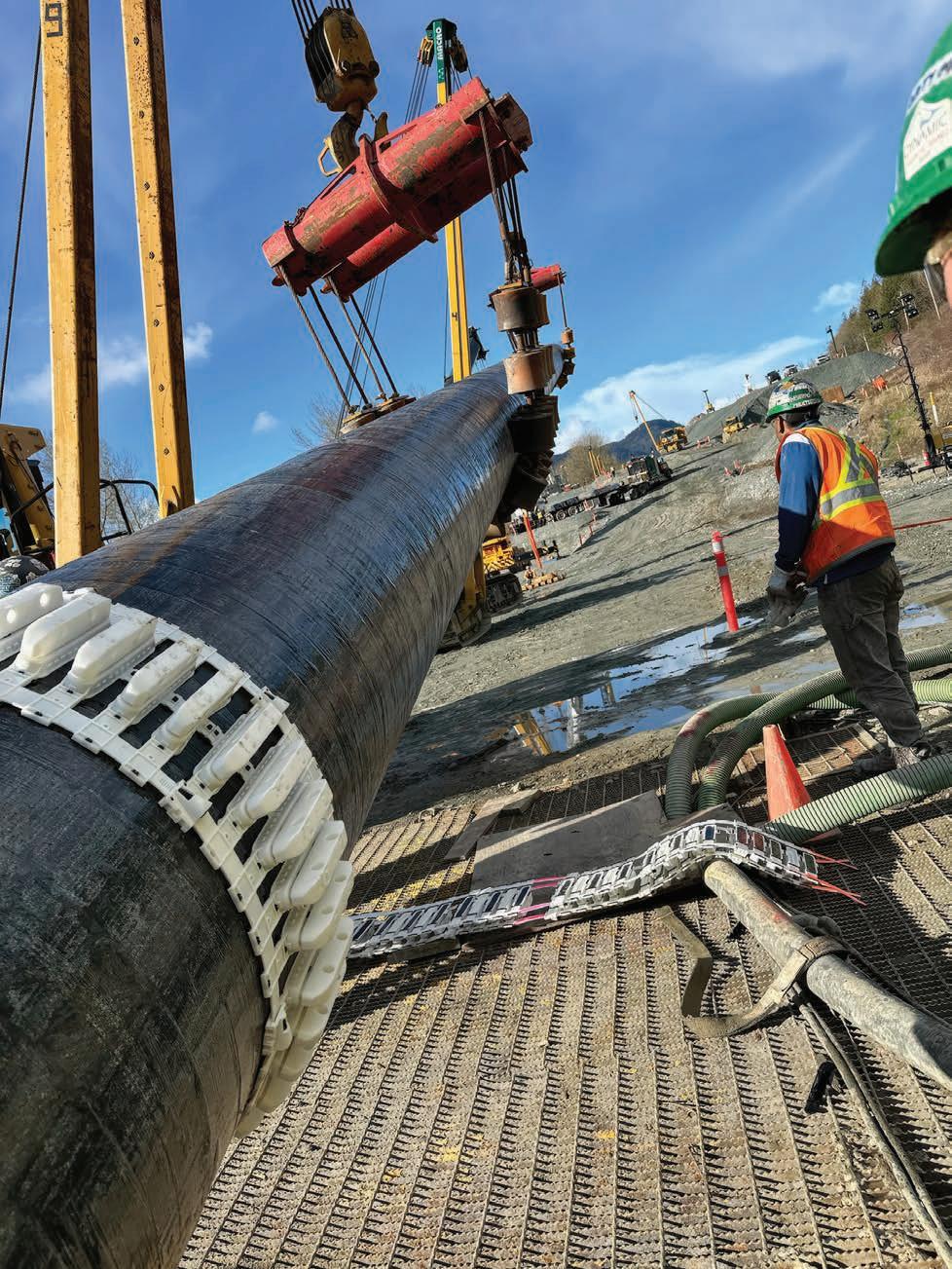
kwik-ZIP spacers have been utilised on Canada’s 1150km long Trans Mountain Pipeline Project.
Most North Americans are familiar with the Trans Mountain Pipeline Project, but perhaps in Australia it is less known.
The 1150km crude oil and refined petroleum pipeline was first laid in 1953, connecting land-locked Alberta to the coastline of British Columbia. Then in 2013, the Canadian National Energy Board
proposed a project to twin the pipeline, a move which would increase capacity from 300,000 to 890,000 barrels per day.
Referred to as the Trans Mountain Pipeline Expansion Project and almost 12 years in the making, the duplicated pipeline began commissioning in May 2024, enabling marine exports of crude oil and petroleum products around the world.
Suffice to say that the pipeline project was significant.
Projects of this scope often face challenges in proportion to their size, and the Trans Mountain pipeline was no exception.
Terrain was one of these challenges.
A contractor working on a horizontal directional drilling (HDD) section of the pipeline needed to protect two HDD pullback casing sections at the entry and exit points of each run.
However, the 15° slope upon which the entry and exit point of the pipe was located, as well as the extreme weight of the steel pipe, posed logistical challenges which the contractor had been unable to solve.
That’s where kwik-ZIP came in.
“Due to the angle of the slope, the contractor was concerned about potential damage to the casing and engaged kwikZIP to provide a specific solution to the scenario they were dealing with,” kwik-ZIP Managing Director Jason Linaker said.
The solution was to use multiple instances of kwik-ZIP’s HDXT-58W spacers installed at each end section of the 30-inch pipe.
kwik-ZIP’s HDXT series spacers have no metal parts and are made from the company’s engineered thermoplastic blend with high flexural strength, high temperature resistance, low co-efficient of friction, abrasion resistance and outstanding chemical resistance.
The design of these spacers allows heavy loads to be shared across multiple runners, reducing point loading and increasing the overall load capacity of the spacer.
Integrated rubber grip pads under collars also helps to prevent slippage.
However, due to the significant weight of the pipeline, kwik-ZIP installed its HDXT load inserts alongside the spacers for an extra layer of protection. When used in conjunction with HDXT spacers, these inserts can increase load capacity up to 1000kg per runner.
“HDXT load inserts are designed to be used with the kwik-ZIP HDXT casing spacers to provide additional load capacity for very heavy applications or where high point loadings on one runner are experienced,” Linaker said.
Luckily, high quality does not necessarily mean complex. Installation of kwik-ZIP spacers is simple and efficient, without the requirement of any special tools or setup equipment, nor is there any requirement to pre-wrap pipe.

certified as compliant with the Water Services Association of Australia’s product specification for casing spacers (WSA PS324), making them a staple in many Australian pipeline projects.
With its role in helping to deliver the Trans Mountain Pipeline Project, it seems recognition of kwik-ZIP’s high-quality products and thorough approach to service extends well beyond Australia.
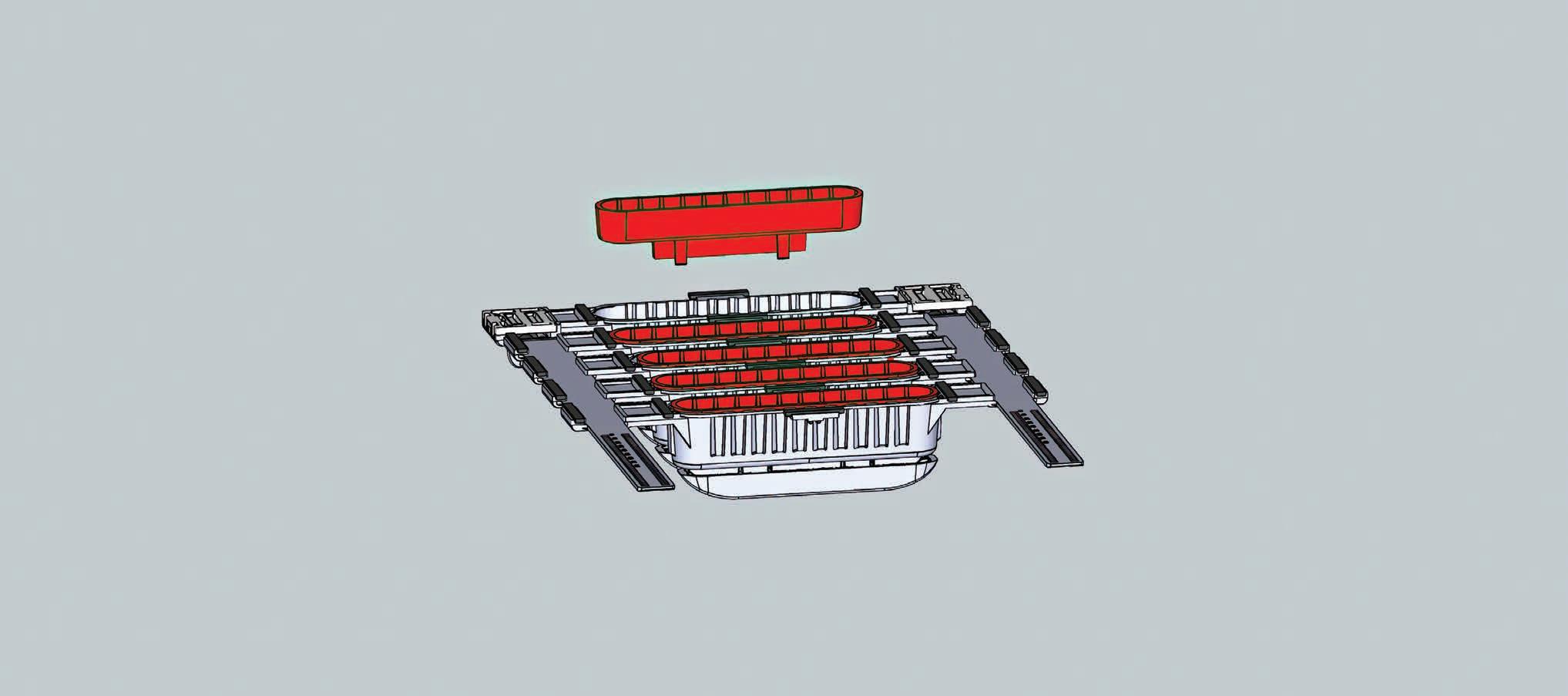
For more information visit kwikzip.com

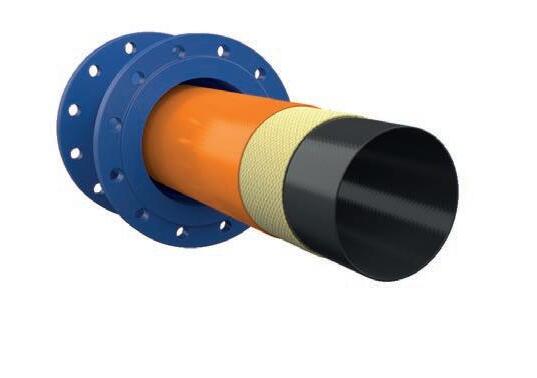


Inductabend has recently obtained Australian Made certifications for all of its induction bends.
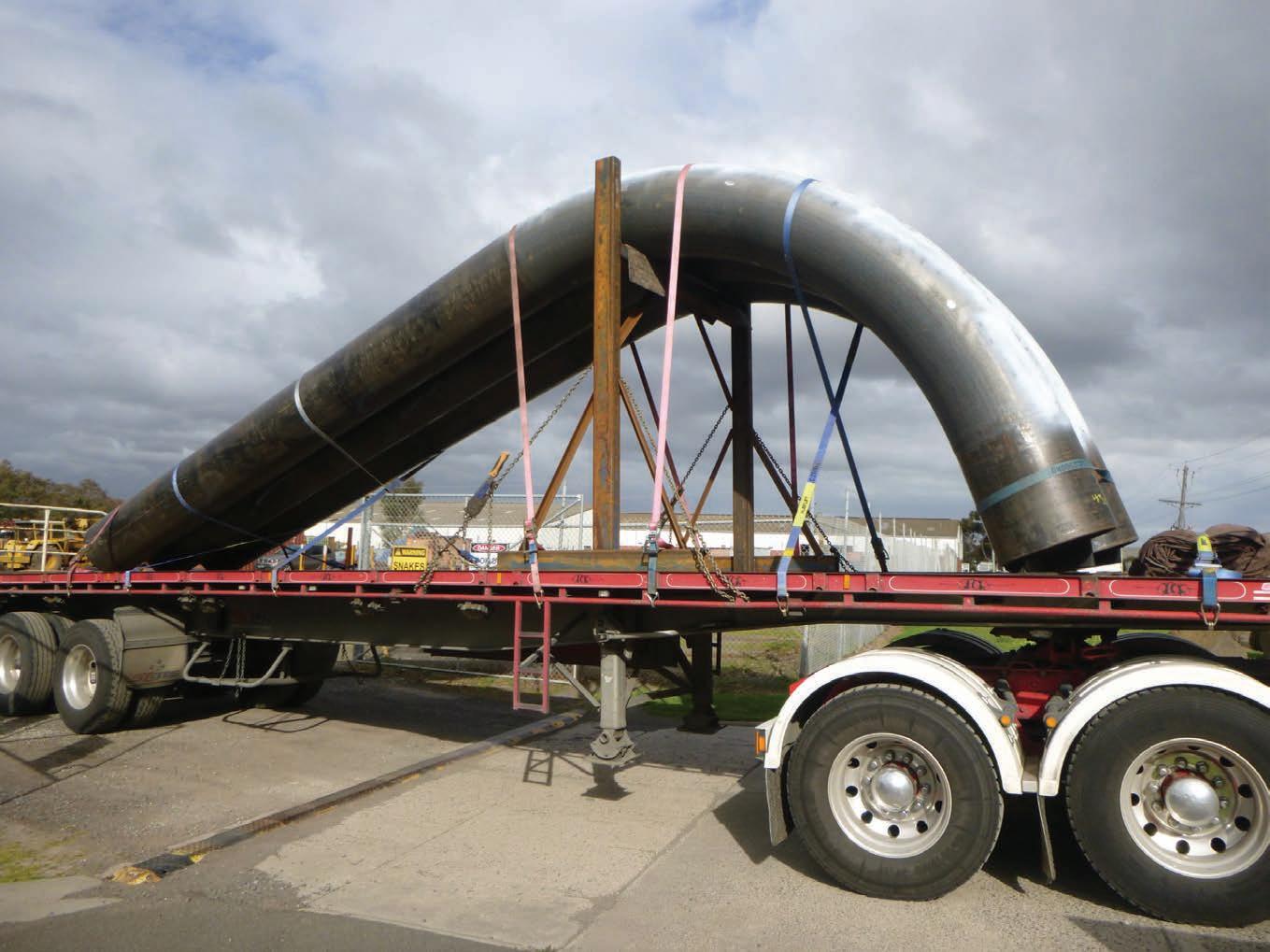
bending of pipe and other sections for the gas, mining and construction industries.
“We have always manufactured our bends in Melbourne, Australia, with the support of local industry and labour,” Inductabend Managing Director Barry Crouch said.
“Having been awarded with Australian Made certification is something we can be very proud of.
“Receiving certification is testament to our company’s commitment to supporting the local economy. In an era of global outsourcing, prioritising locally manufactured products helps
economic benefits stay within the community.
“By engaging with Australian manufacturers, clients can address some of their broader corporate social responsibilities, including commitments to health and safety as well as environmental sustainability that is governed by local regulations.”
Founded in 1991 by Barry Crouch and Rob Stead, the business has been servicing the mining, oil and gas, and building industries in Australia for over 30 years. Inductabend is still owned by its founding members to this day.
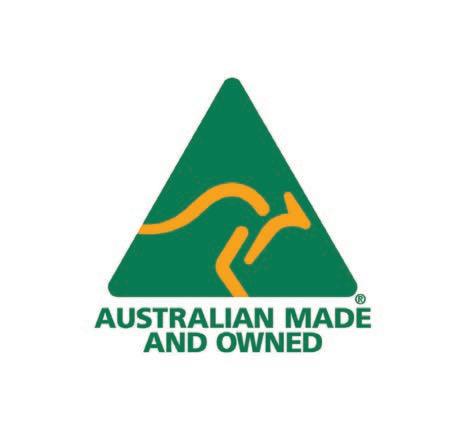
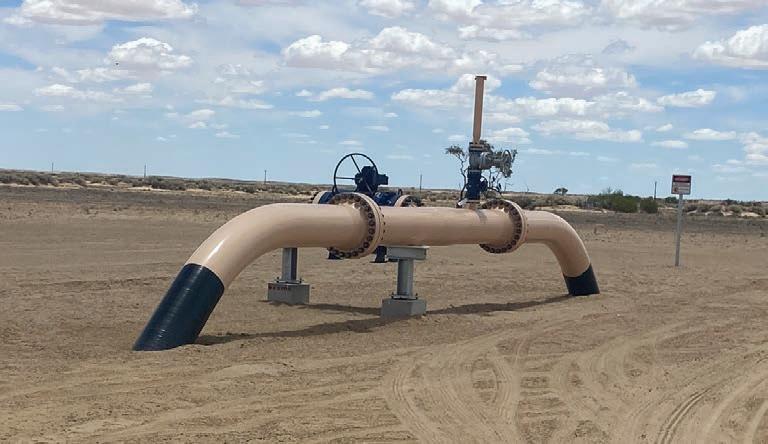
“We are proud to be manufacturing in Australia, supporting our local community. We hope with the Australian Made and Australian Owned certifications, our clients can trust that they will be supplied with high-quality, ethically produced induction bends that are playing a part in keeping manufacturing and expertise alive here in Australia,” Barry said.
Induction bending is a hot-bending process that has been specifically designed to produce highquality pipe bends that have mechanical properties equivalent to or exceeding those possessed by the mother pipe the bend has been produced from.
Inductabend has continued to develop and improve its capabilities, product offerings and


overall quality, which is a core value adding proposition for Australia’s industrial markets.
“We work with our clients to customise bending geometries and mechanical characteristics to their needs,” Barry said.
“In order to ensure consistent performance of our bends, we employ a wide range of destructive and non-destructive testing methods to create custom-testing programs tailored to a client’s particular pipeline application and risk profile.”
Inductabend owns and operates three induction-bending machines that cover a wide range of applications. Pipe diameters from DN25 to DN900, with wall thicknesses of up to 100mm, can be bent to a purchaser’s exact desired angle and radius (generally 2.5D and up), with custom tangent lengths on each end of the bend.
Complex compound spools can also be produced, including ‘S bends’, and even helical bends for specialist applications.
Induction bending is compatible with a wide range of materials, which include all carbon steels, high X-grade steels, stainless steels and other exotic alloys.
exceptional customer service.
maximum flexibility, with the ability to modify their orders right up until production begins.
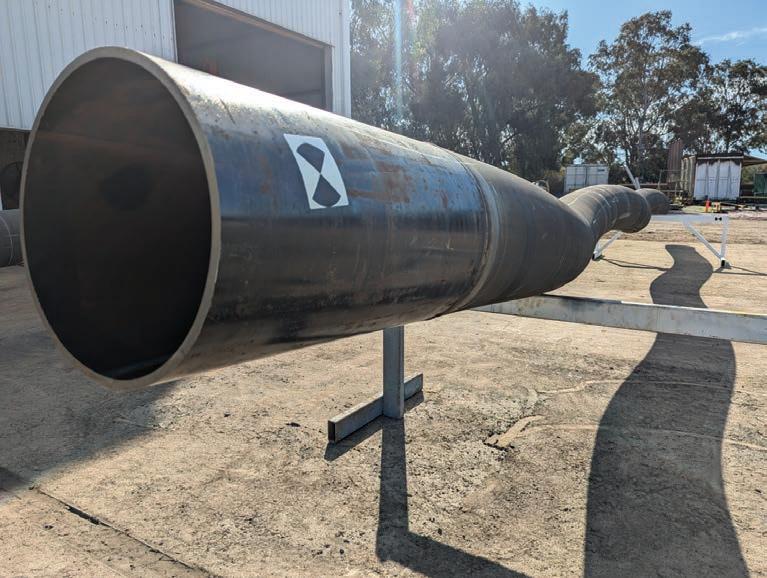
during construction and an additional bend(s) is required on short notice, the new bend can be manufactured within a week and sent to site, minimising costly project delays.
Production and/or deliveries for large projects
For more information, visit inductabend.com.

Induction bending is generally synonymous with pipe bending but it also has wide applications for high-quality bends in structural sections, such as CHS, RHS, SHS as well as UB, UC and PFC.

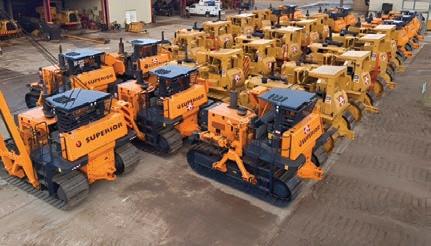
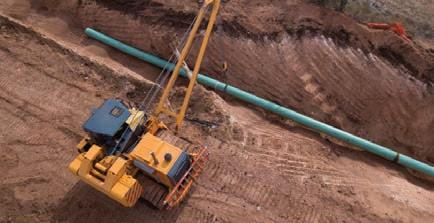
Explore our range of pipelayers, including premium SUPERIOR models and hydraulic-converted Caterpillar machines. We also offer conversion systems for mechanical pipelayers or dozers. All our equipment complies with regional regulations, featuring tier 3 or 4 engines, ROPS, and enhanced safety features. Scan QR code for the brochure!
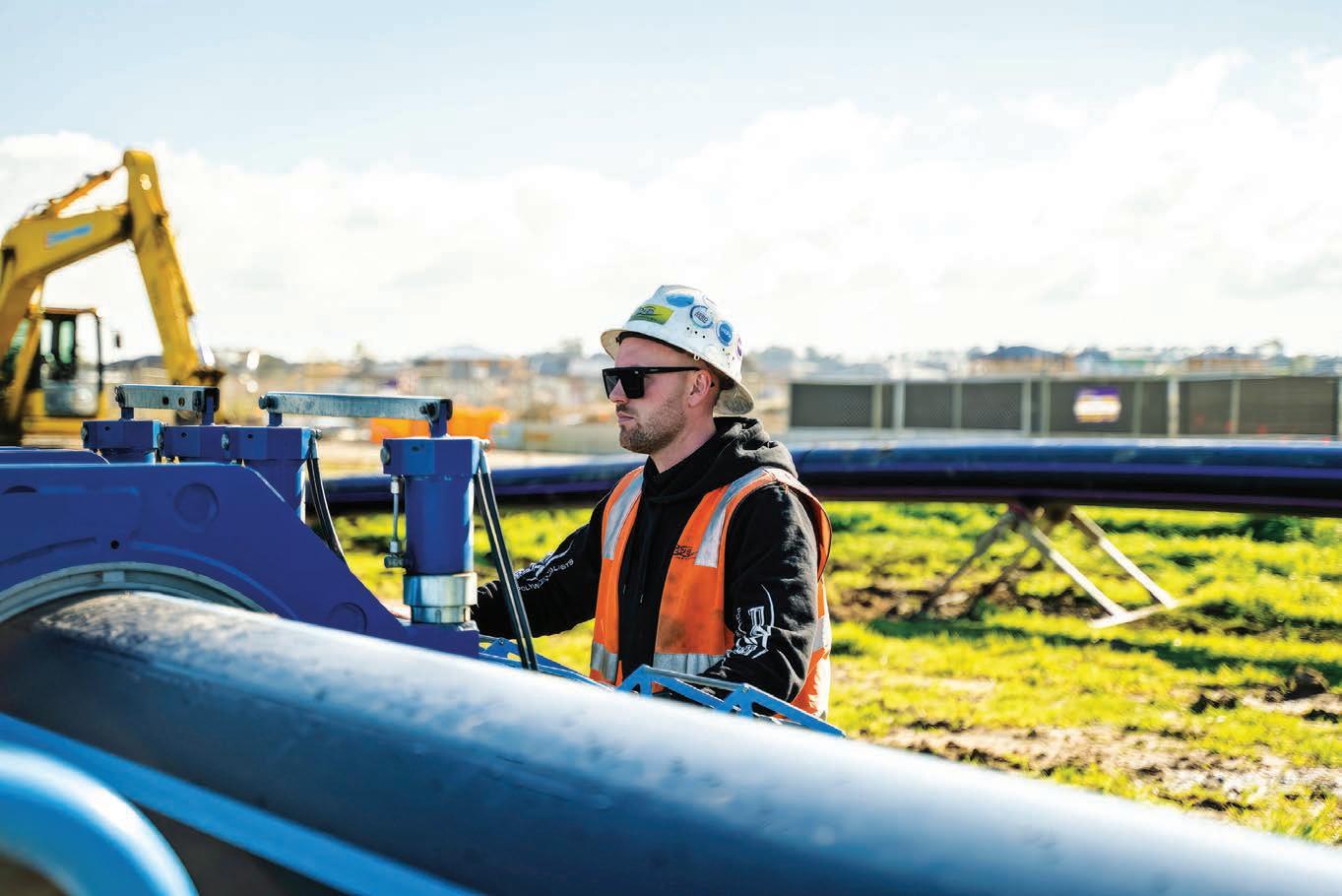
This is where Poly Welding Specialists (PWS), a specialist PE welding service provider, wins the reputation as a formidable force in the industry.
The journey of PWS began in 2013, with 21-year-old Troy Marshall, who, after losing his job, found himself at a crossroads.
Undeterred, he seized the opportunity to forge his own path, embarking on an entrepreneurial journey that would ultimately shape the course of his life.
Operating out of Marshall’s parents’ backyard shed, the fledgling enterprise slowly but surely began to gain traction, securing one job after another through sheer grit and a commitment to delivering exceptional workmanship.
Their big break came around seven years ago with rail work for level crossing removals in Melbourne – that’s kilometres of rail lines and tens of thousands of poly welds.
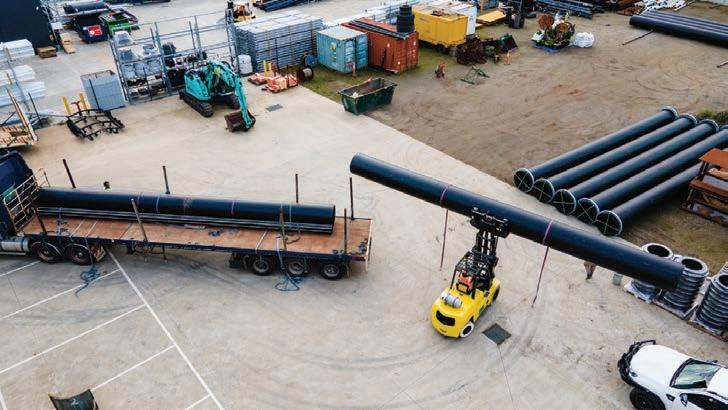
It was a pivotal moment that propelled PWS onto a trajectory of growth and success.
From there, it was one major project after another as their reputation grew. A massive 560mm water main in the south east Melbourne region and pipe work ranging from 1200mm down to 160mm for the Western Treatment Plant. They became one of the go-to poly welding solutions for top-tier contractors like Metro Trains.
Their jobs got bigger, and so did the company. Marshall and Van Soest moved from the backyard shed to their first 450 square foot factory.
PWS has leading talents and machines for every specific application.
But according to the duo, what truly sets PWS apart is its unwavering dedication to providing comprehensive, tailored solutions that address the unique challenges of each project.
“We’ve got the best talents and best machines for every specific application – we don’t use a massive overkill setup,” Marshall said.
“We can handle the whole process in-house from custom fabrication to final installation. That’s a big advantage over suppliers and contractors.”
With an A-team crew and an arsenal of specialty equipment, the pair are confident they can take on any complex and challenging poly welding projects across civil construction, water treatment, landfills, fire services and communications infrastructure.
Their fabrication workshop became a core strength, allowing them to make complex bends, fittings and bypasses on demand.
One of PWS’ biggest edges is controlling the entire supply chain through their sister company Mako Poly.
“We don't have to source anything externally


– we provide every fitting and material in-house for seamless end-to-end service,” Van Soest said.
PWS’ priorities of efficiency, customised solutions and eliminating inefficiencies for clients have been a huge hit.
“We make it easy for contractors. They focus on the main runs while we look after the specialised work,” Van Soest said.
Construction Manager Phil Pottage of HDD Drilling spoke highly about PWS.
“They provide a professional and quality service, and have always been able to fit us in and meet our timeframes,” he said.
Project Director Tom Mulhall of Delcon Civil also shared his praise for the company, stating: “PWS approaches each project with meticulous attention to detail. Their responsiveness and willingness to accommodate specific requirements demonstrate their commitment to tailored solutions”.
Delplant Civil’s James Collins highlighted PWS’ can-do attitude in the face of tough site conditions.
“A few years back we had a difficult tie-in on a 355mm pipe 3m deep that had to be done
quickly despite the rain. PWS worked right through it in a shielded hole and made sure the job got done perfectly,” he said.

parents’ shed, PWS has grown into one of Victoria’s top poly welding companies. But Marshall and Van Soest aren’t resting on their laurels.
“We’ve come a long way, but we’re not slowing
poly welding company across Australia,” Van Soest added.
“So the next step is to go Australia-wide by setting up branches in other states like South Australia and Queensland.”
For more information, visit polyweldingspecialists.com.au
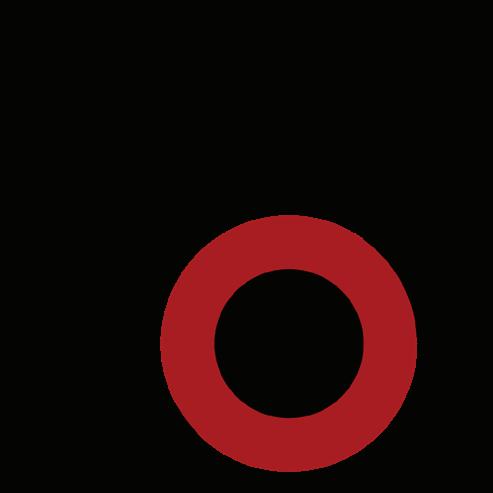
We specialise in applying our induction technology to solve seemingly intractable problems.
Induction bending of pipe up to DN900, wall thicknesses up to 100mm.
Carbon steels, stainless steels, clad pipe and other exotic alloys
High X grade bends
Compound bends
Helix bends
Custom OD mandrels

Structural steel section bending
Fully customizable bend geometry
Other specialist heating applications
Onsite induction bending (large diameter high volume projects)
Cold field bending machines also available for hire (up to DN1200)


When it comes to the demanding world of pipeline construction, Worldwide Machinery has customers covered with its impressive fleet of pipelayers.
Pipelayers are crucial in the construction of pipelines for crude oil, natural gas, and carbon capture projects. Capable of supporting heavy loads, these machines are indispensable for large-scale construction endeavours.
Worldwide Machinery, a leader in heavy construction equipment, stands out in the market with its range of pipelayers.
As specialised heavy-duty equipment, pipelayers feature a powerful chassis and a side-mounted arm that carries and lowers pipelines into place.
This design ensures that heavy pipes are laid safely and accurately, minimising the risk of errors. Powered by a diesel engine,

The company offers a diverse selection of pipelayers, including models from renowned manufacturers such as Superior Manufacturing and Caterpillar.
The Superior SPX-660, with its 60-tonne
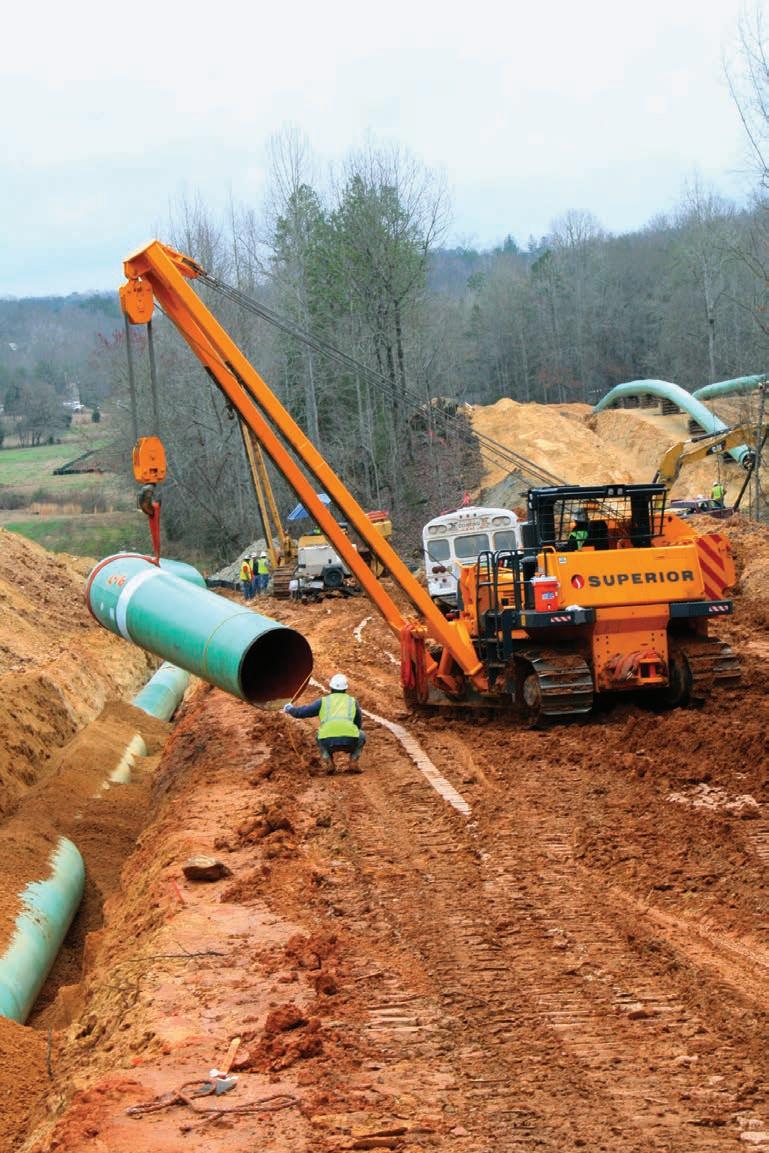
or purchase, from Worldwide Machinery, providing clients with a range of options to suit any specific needs.
Worldwide Machinery excels in its logistical capabilities such as shipping equipment across borders, ensuring timely and efficient delivery to any location.
This logistical prowess is complemented by its comprehensive on-site services, which includes equipment setup, maintenance, and repair. By providing these essential services, Worldwide Machinery ensures its clients’ projects run smoothly from start to finish.
In addition to these services, Worldwide Machinery offers both new and used pipelayers for sale or rent, providing tailored solutions for every business.
Renting pipelayer equipment is ideal for contractors or small businesses on a tight budget, as it eliminates the need for a large upfront investment. For businesses requiring long-term solutions, purchasing a pipelayer offers ownership and the flexibility to find exactly what they need.
Worldwide Machinery’s comprehensive fleet of pipelayers, combined with its exceptional logistical capabilities, makes it a leader in the construction equipment industry.
Whether renting or purchasing, clients can rely on Worldwide Machinery for highquality, efficient, and reliable pipelayer solutions.
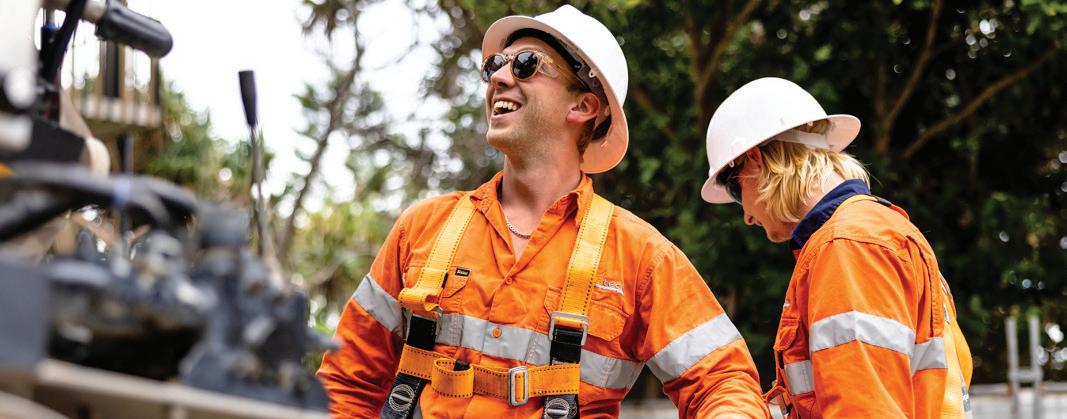
Abletech Underground is recognised as a trusted leader in providing industry solutions for a wide range of sectors and industry projects.
Abletech Underground brings a wealth of experience and capabilities to the energy sector, approaching each pipeline project with the utmost efficiency. We have the ability to mobilise Australia-wide, understanding individual site requirements. We ensure our clients’ needs are met while establishing long-term professional relationships founded on personalised service, reliability, and efficiency.
Abletech Underground has unmatched expertise gained from our extensive involvement with a multitude of challenging large-scale projects. Our highly skilled team, up-to-date industry accreditations, state-of-the-art equipment, industry leadership, ISO certifications, and attention to detail.


The Plastics Industry Pipe Association of Australia is putting a spotlight on how plastic pipe systems align with the key principles of the circular economy.
With Australia’s focus on transitioning from a linear to a circular economy, Plastics Industry Pipe Association of Australia (PIPA) recognises the importance of educating how plastic pipe systems align with the key principles of the circular economy.
This includes better use of resources, closed-looped resource flows and preventing waste and pollution through better design.
“When we talk about a circular economy, we are talking about an innovative model for rethinking our approach to products by design,” PIPA Executive General Manager Cindy Bray said.
“The aim is to ensure products are used efficiently and in use for as long as possible. Plastic pipe systems achieve this with their long life – from design, manufacturing, use, repair, re-use, recovery, and recyclability.”
The first phase of a circular economy is design and make. This covers efficient use of resources and prevention of waste and
pollution through better design and manufacturing processes.
The plastic material used to manufacture pipes is engineered to be robust, reliable, and recyclable. They are intended and designed to last a long time, more than 100 years. The engineered polymers used are stable materials. These properties suit a product such as pipes requiring long life expectancy.
Another part of the circular economy is to
design a product that can remain functional over its lifetime without requiring excess maintenance or repair when installed correctly under regular operation.
“For plastic pipes, it is intended that they can be installed and not require any maintenance or repair for decades, unlike other materials,” Bray said.
Plastic pipes withstand the forces to which they are subjected. They do not corrode and resist chemical attack.
At the end of their long service life, plastic pipe systems in buried infrastructure applications can be reused without removing them from under the ground.
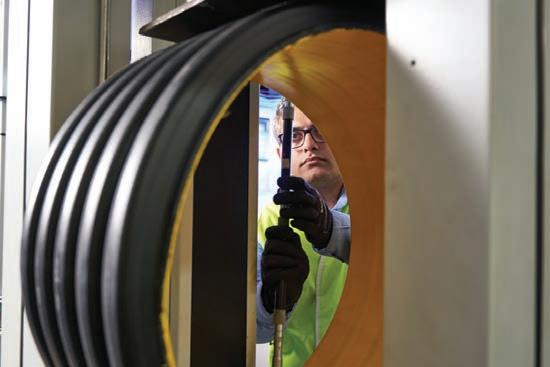
“These services are likely to become a host for a new plastic pipe,” Bray said.
“There is a strong focus on recycling, but reusing the pipe significantly reduces the use of energy and resources. It also reduces the environmental impact of digging up a pipeline after 100 years.”
Alongside the importance of products being circular, Australia is also focused on
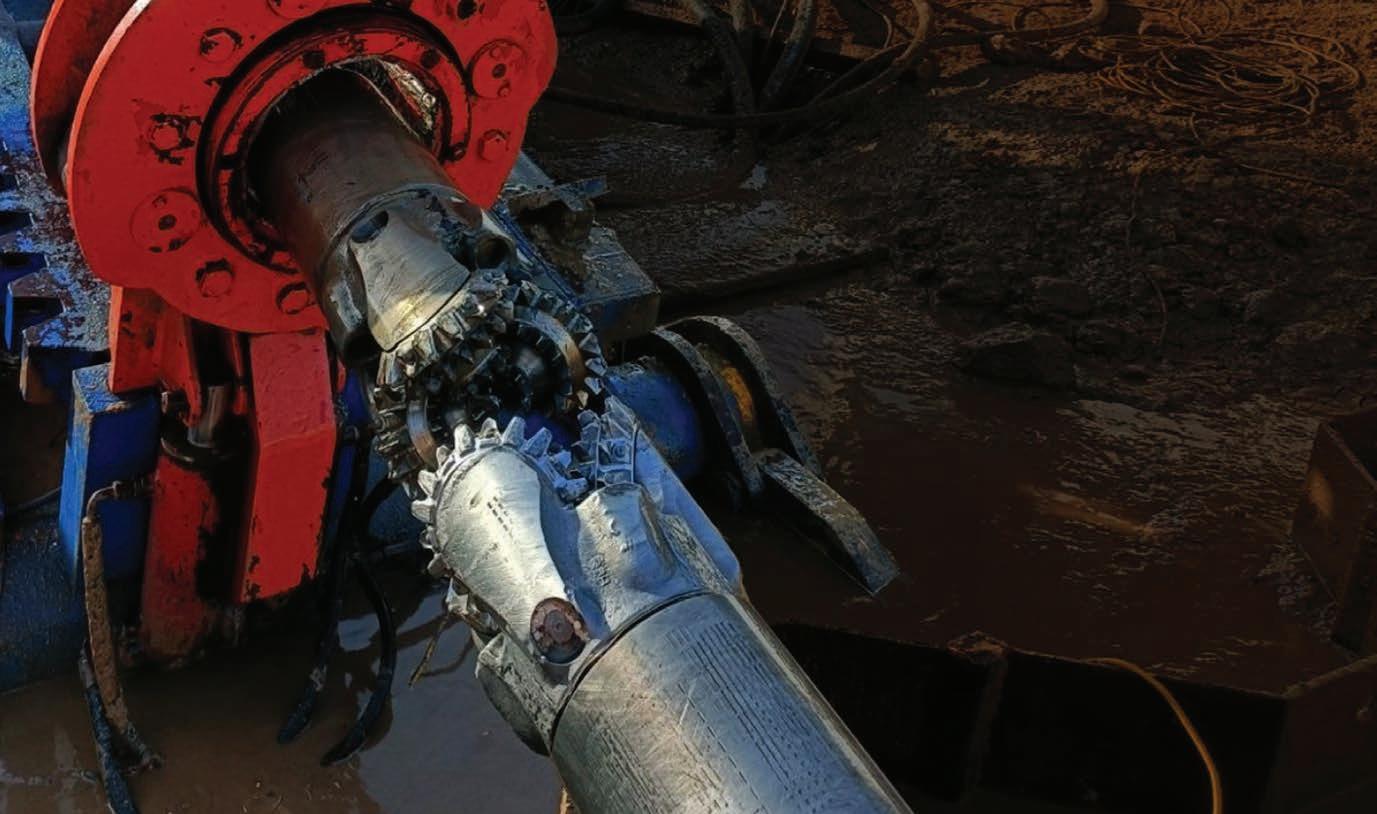
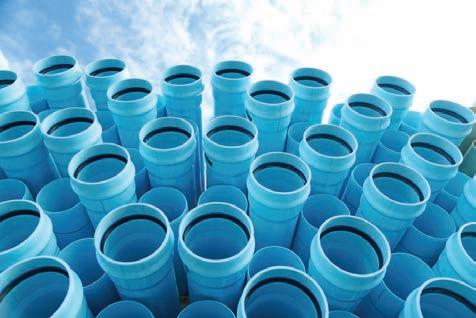
Plastic pipe systems are not only an engineered product designed to last a long time but are also use resources responsibly and sustainably.
reducing greenhouse gas emissions and other environmental impacts. When it comes to plastic pipe systems, the industry has been working on understanding the baseline and determining how carbon-intensive the systems are.
“The most reliable way to do this is through Environmental Product Declarations (EDPs),” Bray said.
“These are underpinned by a Life Cycle Assessment (LCA) and consider the whole life cycle of products or services compliant with the ISO standards.
“It looks at all areas of the lifecycle, including the origin of the raw materials, transportation, processing into production, distribution, installation and product use, maintenance, and end of life.”
Some PIPA members have published EPDs for their products. PIPA has worked with these manufacturers to establish an industry perspective on those aspects of the pipe’s lifecycle that are the same irrespective of manufacturer.
Bray said some people may be surprised that the production plants for manufacturing plastic pipes are relatively simple.
“No combustion or chemical reaction is required. As a result, no smoke or emissions are produced,” she said.
EPDs are helpful for manufacturers to benchmark their products. They also meet market demand for science-based,
For more information, visit ozpipe.com.au
transparent, verified environmental product information and data, supporting sustainable procurement.
“It is easy to see why plastic is the material choice for pipe and supports a circular economy in a closed-loop system,” Bray said.
“By using resources responsibility through better design, we are working smarter.”
Continuing with this theme, PIPA will be hosting Ozpipe 2024, which takes place on November 11 to 13 in Sydney.
Bearing the theme, “Sustainable Infrastructure – The Future is Now”, the conference showcases a range of technology papers presented by pipes experts from both Australia and around the world.
“If you are a manufacturer or supplier of plastic pipes and fittings, equipment or a specifier, engineer, designer or end user of plastic pipe systems, this is the conference for you,” Bray said.
“Not only will there be an extensive range of papers presented, but there is also the opportunity to view exhibitors and explore poster presentations.”

In this regular column, The Australian Pipeliner celebrates new appointments in Australia, New Zealand, Papua New Guinea, and the Pacific’s pipeline sector.
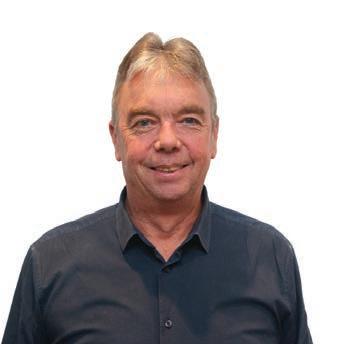
Blair Telfer has joined global multi-sector engineering design consultancy Mott MacDonald as Water Technical Director.
The company has a strong local presence in New Zealand, with over 330 staff which includes the full range of engineering, science and planning disciplines required for multidisciplinary water projects.
Within his role, Telfer provides technical inputs and guidance into projects, from

feasibility and investigation through detailed design to construction monitoring.
“The role also includes providing training, mentoring and support to the whole team, especially our graduates and those early in their professional careers – of course highlighting and promoting the value and benefits of trenchless technology,” he said.
Having previously worked for Mott MacDonald before leaving to pursue other opportunities, Telfer already appreciated the company’s work culture.
“When the opportunity to return and be
involved in some of New Zealand’s leading 3Waters projects presented, it ticked the boxes I was looking for in next stage of my career,” he said.
“I am looking forward to imparting my over 25 years of knowledge and experience, including my trenchless technology expertise, to our next generation of young engineers.
“I also hope to use my experience to strive toward achieving successful, high value projects outcomes and provide value back to the 3Water industry in New Zealand for future generations.”
Jarrod Irving has started his new role as General Manager – Renewable Gas and Fuels at LMS Energy and Helmont Energy.
LMS Energy, a pioneer in landfill gas-toenergy projects since 1986, has been at the forefront of Australia’s renewable energy landscape. The company has successfully developed more than 36 bioenergy projects across the country,

significantly contributing to the reduction of greenhouse gas emissions.
In his new position, Irving will spearhead efforts to further develop work across biogas to biomethane, sustainable aviation fuels, and biofuels.
Irving’s expertise in the field is bolstered by his previous roles at Australian Gas Infrastructure Group (AGIG) as Senior Advisor – Renewable Gas Development, and at Jemena, where he served in various capacities including Project Development
Manager – Renewable Gas (Zinfra).
“It’s been deeply rewarding to see the significant advances that have been made in the renewable gas sector in Australia, and I am grateful for the opportunities I have been given to grow both professionally and personally,” Irving said.
“I’m looking forward to continuing my work in the renewable gas and fuel space and collaborating with industry partners to drive the adoption of these innovative technologies.”
Zander Beard has taken up a new role as Team Leader of Construction Engineering at Knox City Council.
Zander will lead a team of technical staff to manage the delivery of multiple infrastructure renewal and upgrade programs that specifically require engineering oversight.
With roughly 15 years of experience in the design, delivery and management of civil engineering projects, Zander knows first-hand the benefits of trenchless technology.
“Most councils have ageing infrastructure
and an ever-increasing density of properties,” he said.
“As such, we’ve had to get creative in how we facilitate drainage asset renewals, as traditional open cut methods are becoming less viable.”
Zander said he has spent the last several years exploring internal patching and relining technology, to which Know City Council now attributes a significant portion of its annual budget.
“UV CIPP [ultra-violet cured in place pipe] lining is my first solution for renewal, and only if this cannot be achieved are other alternatives considered,” he said.
“With the costs of trenchless works becoming competitive – if not cheaper than traditional methods of drainage construction – I would say the time is now to ensure you get a grasp on the industry before you are left behind.”
Zander said he is eager to use his new position to help reshape the way in which councils traditionally deliver infrastructure projects.
“We have a unique opportunity right now to challenge how things have always been done,” he said.
“We can really unpack what we do, why we do it and, importantly for this industry, how we do it.”
If your company has recently employed a new person within your business you would like profiled in ‘People on the move’, send details of the career news alongside a high-res photo to Editor Timothy Bond at tim.bond@primecreative.com.au


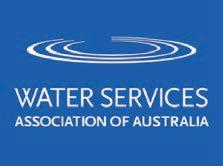

TECHNOLOGY SOLUTIONS FOR AUSTRALIA’S PIPELINE INSTALLATION.
SmartTEC Performance Software helps maximise machine performance by assisting operators with adjustments to machine controls during operation, and monitoring and recording machine performance, which can be analysed by the machine owner or fleet manager. Contact your local Vermeer Australia team to learn how we can support your project.

